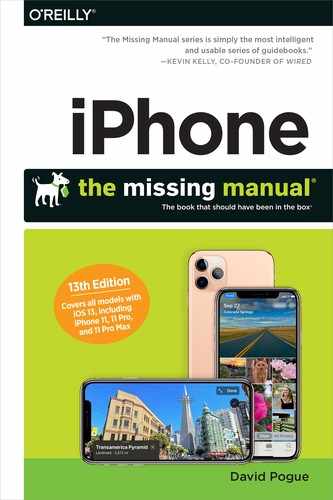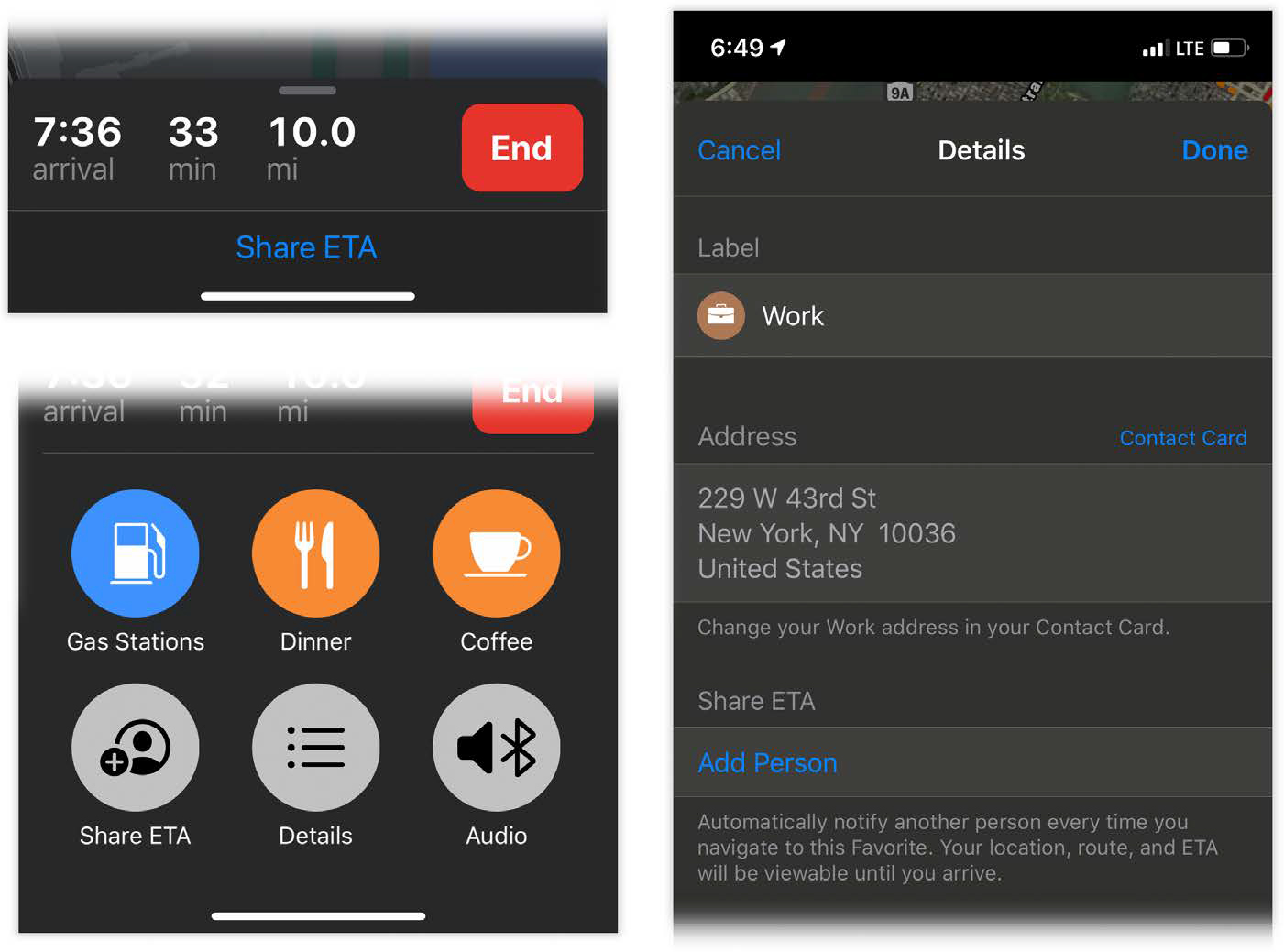Chapter 11. The Built-In Apps
Eventually, of course, you’ll fill your iPhone with apps you choose yourself, but Apple starts you off with about 25 essential ones. They include gateways to the internet (Safari), communications tools (Phone, Messages, Mail, Contacts), visual records of your life (Photos, Camera), shopping centers (iTunes Store, App Store), entertainment (Music), and so on.
Those core apps get special treatment in the other chapters. This chapter covers the secondary programs, in alphabetical order: Books (formerly iBooks), Calculator, Calendar, Clock, Compass, Files, Find My, Health, Home, Maps, Measure, News, Notes, Podcasts, Reminders, Stocks, Tips, Voice Memos, Wallet, Watch, and Weather.
TIP
You can open any of these apps by hunting it down and tapping its icon. But it’s usually much faster to tell Siri to do it. Say, “Open Compass,” for example.
Book
Books (formerly called iBooks) is Apple’s ebook reading program. It turns the iPhone into a sort of tiny Kindle. You can carry around dozens or hundreds of books in your pocket, which, in the pre-ebook days, would have drawn some funny looks in public.
Most people think of Books as a reader for books that Apple sells on its iTunes bookstore—best sellers and current fiction, for example—and it does that very well. But you can also load it up with your own PDF documents, as well as thousands of free, older, out-of-copyright books.
TIP
Books is very cool and all. But, in the interest of fairness, it’s worth noting that Amazon’s free Kindle app, and Barnes & Noble’s free B&N Nook app, are much the same thing—but offer bigger book libraries at lower prices.
Across the bottom of the app are five tabs; they’re as good a tour guide as any.
Reading Now
This tab prominently displays whatever book you’ve been reading most recently—and below that, a row of books you’ve been reading slightly less recently. The idea is to make it easier, if you’re reading multiple things at once, to get back into them.
Well, and also to sell you more books. Below those rows are suggestions of more books to buy, based on books you’ve already bought (or indicated, with the Suggest More Like This button, that you loved). Additional “books we’d love for you to buy” thumbnails appear even farther down.
Then, at the bottom: Reading Goals. In iOS 13, Apple is trying to encourage you to read more (and, of course, to buy more books) by gamifying the process. You can set goals for minutes a day and books a year—and then the app keeps track for you.
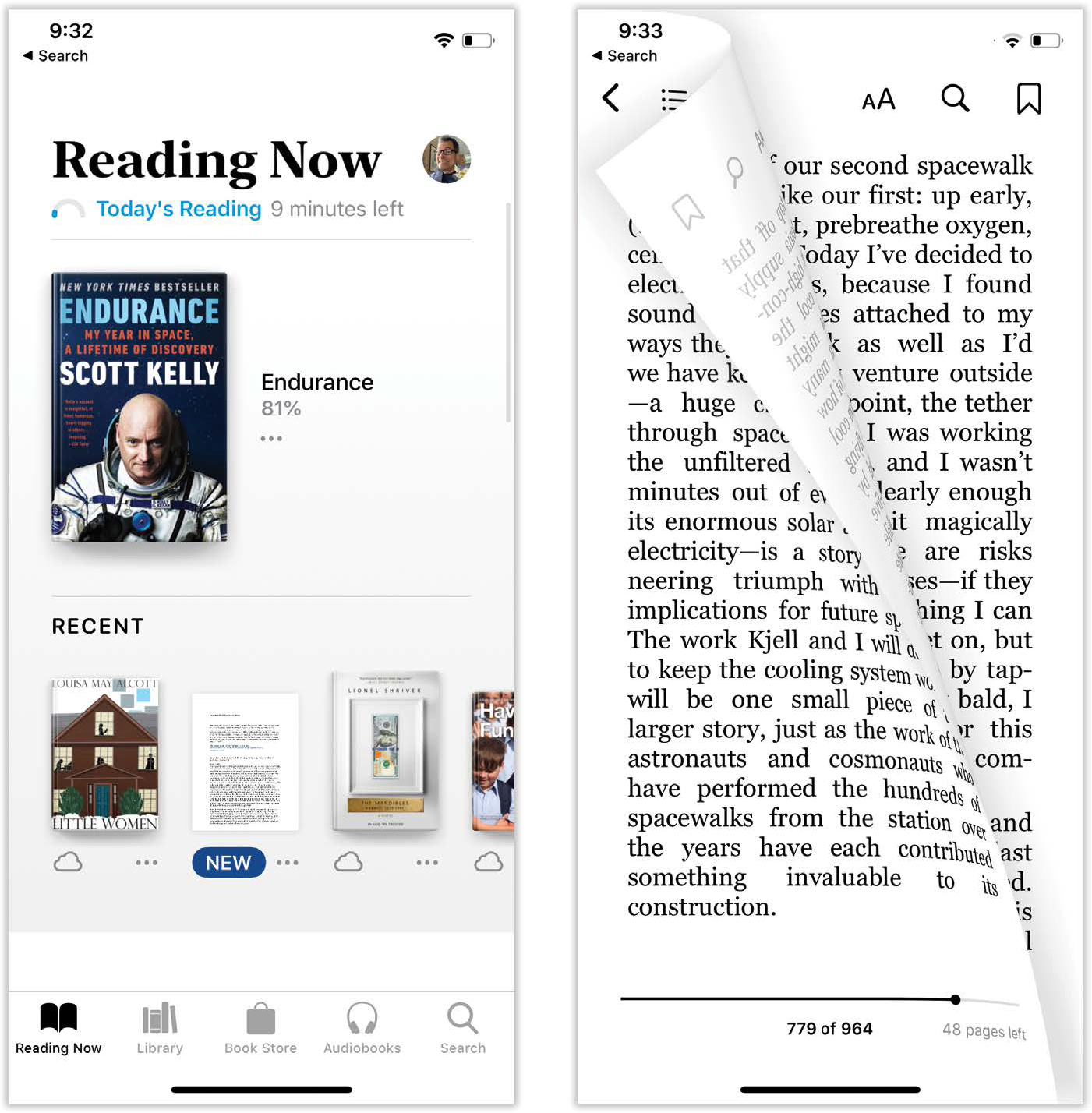
To see the minutes-a-day goal, tap the Today’s Reading timer and then Adjust Goal. To adjust the books-a-year goal, tap one of the book images under Books Read This Year.
Library
Once you’ve supplied Books with some reading material, the fun begins. The Library tab represents all your reading material as little book covers; books by the same author, or that are part of the same series, appear as little stacks of books.
NOTE
When you first start using a new iPhone, iPad, or Mac, your book covers bear the ![]() symbol. It means: “You’ve bought this book, but it’s still online. Tap to download it to your phone.”
symbol. It means: “You’ve bought this book, but it’s still online. Tap to download it to your phone.”
Mostly what you’ll do here is tap a book to open it. But there are other activities waiting for you:
Collections. You can create subfolders for your books called collections. You might have one for school and one for work, or one for you and one for somebody who shares your phone, for example. Categories of books can also be collections, like Finished, Want to Read, Audiobooks, PDFs, and so on.
To see what’s in a collection, tap it. (The Finished collection is especially cool—it shows the date you finished each book.)
To create a new collection, hit New Collection and type a name for it.
And to move a book into a different collection: On the Library tab, tap
 just below a book’s thumbnail to see the options; tap Add to Collection.
just below a book’s thumbnail to see the options; tap Add to Collection.TIP
You can reorganize your bookshelf in a collection. Long-press on a book until it swells with pride, and then drag it into a new spot.
Sort by Recent (what you’ve been reading lately), Title, Author, or Manually (drag them around with your finger—hold for a second before moving).
Switch to list view. Tap
 , which switches the book-cover view to a much more boring (but more compact) list view.
, which switches the book-cover view to a much more boring (but more compact) list view.Rename, Remove, Mark. There’s a whole menu’s worth of manipulations you can perform on a book. Tap
 just below a book’s thumbnail to see the options.
just below a book’s thumbnail to see the options.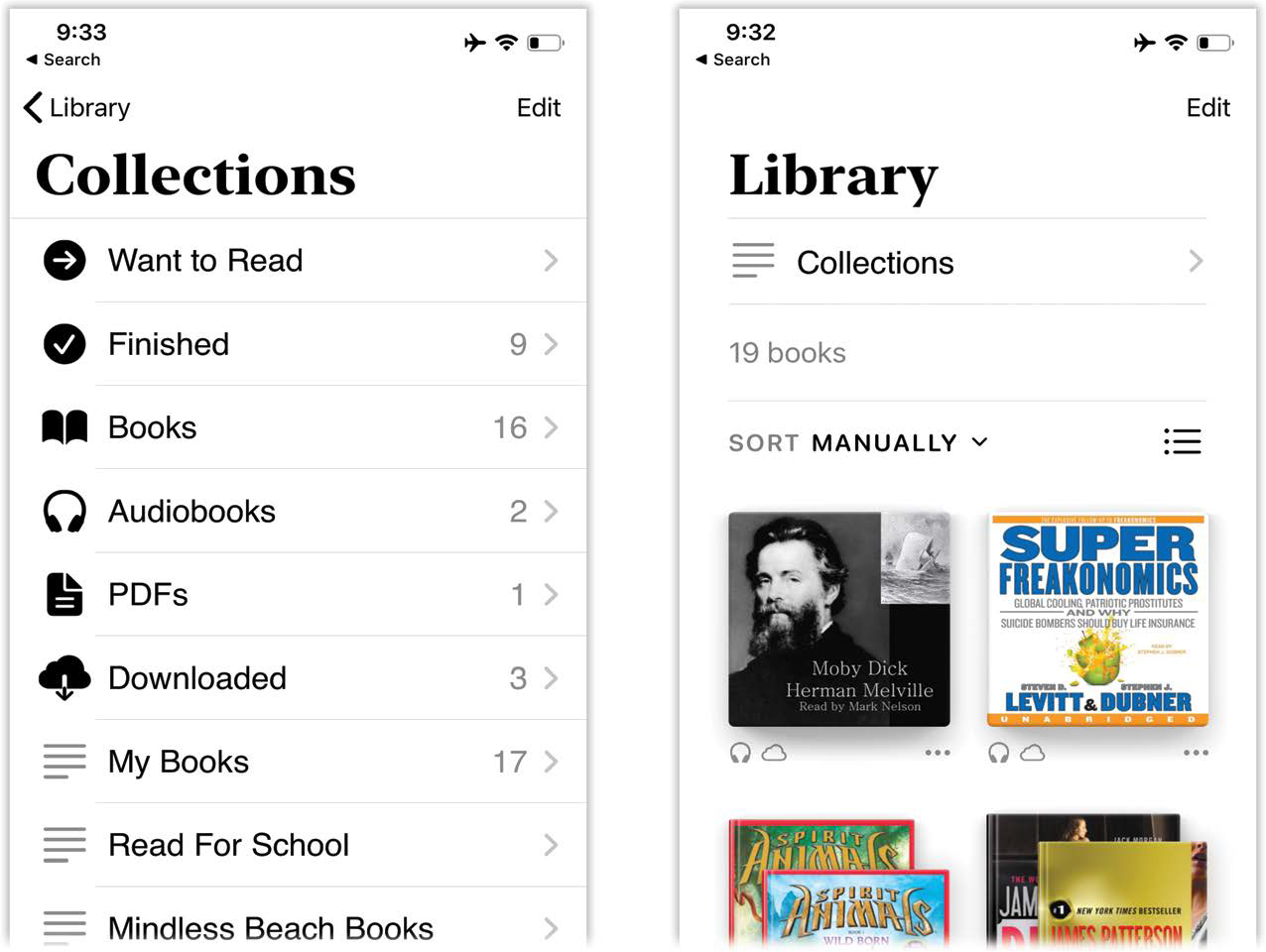
They may include Download (books you haven’t read in a while may be stored in your iCloud “locker,” ready for actual downloading to your phone), Remove (from the phone; you can always re-download it at no charge), Rename, Add to Want to Read (that is, a wish list), Add to Collection (read on), Mark as Finished, Share PDF (if it’s a PDF file), Share Book (send a link to buy it), Rate and Review, and Suggest More Like This or Suggest Less Like This.
Tap Edit if you want to delete a book, or a bunch of them. To do that, tap each book thumbnail you want to target for termination; observe how they sprout
 marks. Then tap
marks. Then tap  . Of course, deleting a book from the phone doesn’t delete your safety copy online.
. Of course, deleting a book from the phone doesn’t delete your safety copy online.
Book Store, Audiobooks, Search
These tabs are the literary equivalents of the App Store. Here are New & Trending books or audiobooks, Top Charts (this week’s best sellers, including what’s on The New York Times Best Sellers list), Books We Love (“We” being Apple), and so on. Scroll all the way down for the list of genres like Fiction, Mysteries, Romance, and so on.
Once you find a book that looks good, you can tap Sample to download a free chapter (or Preview to download a free audiobook teaser), read reviews, or tap Buy to download the book straight to the phone.
TIP
Once you’ve bought a book, you can download it again on other iPhones, iPod Touches, iPads, and Macs. Buy once, read many times.
PDFs and ePub Files
You can also load up your ebook reader from your computer, feeding it with PDF documents and ePub files.
NOTE
ePub is the normal Books format. It’s a very popular standard for ebook readers, Apple’s and otherwise. The only difference between the ePub documents you create and the ones Apple sells is that Apple’s are copy-protected.
Your Mac or PC is the most convenient loading dock for files bound for your iPhone. If you have a Mac, open the Books program. If not, open iTunes, click your iPhone’s icon at the top (when it’s connected), and then click Books.
Either way, you now see all the books, PDF documents, and ePub files you’ve slated for transfer. To add to this set, just drag files off your desktop and directly into this window.
And where are you supposed to get all these files? Well, PDFs are everywhere—people send them as attachments, and you can turn any document into a PDF file. (For example, on the Mac, in any program, choose File → Print; in the resulting dialog box, click PDF → Save as PDF.)
TIP
If you get a PDF document as an email attachment on the phone, adding it to Books is even easier. Tap the attachment to open it; now tap Open in Books in the corner of the page.
But free ebooks in ePub format are everywhere, too. There are 33,000 books at gutenberg.org, for example, and over a million at books.google.com—classic oldies, with lots of Mark Twain, Agatha Christie, Herman Melville, H.G. Wells, and so on. (Lots of these are available in the Free pages of Apple’s own Book Store, too.)
TIP
These freebie books usually come with generic covers. But once you’ve dragged them into iTunes on your computer, it’s easy to add good-looking ones. Use images.google.com to search for the book’s title. Right-click (or Control-click) the cover image in your web browser; from the shortcut menu, choose Copy Image. In iTunes, in Library mode, choose Books from the top-left pop-up menu. Right-click (or Control-click) the generic book; choose Get Info; click Artwork; and paste the cover you copied. Now that cover will sync over to the iPhone along with the book.
Once you’ve got books in iTunes, connect the iPhone, choose its name at top right, click the Books tab at top, and turn on the checkboxes of the books you want to transfer.
Reading
Open a book or PDF by tapping the book cover. The book opens, ready for you to read. Looks great, doesn’t it? (If you’re returning to a book you’ve been reading, Books remembers your place.)
If the phone detects that it’s nighttime (or just dark), the screen appears with white text against a black background. That’s to prevent the bright-white light of your phone from disturbing other people in, for example, the movie theater. (This is the Night theme, and you can turn it off.)
TIP
Turn the phone 90 degrees for a wider column of text.
In general, reading is simple: Just read. Turn the page by tapping the edge of the page—or swiping your finger across the page. (If you swipe slowly, you can actually see the “paper” bending over, as shown in “Reading Now”—in fact, you can see through to the “ink” on the other side of the page! Amaze your friends.) You can tap or swipe the left edge (to go back a page) or the right edge (to go forward).
TIP
This is rotation lock’s big moment. When you want to read lying down, you can prevent the text from rotating by locking the phone into portrait orientation (“Customizing the Control Center”).
But if you tap a page, a row of additional controls appears:
 takes you back to the bookshelf view.
takes you back to the bookshelf view. opens the table of contents. The chapter or page names are “live”—you can tap one to jump there.
opens the table of contents. The chapter or page names are “live”—you can tap one to jump there. lets you change the look of the page. For example, this panel offers a screen-brightness slider for the whole phone. (This is the same control you’d find in the Control Center or in Settings.)
lets you change the look of the page. For example, this panel offers a screen-brightness slider for the whole phone. (This is the same control you’d find in the Control Center or in Settings.)The
 and
and  buttons control the type size—a huge feature for people with tired or over-40 eyes. Tap the larger one repeatedly to enlarge the text; tap the smaller one to shrink it.
buttons control the type size—a huge feature for people with tired or over-40 eyes. Tap the larger one repeatedly to enlarge the text; tap the smaller one to shrink it.The same panel offers a Fonts button, where you can choose from eight typefaces for your book, as well as a Themes button, which lets you specify whether the page itself is White, Sepia (off-white), Dark Gray, or Night (black page, white text, for nighttime reading). And there’s an Auto-Night Theme button; if you don’t care for the white-on-black theme, then turn this switch off. Finally, there’s a Scrolling View switch. In scrolling view, you don’t turn book “pages.” Instead, the book scrolls vertically, as though printed on an infinite roll of Charmin.
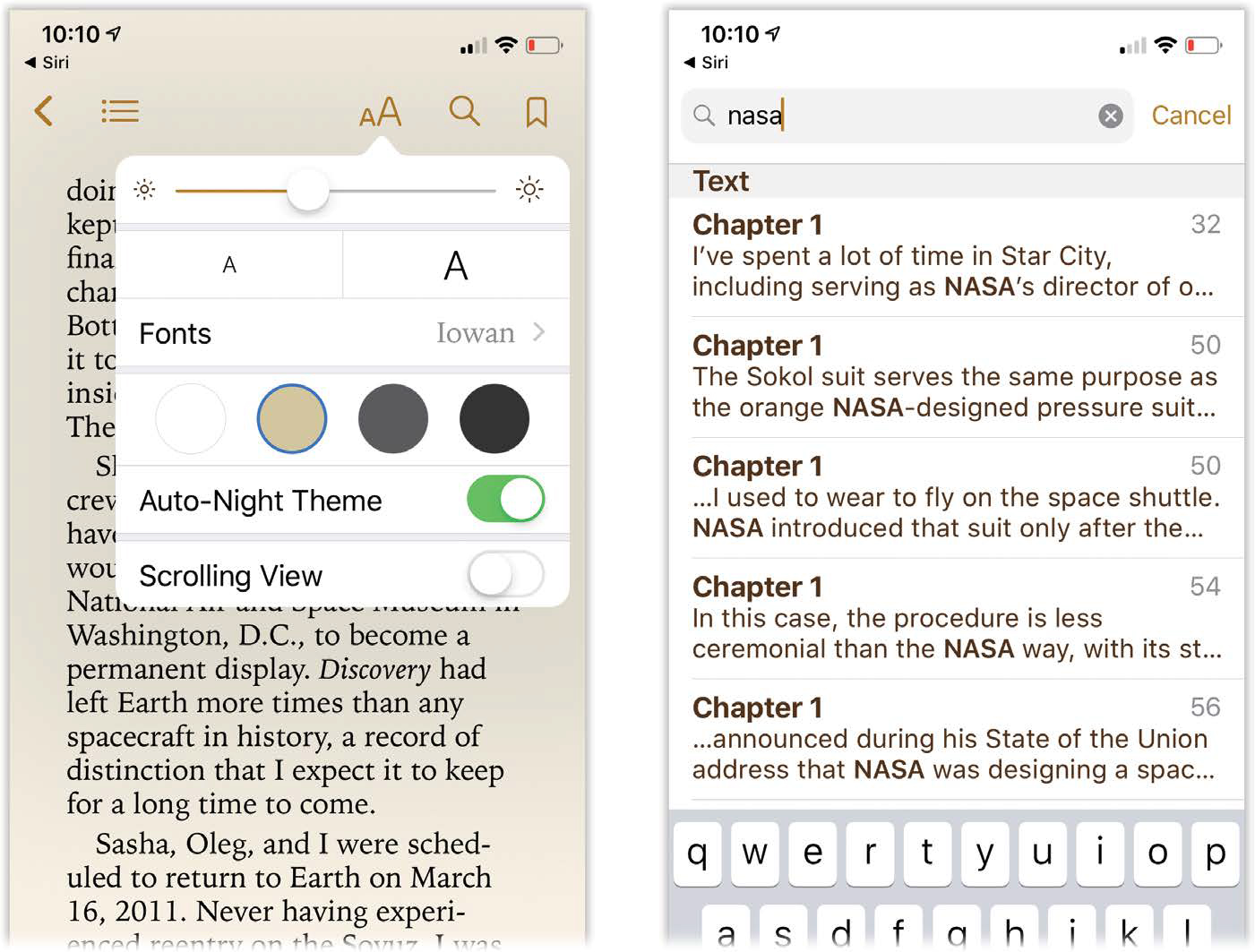
 lets you search for text within the book you’re reading, which can be extremely useful. As a bonus, there are also Search Web and Search Wikipedia buttons so you can hop online to learn more about something you’ve just read.
lets you search for text within the book you’re reading, which can be extremely useful. As a bonus, there are also Search Web and Search Wikipedia buttons so you can hop online to learn more about something you’ve just read. adds a bookmark to the current page. You can flag as many pages, for as many reasons, as you like.
adds a bookmark to the current page. You can flag as many pages, for as many reasons, as you like.Chapter slider. At the bottom of the screen, a slider represents the pages of your book. Tap or drag it to jump around in the book; as you drag, a pop-up indicator shows what chapter and page number you’re scrolling to. (If you’ve magnified the font size, of course, then your book consumes more pages.)
TIP
A Books ebook can include pictures and even videos. Double-tap a picture in a book to zoom in on it.
When you’re reading a PDF document, by the way, you can do something you can’t do when reading regular Books titles: zoom in and out using the usual two-finger pinch-and-spread gestures. Very handy indeed.
NOTE
On the other hand, here are some features that don’t work in PDF files (only in ebooks): font and type-size changes; page-turn animations; sepia, gray, or black backgrounds; and notes.
And if you want highlights, you’ll have to draw them on manually with the Markup tools (“Add a Sketch”).
Notes, Bookmarks, Highlighting, Dictionary
Here are some more stunts you’d have trouble pulling off in a printed book. If you hold your finger down on a word, you get a black editing bar (below, top) that offers these options:
Speak reads the highlighted passage aloud. (This button appears only if you’ve turned on Speak Selection in Settings → Accessibility → Spoken Content.) Thank you, Siri!
Copy. You can probably guess this one.
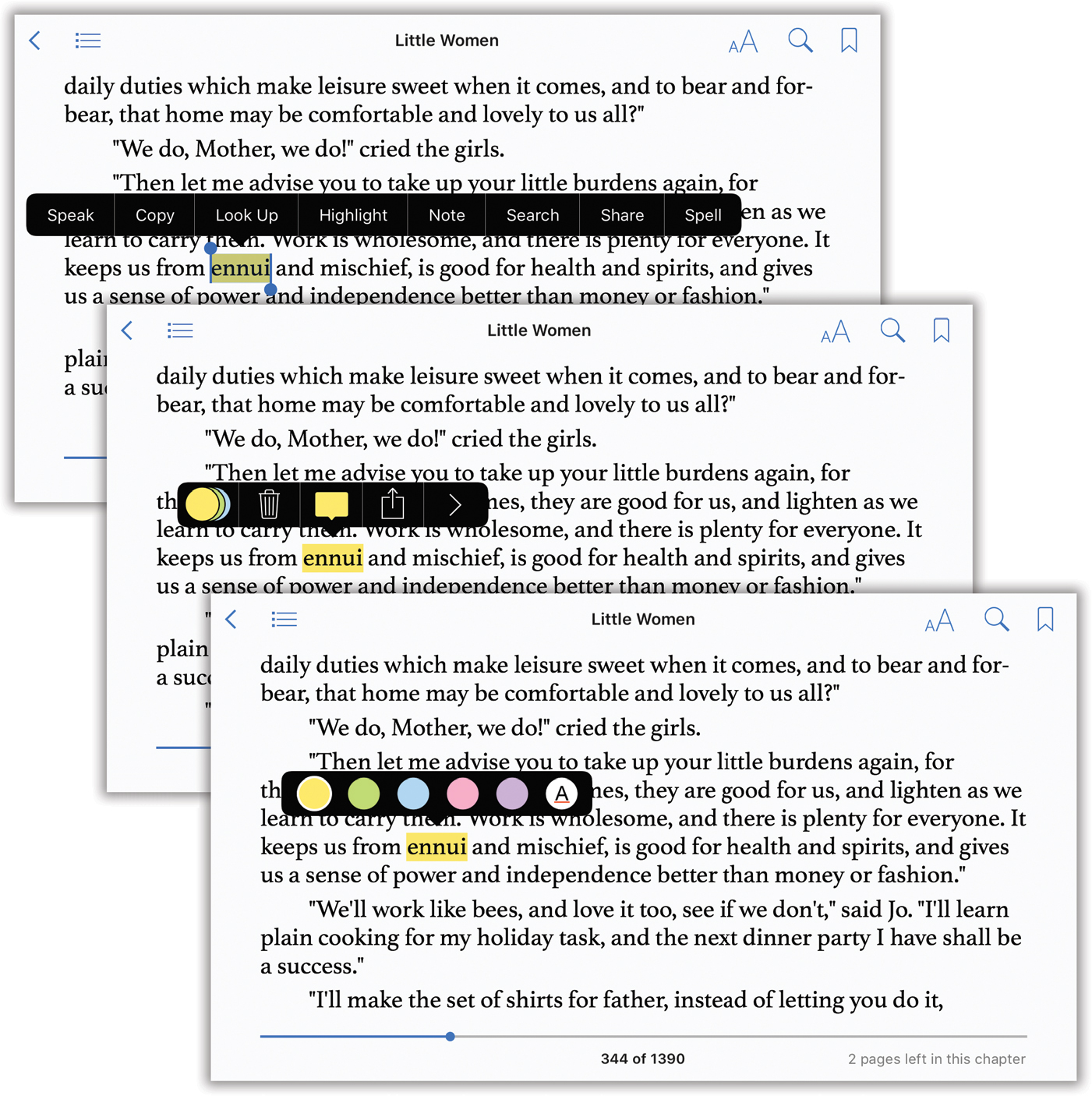
Look Up. Opens a page from Books’ built-in dictionary. You know—in the unlikely event you encounter a word you don’t know.
Highlight. Adds tinted, transparent highlighting, or underlining, to the word you tapped. For best results, don’t tap the Highlight button until you’ve first grabbed the blue-dot handles and dragged them to enclose the entire passage you want highlighted.
Once you tap Highlight, the buttons change into a special Highlight bar (facing page, middle). The first button (
 ) opens a third row of buttons (bottom), so you can specify which highlight color you want. (The final button in this row designates underlining.)
) opens a third row of buttons (bottom), so you can specify which highlight color you want. (The final button in this row designates underlining.)To remove highlighting, tap
 . The
. The  button adds a note, as described next. The
button adds a note, as described next. The  button opens the Share sheet, also described momentarily.
button opens the Share sheet, also described momentarily.Note (
 ) creates highlighting and opens an empty, colored sticky note so you can type in your own annotations. When you tap Done, your note collapses down to a tiny yellow Post-it peeking out from the right edge of the margin. Tap to reopen it.
) creates highlighting and opens an empty, colored sticky note so you can type in your own annotations. When you tap Done, your note collapses down to a tiny yellow Post-it peeking out from the right edge of the margin. Tap to reopen it.To delete a note, tap the highlighted text. Tap
 .
.Search opens the same search box you’d get by tapping the
 icon—except this time the highlighted word is already filled in, saving you a bit of typing.
icon—except this time the highlighted word is already filled in, saving you a bit of typing.Share opens the Share sheet (“The Share Sheet”) so you can send the highlighted material to somebody else, post it to Facebook or Twitter, or copy it to your Clipboard for pasting into another app.
NOTE
If you’ve highlighted a single word, and if you have Speak Selection turned on in Settings → Accessibility → Spoken Content, then there’s one more option: Spell. It spells the word aloud for you, one letter at a time.
There are a couple of cool things going on with your bookmarks, notes, and highlighting, by the way. Once you’ve added them to your book, they’re magically and wirelessly synced to any other copies of that book—on your other gadgets, like the iPad or iPod Touch, your other iPhones, or even Mac computers running OS X Mavericks or later. You can read the same material seamlessly on any of your devices.
Furthermore, if you tap the ![]() to open the Table of Contents, you’ll see the Bookmarks and Notes tabs. Each presents a tidy list of all your bookmarked pages, notes, and highlighted passages. You can tap
to open the Table of Contents, you’ll see the Bookmarks and Notes tabs. Each presents a tidy list of all your bookmarked pages, notes, and highlighted passages. You can tap ![]() (and then Share Notes) to print or email your notes, or tap one of the listings to jump to the relevant page.
(and then Share Notes) to print or email your notes, or tap one of the listings to jump to the relevant page.
Books That Read to You
Books can actually read to you! It’s a great feature when you’re driving or jogging, when someone’s learning to read, or when you’re having trouble falling asleep. There’s even a special control panel just for managing your free audiobook reader.
To get started, open Settings → Accessibility → Spoken Content. Turn on Speak Screen.
Now open a book in Books. Swipe down from the top of the page with two fingers to make the iPhone start reading the book to you, out loud, with a computer-generated—but fairly natural-sounding—voice. At the same time, a palette appears, offering the speech controls shown here.
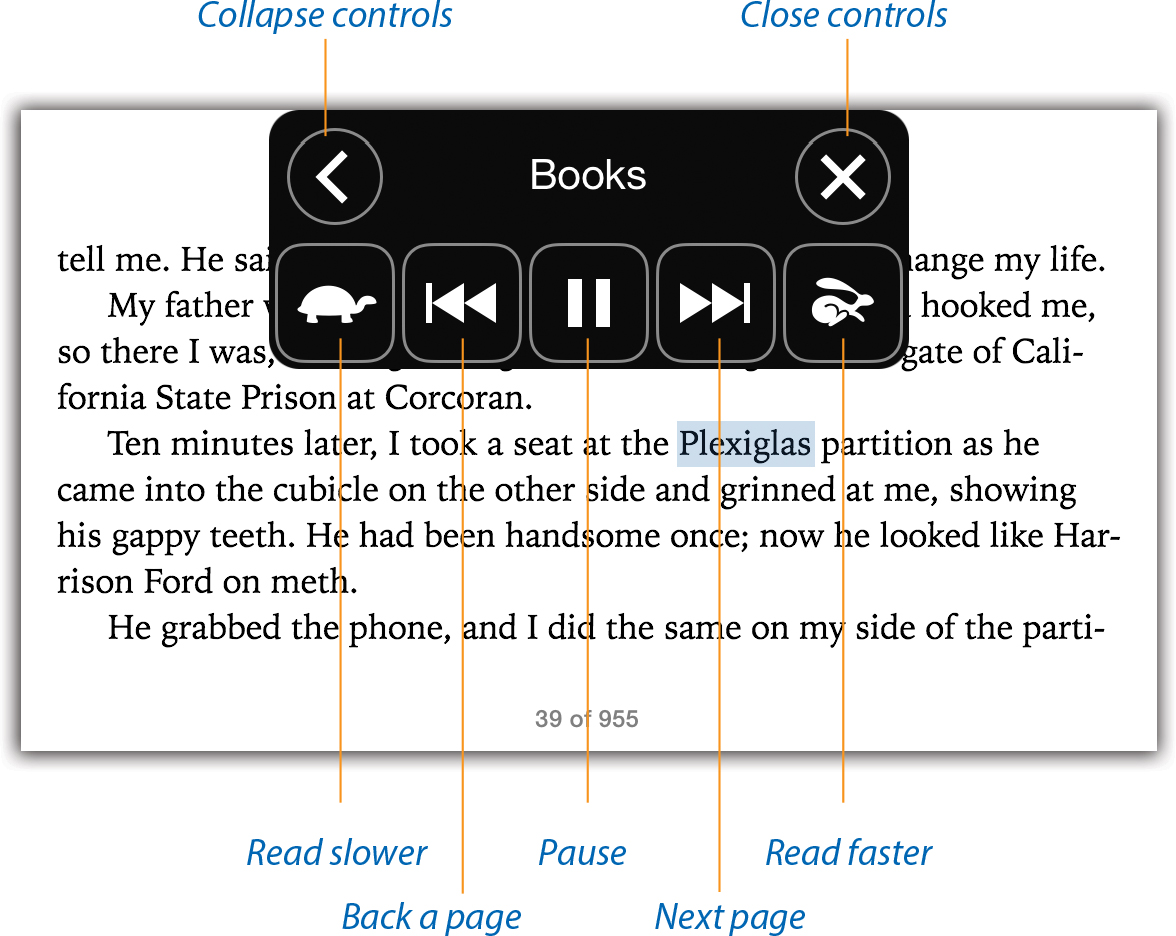
After a few seconds, the palette shrinks into a ![]() button at the edge of the screen—and, after that, it becomes transparent, as though trying to make itself as invisible as possible. You can, of course, tap it to reopen it.
button at the edge of the screen—and, after that, it becomes transparent, as though trying to make itself as invisible as possible. You can, of course, tap it to reopen it.
NOTE
Yes, this is exactly the feature that debuted in the Amazon Kindle and was then removed when publishers screamed bloody murder—but, somehow, so far, Apple has gotten away with it.
Books Settings
If you’ve embraced the simple joy of reading electronic books the size of a chalkboard eraser, then you deserve to know where to make settings changes: in Settings → Books. The options include the usual Siri & Search (Chapter 5); Notifications (“Notifications”); Background App Refresh (“A Word About Background Apps”); and Cellular Data (do you want Books to be able to download books over a cellular connection when you’re away from Wi-Fi?).
But here’s what else you’ll find:
Online Content. A few books contain links to video or audio clips online. This option comes set to Off, because video and audio can eat up your monthly cellular data allotment like a hungry teenager.
Update Other Devices. Tap to open a list of other Apple products you own that haven’t been updated to iOS 12 or macOS Mojave or later. Your Books library won’t sync to them until they’re up-to-date.
Reading Now. Do you want your choice of current reading material synced to other gadgets? (That’d be a big no if you like to read one book on your iPhone and a different one on your iPad.)
iCloud Drive. If you’ve added PDF files to your library (“Reading”), is it OK to use your precious iCloud Drive storage space (“iCloud Drive”) to make them available to all your Apple devices? If not, they won’t sync.
Full Justification. Ordinarily, Books presents text with fully justified margins (even margins on both sides—an effect created by adding tiny bits of space between the words on each line). Turn this off if you prefer ragged-right margins (uneven on the right margin).
Auto-hyphenation. Sometimes, typesetting looks better if hyphens allow partial words to appear at the right edge of each line. Especially if you’ve also turned on Full Justification.
Both Margins Advance. Usually, tapping the right edge of the screen turns to the next page, and tapping the left edge turns back a page. If you turn on this option, then tapping either edge of the screen opens the next page. That can be nice if you’re a lefty, for example.
Reading Goals turns on or off that whole goal business (“Reading Now”). Include PDFs counts the time reading PDF documents toward your goal. And why not?
Book Store. Turn this off if you want the Search tab to search only the books you already own.
Skip Forward, Skip Back. The little jump back/jump forward buttons that appear when you’re listening to an audiobook: How many seconds should they skip?
External Controls. If you’re listening to an audiobook in your car or with earbuds, what should happen when you press the
 or
or  buttons or controls? Should playback jump to the Next/Previous chapter, or just Skip Forward/Back 15 seconds (or whatever interval you set)?
buttons or controls? Should playback jump to the Next/Previous chapter, or just Skip Forward/Back 15 seconds (or whatever interval you set)?Reset Identifier. Apple collects data about what books people are reading. But it doesn’t know you as you; it considers you to be user 195827349205. That’s your Identifier. You can throw Apple off your scent at any time, though, by resetting your Identifier, so your data seems to come from a whole new person.
Calculator
In Calculator’s basic four-function mode, you can tap out equations (like 15.4 × 300 =) to see the answer at the top. (You can paste things you’ve copied into here, too; just hold your finger down until the Paste button appears.) There’s no memory function in the basic calculator, but you do get a +/– button; its function is to change the currently displayed number from positive to negative, or vice versa.

TIP
When you tap one of the operators (like ×, +, –, or ÷) it turns from orange to white to help you remember which operation is in progress. Let’s see an ordinary calculator do that!
Now here’s the twist: If you rotate the iPhone 90 degrees in either direction, the Calculator morphs into a full-blown HP scientific calculator, complete with trigonometry, logarithmic functions, a memory function, exponents, and roots beyond the square root. Go wild, ye engineers and physicists!
If you make a mistake while entering a number, swipe horizontally across the numerical display (either direction). Each swipe backspaces over the rightmost digit. And if you mistakenly touch the wrong operator (× when you meant –, for example), there’s no need to start over. Just tap the correct operator before tapping the number. The app ignores the errant tap.
TIP
You can use the Calculator instantly, at any time, even without waking or unlocking the phone—from the Control Center (“Control Center”). And you can make a calculation without opening the Calculator app at all—by asking Siri to do it for you (“Non-Apple Apps”).
Calendar
The iPhone’s calendar syncs, automatically and wirelessly, with whatever online calendar you keep: iCloud, Google Calendar, a corporate Exchange calendar, and so on. Everything is kept in sync with your computers and tablets, too. Make a change in one place, and it changes everywhere else. Then again, you can also use Calendar all by itself.
NOTE
The Calendar icon on the Home screen shows what looks like one of those paper Page-a-Day calendar pads. But if you look closely, you’ll see a sweet touch: It actually shows today’s day and date.
Day View
When you open Calendar, you see today’s schedule, broken down by time slot (next page, right). You can navigate to other days’ schedules in any of three ways: Swipe horizontally across the Day screen to see the previous or next day. Tap a date at the top to see another day this week. Swipe across the dates at the top to jump to another week. If the date you want to check is further away than a week or two, though, it might make more sense to pop into Month view, described next.

Month View
Month view, of course, shows an entire month at a glance (above, center). You can scroll the months vertically, thereby scanning the entire year in a few seconds. To get there from Day view, tap the name of the month at the top left.
Of course, your little phone screen is too small to show you what’s written on each calendar square; all you get is a gray dot on any date when you’ve scheduled an appointment. Tap that dot to jump back into Day view and read your schedule.
Year View
If you’re in Month view, you can “zoom out” yet another level—to Year view (above, left). It’s a simple, vertically scrolling map of the year’s months. Tap the name of the year to see it. From there, tap a month block to open it back into Month view.
TIP
In all three of these views—Day, Month, Year—you can tap Today (bottom left) to return to today’s date.
The Rotated Calendar
Some cool things happen when you turn the phone into landscape view (below, top). You get an interactive slice of the week: Swipe sideways to move to earlier or later dates. Swipe up or down to move through the hours of the day.
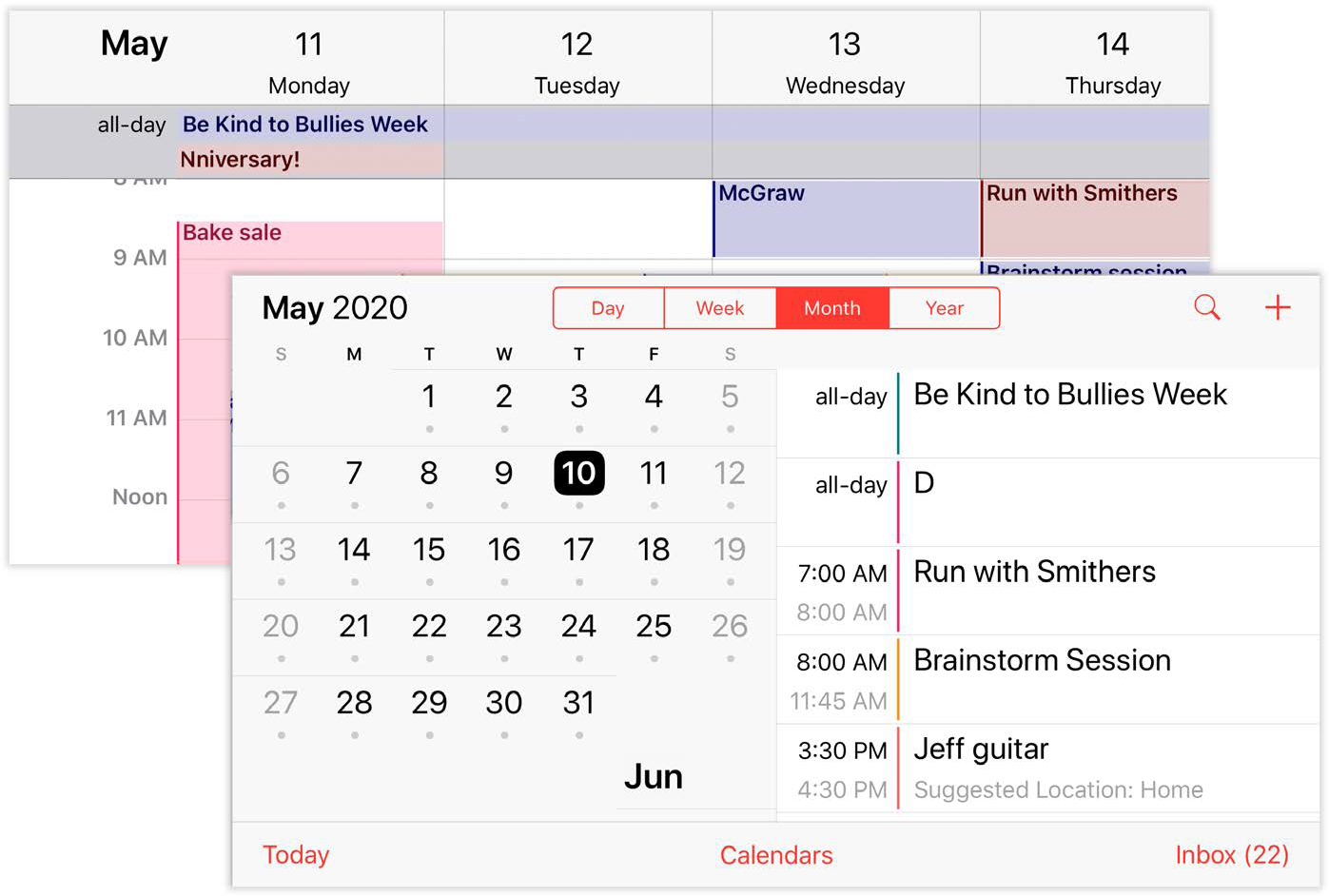
Plus and Max Model Views
If you have a Plus or Max model—one with the Jumbotron screen—then there’s room for extra information (above, bottom). On those models, the Day and Month views offer a split screen, showing the calendar on the left and details on the right. You also get a row of view buttons (Day, Week, Month, Year)—something the owners of puny regular iPhones never see.
Subscribing to Your Online Calendars
To set up real-time, wireless connections to your calendars online, tap your way to Settings → Passwords & Accounts → Add Account. Here you can tap iCloud, Exchange, Google, Yahoo, AOL, or Outlook.com to set up your account. (You can also tap Other → Add CalDAV Account to fill in the details of a less well-known calendar server, or Other → Add Subscribed Calendar to connect to an online calendar subscription service—from TripIt or your favorite sports team, for example.
Making an Appointment (Day or Month View)
Recording an event on this calendar is more complex than entering one on, say, one of those “Midwest Police Stations Hunks” paper calendars.
Start by tapping ![]() (top-right corner of the screen). The New Event screen pops up, filled with tappable lines of information. Tap one (like Starts or Repeat) to open a configuration screen for that element.
(top-right corner of the screen). The New Event screen pops up, filled with tappable lines of information. Tap one (like Starts or Repeat) to open a configuration screen for that element.
For example:
Title/Location. Name your appointment here. For example, you might type Fly to Phoenix.
The second line, called Location, makes a lot of sense. If you think about it, almost everyone needs to record where a meeting is to take place. You might type a reminder for yourself like My place, a specific address like 212 East 23rd, a contact phone, or a flight number.
Starts/Ends. Tap Starts, and then indicate the starting time for this appointment, using the four spinning dials that appear at the bottom of the screen (facing page, right). The first sets the date; the second, the hour; the third, the minute; the fourth, AM or PM.
Then tap Ends, and repeat the process to schedule the ending time. (The iPhone helpfully presets the Ends time to one hour later.)
An All-day event, of course, has no specific time of day: a holiday, a birthday. When you turn this option on, the Starts and Ends times disappear. The event appears at the top of the list for that day.
TIP
Calendar can handle multiday appointments, like trips. Turn on All-day—and use the Starts and Ends controls to specify beginning and ending dates. The appointment appears as either a list item that repeats on every day’s square or as a banner across the days, depending on the iPhone model and screen space available.
Repeat. The screen here contains common options for recurring events: every day, every week, and so on. It starts out saying Never. And if you click Custom, you’ll see an infinitely customizable range of less-common options—every seven years on the third Tuesday in February, say.
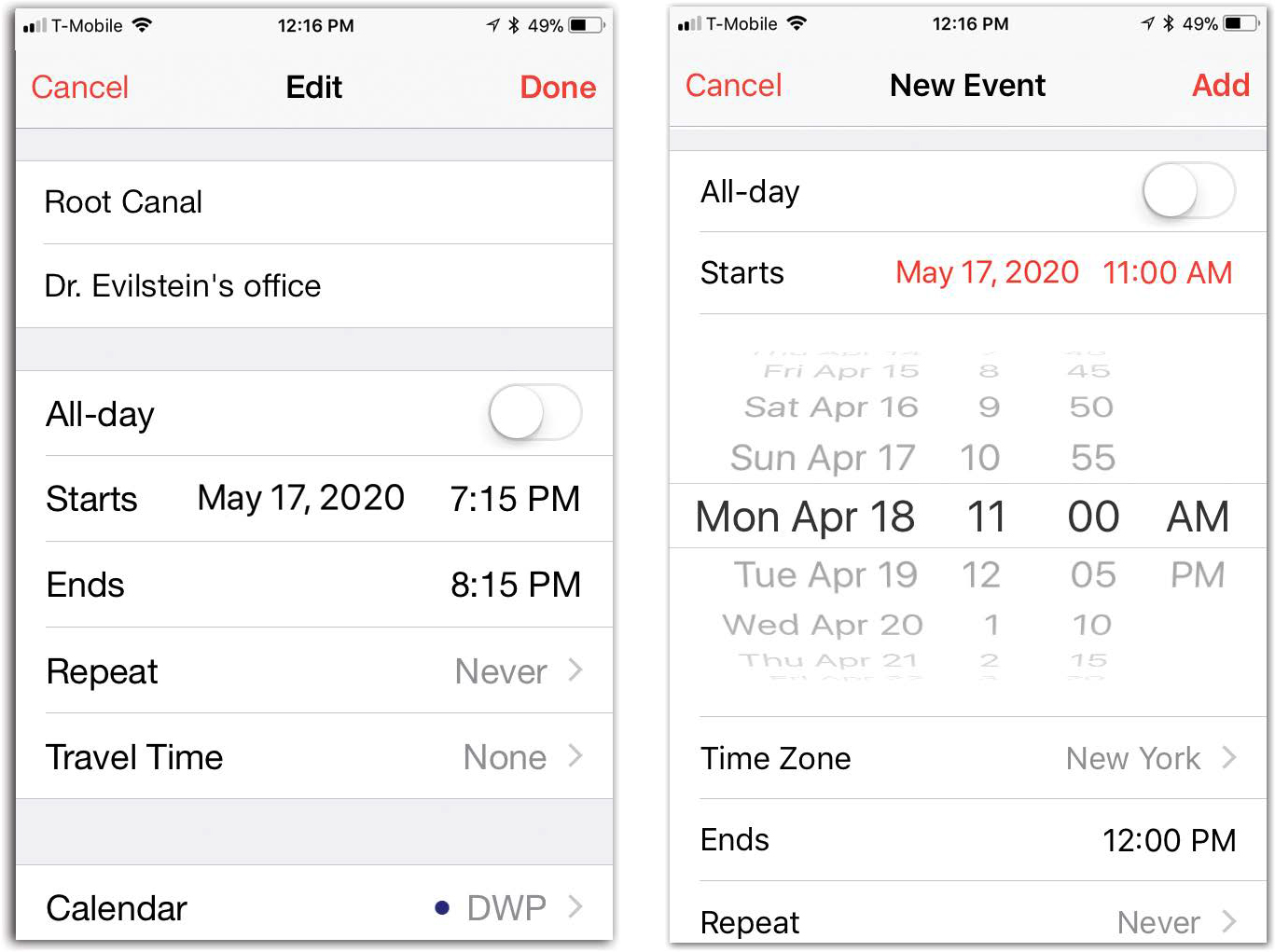
Once you tap a selection, you return to the Edit screen. Now you can tap the End Repeat button to specify when this event should stop repeating. If you leave the setting at Never, you’re stuck seeing this event repeating on your calendar until the end of time (a good choice for recording your anniversary, especially if your spouse might be consulting the same calendar).
In other situations, you may prefer to tap On Date and spin the three dials (month, day, year) to specify an ending date, which is useful for car payments or a season’s worth of soccer games.
Tap New Event to return to the editing screen.
Travel Time. If you turn on this switch, you can indicate how long it’ll take you to get to this appointment. You get six canned choices, from five minutes to two hours. Or you can tap Starting Location and specify your starting point, and marvel as the iPhone calculates the driving time automatically. (Walking time, too, if it’s close enough.)
Two things then happen. First, the travel time is blocked off on your calendar, so you don’t accidentally schedule things during your driving time. (The travel time is depicted as a dotted extension of the appointment.)
Second, if you’ve set up an alarm reminder, it will go off that much earlier, so you have time to get where you’re going.
Calendar. Tap to specify which color-coded calendar (category, like Home, Kids, or Work) this appointment belongs to (see “Editing, Rescheduling, Deleting Events (Long Way)”).
Invitees. If you have an iCloud, Exchange, or CalDAV account, you can invite people to an event—a meeting, a party, whatever—and track their responses, right there on your phone (or any iCloud gadget). See “Search”.
Alert. This screen tells Calendar how to notify you when a certain appointment is about to begin. Calendar can send any of four kinds of flags to get your attention. Tap how much notice you want: 5, 15, or 30 minutes before the big moment; an hour or two before; a day or two before; a week before; or on the day of the event.
NOTE
For all-day events like birthdays, you get a smaller but very useful list of choices: On day of event (9 AM), 1 day before (9 AM), 2 days before (9 AM), and 1 week before.
When you tap Add Event and return to the main Add Event screen, a new line, called Second Alert, has sprouted up beneath the first alert line. This line lets you schedule a second warning for your appointment, which can occur either before or after the first one. Think of it as a backup alarm for events of extra urgency.
Once you’ve scheduled these alerts, you’ll see a message appear on the screen at the appointed time(s). (Even if the phone was asleep, it appears briefly.) You’ll also hear a chirpy alarm sound.
NOTE
The iPhone doesn’t play the sound if you’ve turned off Calendar Alerts in Settings → Sounds or Settings → Sounds & Haptics. It also doesn’t play if you’ve silenced the phone with the silencer switch on the side.
Show as. If you work in the business world, it’s courteous to mark your new appointments as either Busy or Free. That way, other people who see your calendar, trying to schedule a meeting when you can attend, will know which events on your calendar are movable and which are nonnegotiable. If you’re just indicating “Keeping Up with the Kardashians TV marathon,” maybe that one should be marked as Free.
Add attachment. This option, new in iOS 13, opens your iCloud Drive (“iCloud Sync”). You can now choose a photo, PDF document, Word document, or some other file to attach to this appointment for reference later. It’s great for attaching an itinerary or a business document to review for a meeting.
URL. Here’s a spot where you can record the web address of some online site that provides more information about this event.
Notes. You can type any text you want in the Notes area—driving directions, contact phone numbers, a call history, or whatever.
When you’re done filling in all these blanks, tap Add. Your newly scheduled event shows up on the calendar.
Making an Appointment (Day View, Week View)
As noted earlier, turning the phone 90 degrees opens up a widescreen, scrolling Week view of your life.
In both Day view and Week view, you can hold your finger down on a time slot to add a new, one-hour appointment right there. You’re asked to enter a name and, if you like, location for this new appointment. Tap Add. You can always edit this appointment’s details or duration later, as described next—but this quick-and-dirty technique saves the effort of tapping in Starts and Ends times.
Editing and Rescheduling Events (Fun Way)
In Day or Week views, you can drag an appointment’s block to another time slot or even another day. Just hold your finger down on the appointment’s bubble for about a second—until it darkens—before you start to drag. It’s a lot quicker and more fluid than having to edit in a dialog box.
You can also change the duration of an appointment in Day and Week views. Hold your finger down on its colored block for about a second; when you let go, round handles appear.
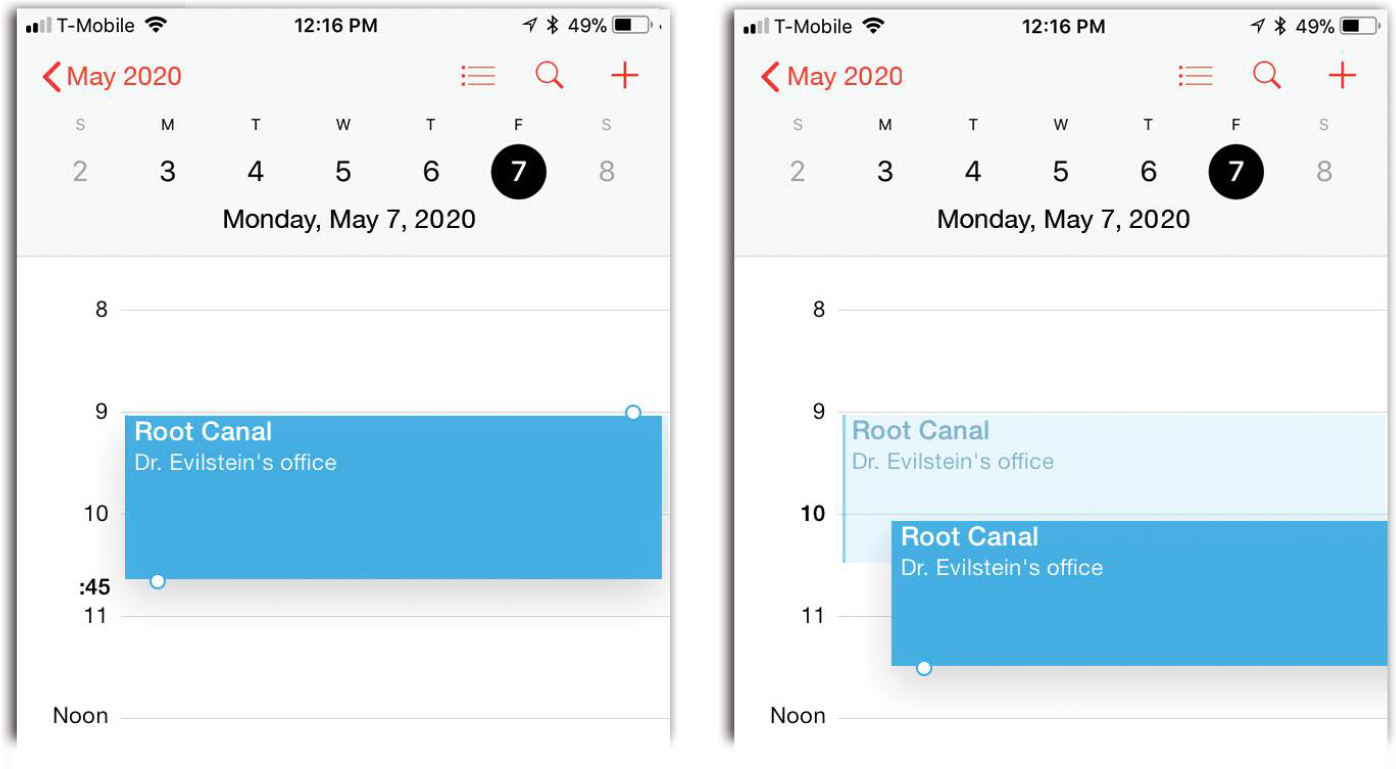
You can drag those tiny handles up or down to make the block taller or shorter, in effect making it start or end at a different time.
Whether you drag the whole block, the top edge, or the bottom edge, the iPhone thoughtfully displays “:15,” “:30,” or “:45” on the left-side time ruler to let you know where you’ll be when you let go.
Editing, Rescheduling, Deleting Events (Long Way)
To examine the details of an appointment in the calendar, tap it once. The Event Details screen appears, showing the details you previously established. At bottom: a red Delete Event button. That’s the only way to erase an appointment from your calendar. (You can’t erase events created by other people—Facebook birthdays, meetings on shared calendars, and so on—only appointments you created.)
To edit any of the details, tap Edit. You return to what looks like a clone of the New Event screen.
The Calendar (Category) Concept
A calendar, in Apple’s somewhat confusing terminology, is a color-coded subset—a category, really—into which you can place various appointments. One person might make calendars called Home, Work, and TV Reminders. Another might have Me, Spouse ‘n’ Me, and The Kidz. A small business could have categories called Deductible Travel, R&D, and R&R.
You can create and edit calendar categories right on the iPhone, in your desktop calendar program, or (if you’re an iCloud member) at icloud.com when you’re at your computer; all your categories and color-codings show up on the iPhone automatically.
At any time, on the iPhone, you can choose which subset of categories you want to see. Just tap Calendars at the bottom of Day, Month, or Year view. You arrive at the big color-coded list of your categories (facing page, left). As you can see, it’s subdivided according to your accounts: your Gmail categories, your Yahoo categories, your iCloud categories, and so on.
NOTE
iOS no longer gives you the option to hide or show your Facebook friends’ birthdays. So if you give Facebook access to your Contacts app, they all show up on your calendar. If that’s not contributing to your productivity, you’ll have to delete those events one at a time in Contacts.
This screen exists partly as a reference, a cheat sheet to help you remember what color goes with which category, and partly as a tappable subset chooser. That is, you can tap a category’s name to hide or show its appointments on the calendar. A checkmark means you’re seeing its appointments. (The Show All/Hide All [account name] button turns on or off all that account’s categories at once.)
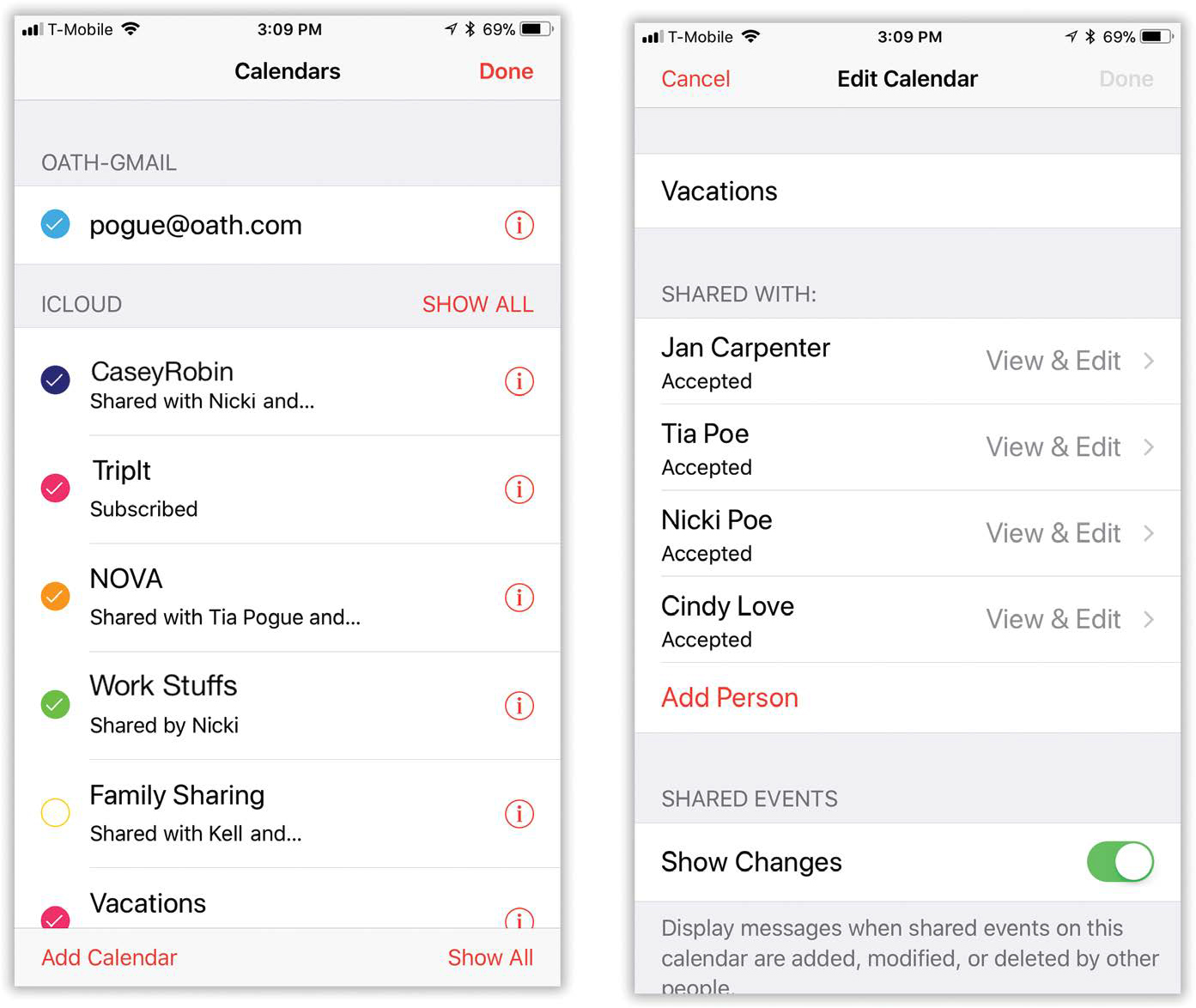
If you tap ![]() next to a calendar’s name, you’re offered a screen where you can change the calendar’s name; the list of people who can see it (“Shared With:”); whether or not you get notified when one of those people changes events in this category (Show Changes); what color you want this category’s events to have (“Color”); whether you want to get notifications of items in this calendar (Event Alerts); and if you want other people to be able to see (but not edit) this category (Public Calendar, described in the Tip on the next page).
next to a calendar’s name, you’re offered a screen where you can change the calendar’s name; the list of people who can see it (“Shared With:”); whether or not you get notified when one of those people changes events in this category (Show Changes); what color you want this category’s events to have (“Color”); whether you want to get notifications of items in this calendar (Event Alerts); and if you want other people to be able to see (but not edit) this category (Public Calendar, described in the Tip on the next page).
Or scroll all the way down to see the Delete Calendar button.
The Edit Calendars screen also offers an Add Calendar button. It’s the key to creating, naming, and colorizing a new calendar on the phone. (Whatever changes you make to your calendar categories on the phone will be synced back to your Mac or PC.)
TIP
You can share an iCloud calendar with other iCloud members (previous page, right), which is fantastic for families and small-business employees who need to coordinate. Tap Calendars, and then tap ![]() next to the calendar’s name. Tap Add Person and enter the person’s name. Your invitees get invitations by email; with one click, they’ve added your appointments to their calendars. They can make changes, too.
next to the calendar’s name. Tap Add Person and enter the person’s name. Your invitees get invitations by email; with one click, they’ve added your appointments to their calendars. They can make changes, too.
You can also share a calendar with anyone (not just iCloud members) in a “Look but don’t touch” condition. Tap Calendars, and then tap ![]() next to the calendar’s name. Turn on Public Calendar; tap Share Link to open the Share sheet for sending the link. The recipients have but to tap that link and then tap Subscribe to see your Public calendar’s events in their own Calendar apps.
next to the calendar’s name. Turn on Public Calendar; tap Share Link to open the Share sheet for sending the link. The recipients have but to tap that link and then tap Subscribe to see your Public calendar’s events in their own Calendar apps.
Search
If you tap ![]() and type into the search box, you pare down the list of calendar events; only events whose names match what you’ve typed show up. Tap one to jump to its block on the corresponding Day view.
and type into the search box, you pare down the list of calendar events; only events whose names match what you’ve typed show up. Tap one to jump to its block on the corresponding Day view.
Next time you’re sure you made an appointment with Robin but you can’t remember the date, keep this search feature in mind.
Invitations
Invitations are electronic invitations that co-workers send you from Calendar, Outlook, or other calendar apps. If you click Accept, the meeting gets dropped onto the proper date in your calendar, and your name gets added to the list of attendees maintained by the person who invited you. If you click Maybe, the meeting is flagged that way, on both your calendar and the sender’s.
You’ll know when you have an invite. You get a standard notification, a numbered “badge” on Calendar’s icon on the Home screen, and a similar badge on the Inbox at the lower-right corner. Tapping Inbox shows the Invitations list, which summarizes all invitations you’ve accepted, maybe’d, or not responded to yet.
NOTE
Invitations you haven’t dealt with also show up on the Calendar’s List view or Day view with dotted shading. That’s the iPhone’s clever way of showing you just how severely your workday will be ruined.
You can also generate invitations. When you’re filling out the Info form for a new appointment, tap the field called Invitees; you get an Add Invitees screen, where you can type in the email addresses of your desired guests. (Or tap ![]() to choose them from your Contacts list.)
to choose them from your Contacts list.)
Later, when you tap Done, the phone fires off email invitations to those guests. It contains buttons for them to click: Accept, Decline, and Maybe. You get to see their responses right here in the details of your calendar event.
As icing on the cake, your guests will see a pop-up reminder on their phones when the time comes for the party to get started.
TIP
The iOS calendar is pretty basic. For more features and power, consider calendar apps like Fantastical 2 or BusyCal.
Clock
It’s not just a clock—it’s more like a time factory. Hiding behind this icon on the Home screen are five programs: a world clock, an alarm clock, a stopwatch, a countdown timer, and a bedtime-management module.
NOTE
The app icon on the Home screen shows the current time! Isn’t that cute?
World Clock
When you tap World Clock on the Clock screen, you start out with only one clock, showing the current time in Apple’s own Cupertino, California.
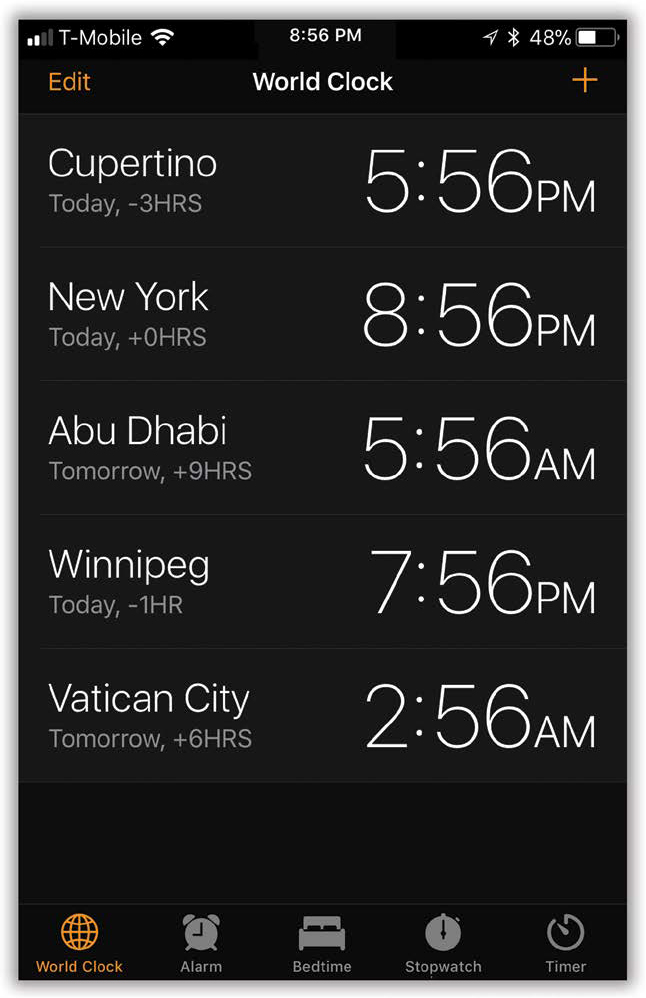
You can open up several of these clocks and set each one to show the time in a different city. Now you’ll know what time it is in some remote city, so you don’t wake somebody up at what turns out to be 3 a.m.
To specify which city’s time appears on the clock, tap ![]() at the upper-right corner. Scroll to the city you want, or tap its first letter in the index at the right side to save scrolling, or tap in the search box at the top and type the name of a major city. As you type, matching city names appear; tap the one whose time you want to track.
at the upper-right corner. Scroll to the city you want, or tap its first letter in the index at the right side to save scrolling, or tap in the search box at the top and type the name of a major city. As you type, matching city names appear; tap the one whose time you want to track.
As soon as you tap a city name, you return to the World Clock display.
You can scroll the list of clocks. You’re not limited by the number that fit on your screen at once.
TIP
Only the world’s major cities are in the iPhone’s database. If you’re trying to track the time in Squirrel Cheeks, New Mexico, add a major city in the same time zone instead—like Albuquerque.
To edit the list of clocks, tap Edit. Delete a city clock by tapping ![]() and then Delete, or drag clocks up and down using the
and then Delete, or drag clocks up and down using the ![]() as a handle. Then tap Done.
as a handle. Then tap Done.
Alarm
If you travel much, this feature could turn out to be one of your iPhone’s most useful functions. It’s reliable, it’s programmable, and it even wakes the phone first, if necessary, to wake you.
To set an alarm, tap Alarm at the bottom of the Clock screen. You’re shown the list of alarms you’ve already created (facing page, left), even if none are currently set to go off. You could create a 6:30 a.m. alarm for weekdays and an 11:30 a.m. alarm for weekends.
To create a new alarm, tap ![]() to open the Add Alarm screen.
to open the Add Alarm screen.
TIP
Really, you should not bother setting alarms using this manual technique. Instead, you’ll save a lot of time and steps by using Siri. Just say, “Set my alarm for 7:30 a.m.” (or whatever time you want).
And while we’re at it: You can also say, “Change my 7:30 a.m. alarm to 8 a.m.” And if you get really lucky with your life karma, you may even have the opportunity to say the greatest thing you can possibly say to Siri: “Turn off my alarm.”
You have several options here:
Time dials. Spin these three vertical wheels—hour, minute, AM/PM—to specify the time you want the alarm to go off.

Repeat. Tap to specify what days this alarm rings. You can specify, for example, Mondays, Wednesdays, and Fridays by tapping those three buttons. (Tap a day-of-the-week button again to turn off its checkmark.) Tap Back when you’re done. (If you choose Saturdays and Sundays, iOS is smart enough to call that “Weekends.” And it knows that Monday, Tuesday, Wednesday, Thursday, and Friday are “Weekdays.”)
Label. Tap to give this alarm a description, like “Get dressed for wedding.” That message appears on the screen when the alarm goes off.
Sound. Choose what sound you want to ring. You can choose from any of the iPhone’s ringtone sounds, any you’ve added yourself—or, best of all, Pick a Song. That’s right—you can wake to the music of your choice.
Snooze. If this option is on, then at the appointed time the alarm message on the screen offers you a Snooze button. Tap it for nine more minutes of sleep, at which point the iPhone tries again. (If your phone was in Sleep mode, it gives you a countdown to the next rude awakening.)
When you finally tap Save, you return to the Alarm screen, which lists your new alarm. Just tap the on/off switch to cancel an alarm. It stays in the list, though, so you can quickly reactivate it another day, without having to redo the whole thing. You can tap ![]() to set another alarm, if you like.
to set another alarm, if you like.
Now ![]() appears in the status bar at the top of the iPhone screen (or, on Face ID phones, just in the Control Center). The alarm is set.
appears in the status bar at the top of the iPhone screen (or, on Face ID phones, just in the Control Center). The alarm is set.
To delete an alarm, swipe left across its name and then tap Delete. To change the time, name, sound, and so on, tap Edit, and then the alarm.
TIP
The iPhone never deletes an alarm; over time, therefore, your list of alarms may grow alarmingly large. Fortunately, you can tell Siri to clean them up for you in one fell swoop. Just say, “Delete all my alarms.”
So what happens when the alarm goes off? The iPhone wakes itself up, if it was asleep. A message appears, identifying the alarm label and the time.
And, of course, the sound rings. This alarm is one of the only iPhone sounds that you’ll hear even if the silencer switch is turned on. Apple figures that if you’ve gone to the trouble of setting an alarm, you probably want to know about it, even if you forget to turn the ringer back on.
To stop the alarm, tap Stop. To snooze it, tap the Snooze button or press the side button or a volume key. (In other words, in your sleepy haze, just grab the phone with your whole hand and squeeze. You’ll hit something that shuts the thing off.)
Bedtime
Medical research tells us that sleep deprivation and inconsistent sleep schedules take a terrible toll on our health, mood, and productivity. So iOS’s Clock app offers a Bedtime tab, newly redesigned in iOS 13. The app will attempt to keep your sleep regular—prompting you when it’s time to get ready for bed, waking you at a consistent time, and keeping a graph of your sleep consistency.
The first time you open this panel, the interview begins: What time would you like to wake up? Which days of the week should the alarm go off? How many hours of sleep do you need each night? When would you like a bedtime reminder? What ringtone or sound do you want to hear when you wake up?
TIP
You can change your answers to any of these questions later by tapping Options at top left.
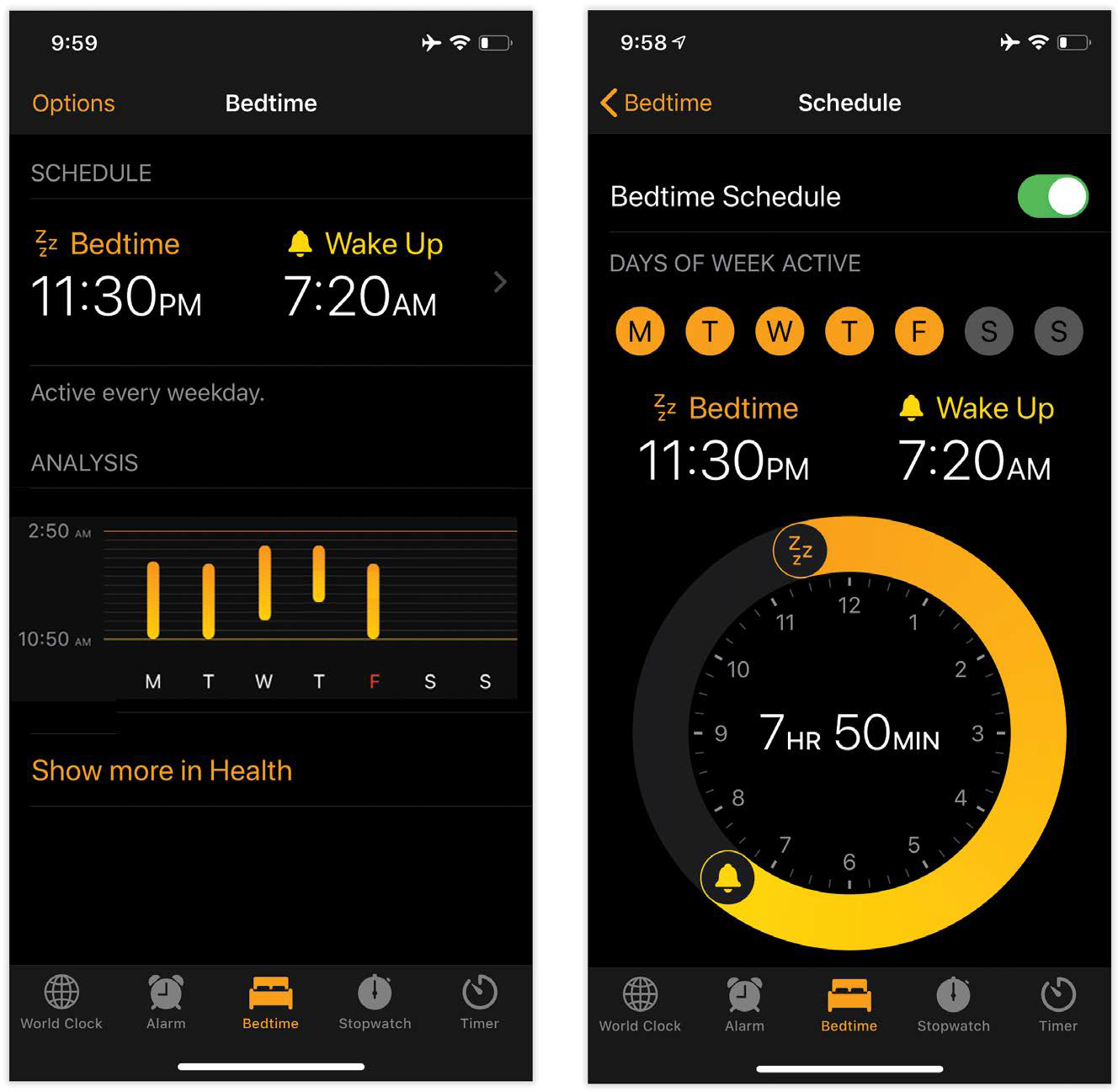
Once that’s done, you see the master Bedtime screen shown above at left. At top, it shows your target start and stop points for sleep tonight; below that, the all-important Analysis graph. Your goal is to keep the bars consistent over time—both in length and vertical position. It’s not enough to get enough sleep; you should also try to sleep during the same period each night.
Tap Options to set up a Bedtime Reminder (say, half an hour before sleepytime); turn Track Time in Bed on or off (measures how much time you use your phone while in bed); turn Do Not Disturb During Bedtime on or off (“Scheduled Do Not Disturb”); and choose an alarm sound and volume.
If you tap the Bedtime/Wake Up strip, you open the screen shown above at right—a handy visualization of the mental math millions of people perform every night anyway: “If I go to bed now, I’ll get five hours of sleep!”
You can drag either end of the round graph to adjust it, specify which days of the week you want this Bedtime to be active, or turn the whole Bedtime Schedule feature off entirely.
TIP
The Show more in Health button opens the Health app described starting in “Me”. Behind the scenes, the Health app is doing the actual work for the Bedtime module.
Stopwatch
You’ve never met a more beautiful stopwatch than this one. Tap Start to begin timing something: a runner, a train, a person who’s arguing with you.
While the digits are flying by, you can tap Lap as often as you like. Each time, the list at the bottom identifies how much time elapsed since the last time you tapped Lap. It’s a way for you to compare, for example, how much time a runner is spending on each lap around a track. You see the numbered laps and the time for each.
TIP
If you prefer an old-timey analog stopwatch display, slide the digital readout to the left. Swipe right to bring back the digital stopwatch.
You can work in other apps while the stopwatch is counting. In fact, the timer keeps ticking away even when the iPhone is asleep! As a result, you can time long-term events, like how long it takes an ice sculpture to melt, the time it takes for a bean seed to sprout, or the length of a Michael Bay movie.
Tap Stop to freeze the counter; tap Start to resume it. If you tap Reset, you reset the counter to zero and erase all the lap times.
Timer
The fifth Clock mini-app is a countdown timer. You input a starting time, and it counts down to zero. (Now with a cool circular countdown graph!)
Countdown timers are everywhere in life. They measure the periods in sports and games, cooking times in the kitchen, time limits for auditions. But on the iPhone, the timer has an especially handy function: It can turn off the music or video playback after a specified amount of time. In short, it’s a sleep timer that plays you to sleep and then shuts off to save power.
To set the timer, open the Clock app and then tap Timer. Spin the three dials to specify the number of hours, minutes, and seconds you want to count down.
Then tap When Timer Ends to set up what happens when the timer reaches 0:00. Most of the options here are ringtone sounds, so you’ll have an audible cue that the time is up. The last one, though, Stop Playing, is that sleep timer. It stops audio and video playback at the appointed time, so you (and the iPhone) can sleep. Tap Set.
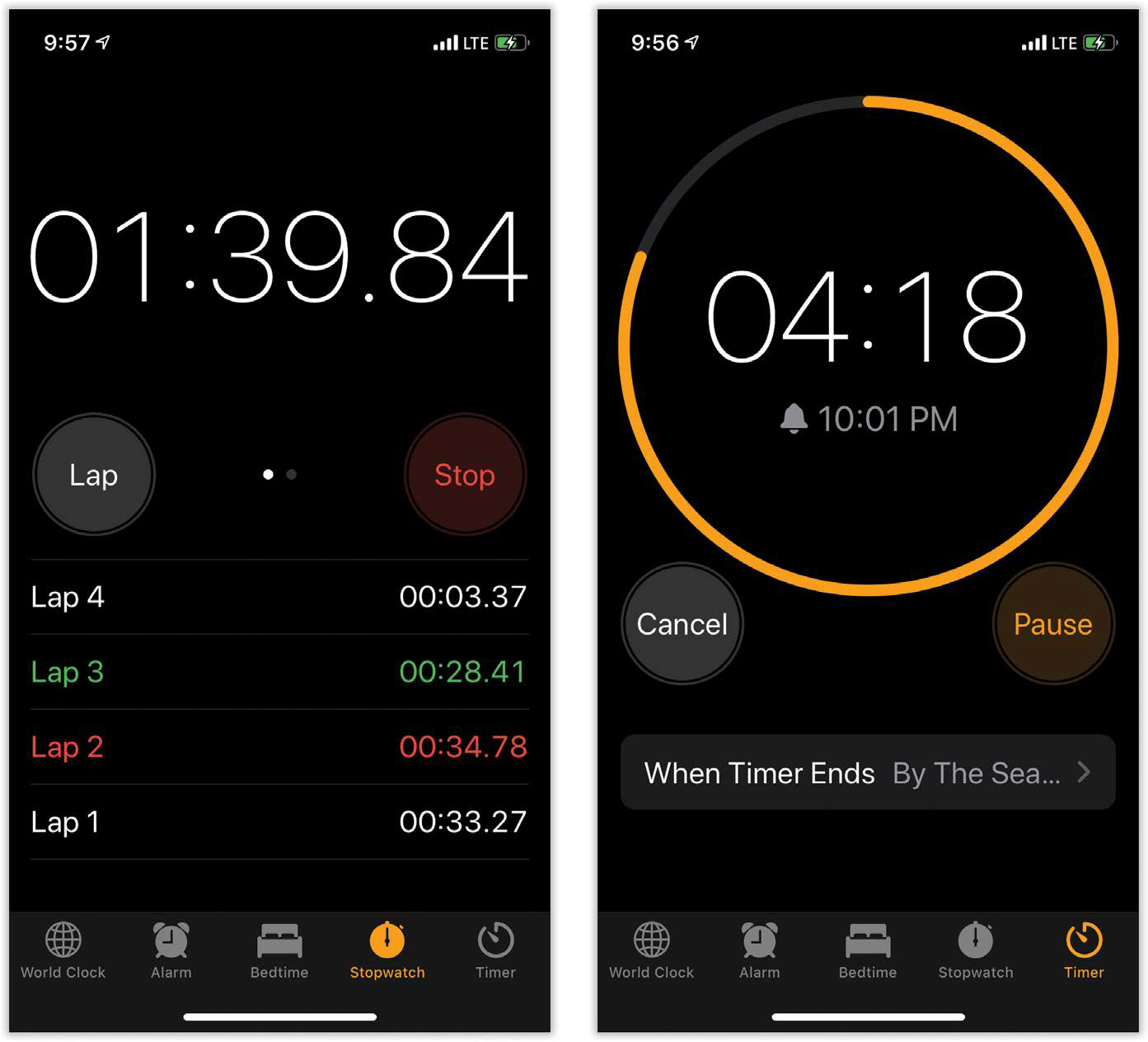
Finally, tap Start. Big clock digits count down toward zero. While it’s in progress, you can do other things on the iPhone, change the When Timer Ends settings, or just hit Cancel to forget the whole thing.
TIP
It’s much faster and simpler to use Siri to start, pause, and resume the Timer. See “Non-Apple Apps”.
You can also open the Control Center (“Control Center”) and long-press the Timer icon. Its shortcut menu offers instant options for 12 increments, from one minute to two hours.
Compass
The iPhone offers a magnetic-field sensor known as a magnetometer—even better known as a compass.
When you open the Compass app (it begins life in your Extras folder), you get exactly what you’d expect: a classic Boy Scout wilderness compass that always points north.
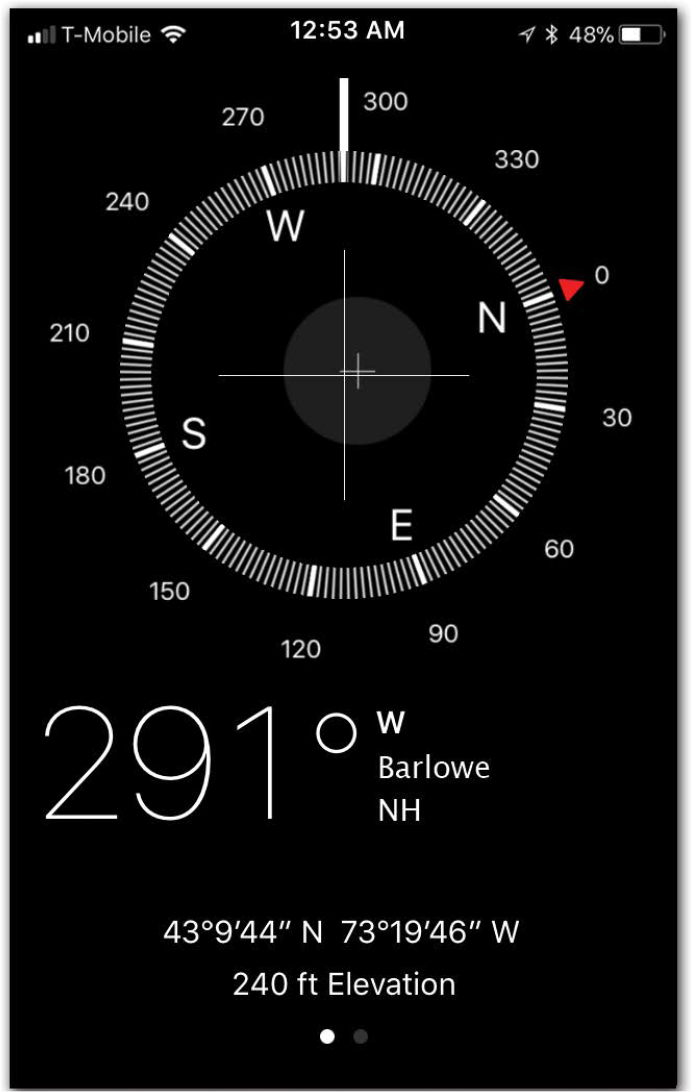
Except it does a few things the Boy Scout compasses never did. Like displaying a digital readout of your heading, altitude, city name, and precise geographic coordinates at the bottom. And offering a choice of true north (the “top” point of the Earth’s rotational axis) or magnetic north. (In the U.S., the spot where traditional compasses point is as much as 23 degrees away from true north, depending where you are.) You choose in Settings → Compass.
To use the compass, hold it roughly parallel to the ground, and then read it like…a compass. Tap the center of the compass to lock in your current heading; a red strip shows how far you are off course. Tap again to unlock the heading.
TIP
For many people, the real power of the compass is in the Maps app. (You can jump directly from Compass to Maps by tapping the coordinates below the compass dial.)
The compass lets Maps know which way you’re facing. That’s a critical detail when you’re lost in a strange city, trying to find a new address, or emerging from the subway with no idea which way to walk.
Incidentally: If you’re looking for the Compass’s traditional second personality, where it impersonates a carpenter’s level—that’s moved to a new address. It’s now part of the Measure app, described starting in “The Level”.
Files
Files is a fantastically useful app. But explaining it might take a few paragraphs.
Meet iCloud Drive…
When you switch on iCloud Drive (in Settings → [your name] → iCloud), your phone has a magic folder. Whatever you put into it appears, almost instantly, in the iCloud Drive folders on all your other machines: Macs, iPhones, iPads, and even Windows PCs. In fact, your files are even available at icloud.com, so you can grab them when you’re stranded on a desert island with nothing but somebody else’s computer. (And internet access.)
This is an incredibly handy feature. No more emailing files to yourself. No more carrying things around on a flash drive. After working on some document at the office, you can go home and resume from right where you stopped; the same file is waiting for you, exactly as you left it.
The iCloud Drive is a great backup, too, because of its automatic duplication on multiple machines. Even if your phone is stolen or burned to aluminum dust, your iCloud Drive files are safe.
…And Its Rivals
Ah, but iCloud Drive is not the only magic folder-syncing service. There’s also Dropbox, Google Drive, OneDrive (Microsoft), Creative Cloud (Adobe), and Box. They all work essentially alike.
NOTE
For example, they all offer a certain amount of free storage—5 GB, in Apple’s case—and if you outgrow that, you can pay monthly for more room.
So Apple thought it might be cool to create one single app that can access all these services. You can search them all at once, too!
Working with Files
On the Browse tab, tap Locations to hook up your various accounts (Google Drive, Dropbox, and so on). Tap Edit, and then turn on the services you use. Each will require you to log in with your name and password for that service. You can also drag the ![]() handle to rearrange them in the list. Tap Done.
handle to rearrange them in the list. Tap Done.
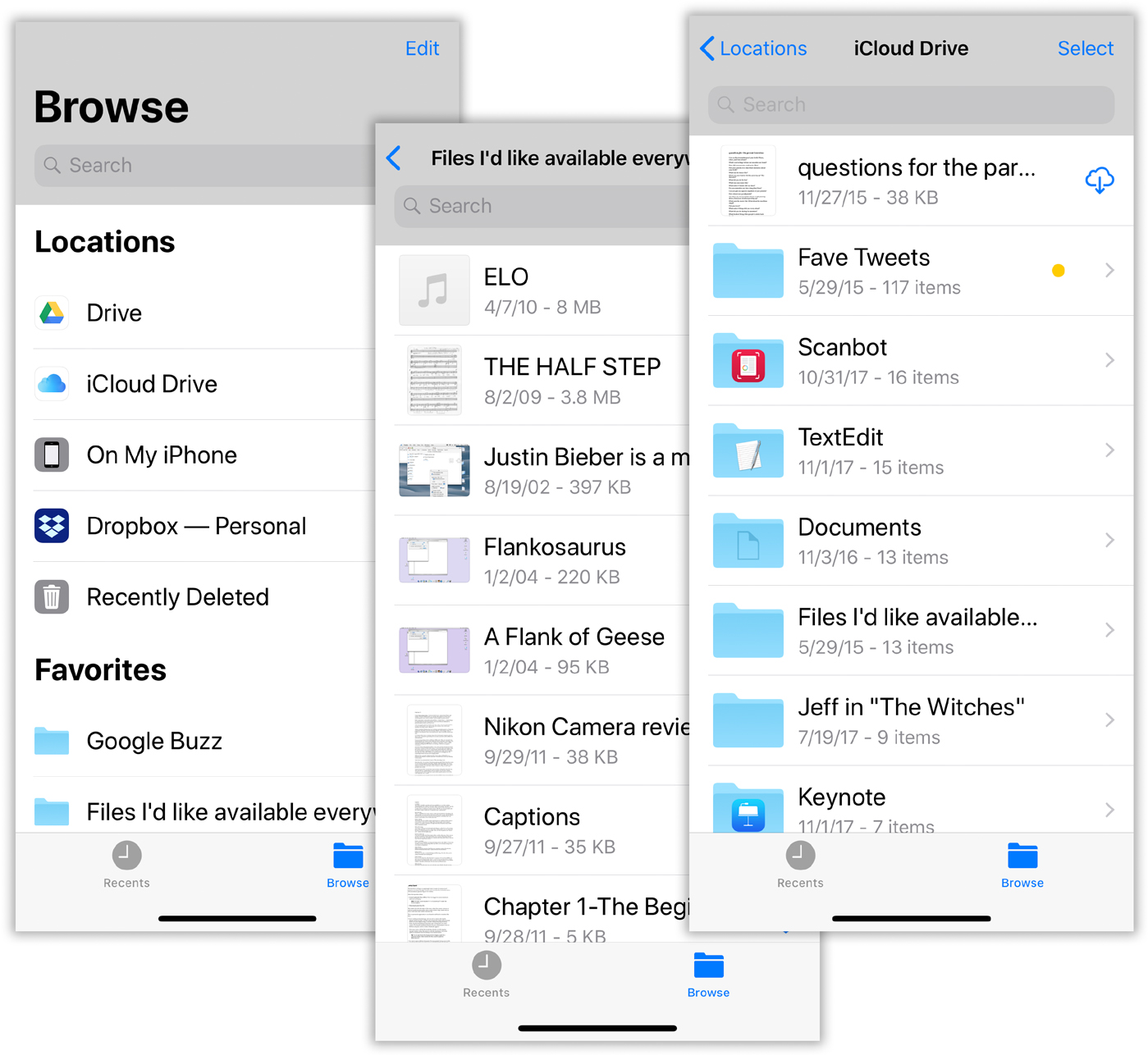
To see your actual files, tap one of the services’ names—say, iCloud Drive. And boom: You’re looking at a tidy list of all the files and folders on that “drive” (above, right). Here’s what you can do with them:
To download a file to your phone, tap its name (or the
 button).
button).To open a file, tap it. Now, iOS is not macOS or Windows; still, it can open many kinds of documents right on the phone. Graphics, music and video files, Microsoft Office documents, and PDFs all open right up—at least once they’ve been downloaded. Other kinds of computer files may open in their associated apps on the phone—or not at all. In those cases, Files is still useful, though, because it lets you forward those documents by email to a machine that can open them.
In iOS 13, in fact, you can even create or open .zip files, compressing or decompressing a file on the fly. The trick is to long-press the file and, from the shortcut menu, choose Compress (or Decompress).
TIP
If you’ve opened a photo or PDF file, you can annotate it using the Markup tools described in “Add a Sketch”. Tap the
 .
.To delete, move, or manipulate a file or folder, long-press it. Buttons appear for Copy, Duplicate, Move (into a different folder), Delete, Info, Quick Look, Tags (or Favorite), Rename, and Share.
Those are fairly self-explanatory, but don’t miss the Share feature. It lets you send anyone in the world a copy of anything on any of your virtual drives, just by sending a link to it.
Quick Look is pretty awesome, too; it lets you see what’s in a file without fully opening it.
To operate on multiple files simultaneously, tap Select, and then tap the files you want. Now you can use the
 (Share),
(Share),  (Duplicate),
(Duplicate),  (Move to different folder), and
(Move to different folder), and  (Delete) buttons at the bottom.
(Delete) buttons at the bottom.
TIP
There’s a second way to select multiple files, in readiness for moving into a folder. It’s tricky but faster once you get it. Start dragging one file or folder, and then pause. Without releasing your finger, use other fingers to tap other icons. You’ll see those additional icons jump to your original finger, ready to complete the drag into a folder’s icon.
If you tug downward on the display of files and folders, you reveal three new blue controls at the top:
To create a new folder, tap
 at the top-left corner.
at the top-left corner.To change the sorting order, tap Sorted by at the top; choose Name, Date, Size, or Tags.
To switch from list view to icon view, tap the
 icon at top right.
icon at top right.
Tagging Files
The Browse tab also lets you round up all files with a particular tag (a color-coded label that you make up, like Important or Smithers Project). What’s especially powerful is that your tagged files can come from all different services—one from Dropbox, a few from Google Drive, and so on. They all appear in one unified, harmonious “tagged” list, without reference to creed, color, or place of origin.
To apply a tag, select a file, or several. Now tap ![]() (or tap the Share button that appears in the scrollable black command bar when you long-press the icon). Tap +Tag, and then tap the tag name(s) that you want to apply. This, by the way, is your only chance to create a new tag (Add New Tag).
(or tap the Share button that appears in the scrollable black command bar when you long-press the icon). Tap +Tag, and then tap the tag name(s) that you want to apply. This, by the way, is your only chance to create a new tag (Add New Tag).
Thereafter, you can see all the files bearing a certain tag in either of two ways:
On the main Browse screen, tap a tag name to see all the files you’ve tagged that way.
On the Recents screen, scroll down to the tag headings; there are your tagged files. (As you could probably figure out, the Recents screen’s other purpose is to display the icons of files you’ve opened recently.)
(To remove a tag, long-press to select the file or files, and then tap Tags in the black command bar. Tap the tag name to remove the checkmark.)
Favorites Folders
Tags work only on files. What about folders?
For those, Apple has supplied a Favorites feature. Select a folder (or several); then, from the command bar that appears when you long-press an icon, tap Favorite. Those folders now appear beneath the Favorites heading on the main Browse tab, for quick access.
Here again, your Favorites folders can come from all different syncing services. They’re just happy to be your favorites.
TIP
Your iCloud Drive folder contains inner folders named for Apple apps like Pages, Numbers, and so on. Yes, these folders hold the corresponding kinds of documents, for ease of finding later.
But Pages, Keynote, and Numbers offer a cool feature: real-time, simultaneous editing across the internet. You and your colleagues can collaborate on one of these kinds of documents live. (If you’ve ever used Google Docs, you’re familiar with the process.)
There’s a lot of fine print to making this work; fortunately, Apple has created a guide here: support.apple.com/en-us/HT206181.
In all these apps, there’s an Open button or icon that presents the iCloud Drive’s contents. In Pages, for example, when you’re viewing your list of documents on the Browse tab, you can tap iCloud Drive to see all the folders on your iCloud Drive, corresponding perfectly to what you would have seen on a Mac or a PC. Tap a folder to open it.
Find My
No, that’s not a typo. The app’s name really is missing a direct object. Find My what?
The name makes a little more sense when you realize that it combines what used to be two apps: Find My iPhone and Find My Friends. The purpose of both apps was the same—to show where things are on a map. This new uni-app has three tabs: Friends, Devices, and Me.
People
Find My People is great for keeping tabs on your very young or very old loved ones, for arranging meet-up points in a crowded city, or for making sure nobody’s cheating on you.
This feature requires transparency and approval on both sides; you can’t track people without their permission and awareness.
It may seem backward, but to start tracking someone, you’re supposed to first show goodwill by letting them track you. They then have the option of letting you track them back.
Suppose, for example, that Juliet wants to monitor Romeo’s position. In the app, Juliet taps Share My Location. She starts typing romeo into the To box; she taps his name in the list and then taps Send.
Her phone asks how she wants to broadcast her position to Romeo: Share for One Hour (good for locating a friend downtown), Share Until End of Day (good for finding your colleague at the company off-site), or Share Indefinitely (good for finding your spouse).
At this moment, Romeo sees a notification that says, “Juliet Capulet started sharing location with you. Do you want to share yours?” Romeo, too, can choose either One Hour, End of Day, or Indefinitely (or, if he’s still hung up on someone else, Don’t Share).
Now Juliet sees a note that Romeo has shared his location, and his name shows up in the People list. She can tap his name to see his position on a map.
At that point, the info panel on the bottom half of the screen (which she can drag upward to expand) offers her buttons to Contact Romeo, get Directions to his location, set up Notifications (described next), add or remove him from the Favorites list, edit his location’s name (to, for example, “Montague House”), stop sharing her location with him, or remove him altogether from this app’s list.
Under Notifications, if Juliet taps Add, the app offers to Notify Me or Notify Romeo. Answering this question is a little baffling for her, since she doesn’t yet know what she’s asking to be notified about—but here’s how it shakes down:
Notify Me. Juliet will get notified when Romeo either arrives at, or departs from, a certain place—either his Current Location or another one that she specifies. Yes, it’s super-creepy in the wrong hands—but, again, this doesn’t work unless he has invited her to know where he is. Also, Romeo will be notified that Juliet has turned this notification feature on.
Notify Romeo. In this case, Romeo will get notified when Juliet arrives at, or departs from, her Current Location or another address that she sets up here.
In each case, she can also choose how often to get these notification bubbles: either Only Once (meaning today only), or Every Time (meaning, every time, every day, that this person arrives or leaves).
Once you’ve finished checking out somebody’s location, tap anywhere on the map to return to the original Find People screen, with the full list of trackees.
Devices
This tab is the new incarnation of the old Find My iPhone app. It lists the Apple gadgets you own (signed into your iCloud account). Tap one to see where it is on a map (below, left). The expandable panel at the bottom of the screen offers five powerful tools for the panicking gadget owner: Play Sound, Notifications, Mark As Lost, and Erase This Device are described in “Find My iPhone”. Directions opens Maps to guide you to the location of your lost thing.
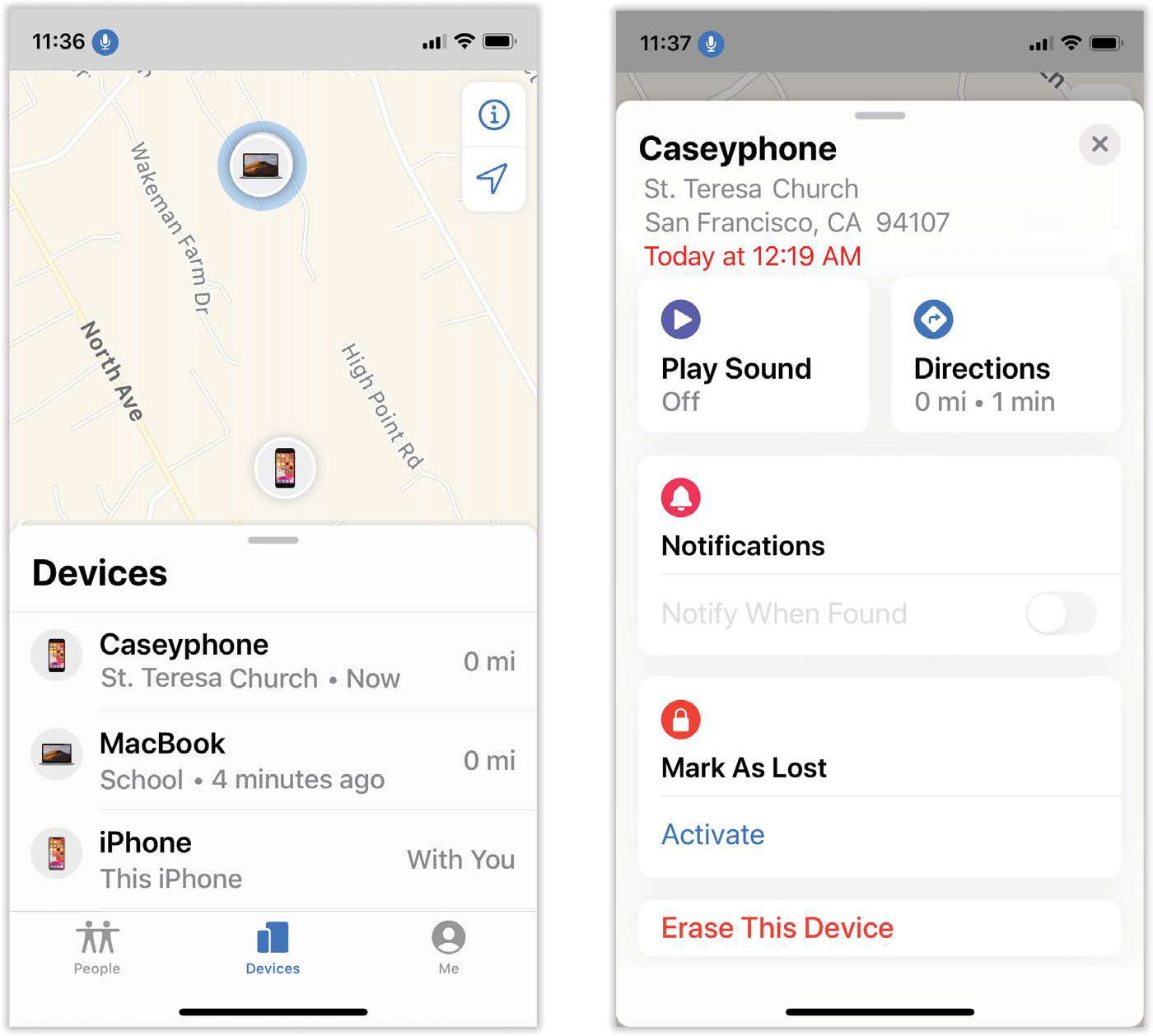
Me
On this tab, you can see where you are, and turn off Share My Location—crucial if you’re about to do something shady. Other fun to have here:
Allow Friend Requests. Are other people even allowed to ask if they can track you?
Receive Location Updates. Remember that business about getting notified when someone arrives at or departs from a location? If you have a lot of friends, that feature could wind up bombarding your phone with notifications. This item lets you limit those incoming notifications to people you’ve shared your location with (instead of getting them from Everyone).
Use This Phone as My Location is important if you own multiple Apple devices. Which one, for locating purposes, is you?
Edit Location Name lets you label your current location, as other people will see it (“My pad,” for example, or “Secret nook”).
Help a Friend. At last, Apple has recognized the towering logical fallacy of the Find My iPhone feature. If you can’t find your iPhone, what good is an app, on your phone, that helps you find it?
The idea here is that you can use somebody else’s phone to find your lost one. That good Samaritan taps Help a Friend; you log in with your Apple ID; and you get to see where your phone is hiding!
Health
This app is a dashboard for all the health data—activity, sleep, nutrition, relaxation—generated by your fitness apps. But even if you don’t have an app or a band, you have the iPhone itself; unbeknownst to you, it’s been quietly tracking the steps you’ve been taking and the flights of stairs you’ve been climbing, just by measuring the jostling of the phone in your pocket or bag! (If that creeps you out just a bit, you can turn it off in Settings → Privacy → Motion & Fitness.)
Lots of apps and fitness bands share their data with Health: the Apple Watch, MyFitnessPal, Strava, MapMyRun, WebMD, 7 Minute Workout, Garmin Connect, Lark, Lose It!, Sleepio, Weight Watchers, and so on. Fitness tracking is a big, big deal these days, now that your phone and/or your fitness band can measure your steps, exercise, and sleep.
TIP
Screamingly missing from this list: Fitbit. A Fitbit band can’t share its data with the Health app—at least not without the help of a $5 app called Sync Solver or a free one called Power Sync for Fitbit.
If you have one of those bands or apps, you’ll have to fish around in its settings until you find the option to connect with Health. At that point, you turn on the kinds of data you want it to share with Health.
Now open the Health app. The setup screens invite you to set up a Medical ID, to become an organ donor, or to share your health data (anonymously) with Apple.
The Summary
In iOS 13, Apple redesigned the Health app, making it far simpler. Now the app opens to a Summary screen (facing page, left). Here’s some of what it includes:
Steps you’ve taken today. Tap to see a details screen that lists your total steps by day, week, months, or year (facing page, center); Highlights (observations about how many more or fewer steps you’re taking than usual); a list of apps that can also count your steps and track your runs; Add to Favorites (brings the Steps tile to the top of the Summary screen, where it probably is already); Show All Data (breaks down your step totals by day); and Data Sources & Access (shows a list of apps you’ve allowed to see your step count; also lists all your step-counting gadgets, and lets you drag them into priority order—tap Edit).
Highlights are artificially intelligent observations that the app makes about your fitness. It might say, for example, “Last week, you were taking more steps a day than you are this week.”
Get More From Health cards offer health-related actions you can take (for example, Register as an Organ Donor or Access Your Records), along with cheerful health-related articles.
Apps is a list of diet, exercise, and health-related apps that Apple thinks might interest you. Tap one to open the App Store to read more.
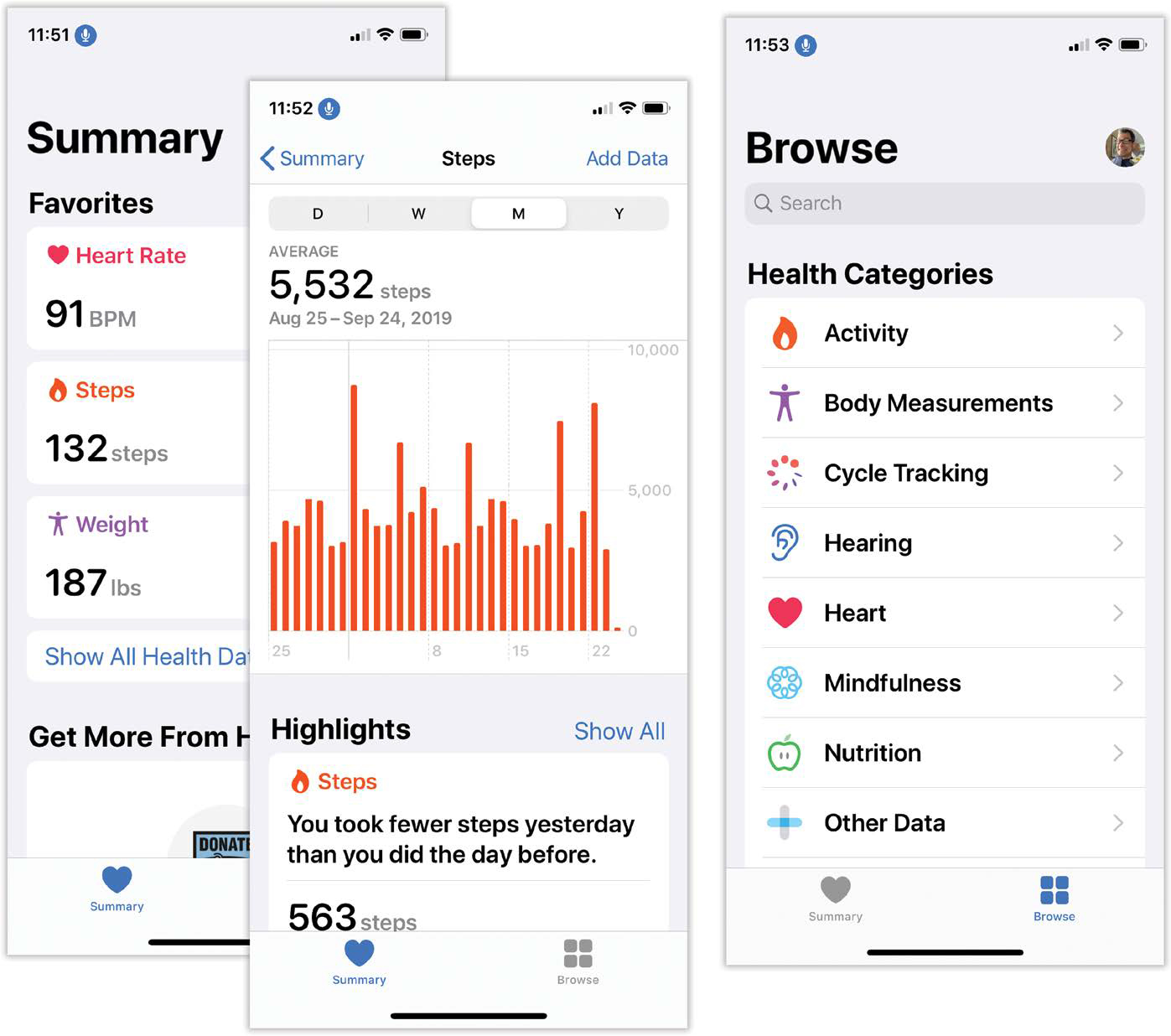
You’re welcome to customize the “tiles” on this screen, by the way. Tap Edit. The Existing Data list shows everything on the Summary screen now; tap the ![]() to make it a Favorite (shown at the top of the Summary screen). The All list shows everything Health can track, whether it’s got any data on you or not.
to make it a Favorite (shown at the top of the Summary screen). The All list shows everything Health can track, whether it’s got any data on you or not.
Browse
Hey, it’s a list of lists! Two of them, in fact (above, right):
Health Categories. These are all the health-data types the Health app can store: Activity (steps, flights of stairs, workouts), Body Measurements (height and weight, body fat percentage), Cycle Tracking, Hearing, Heart (rate, blood pressure, ECG), Mindfulness (minutes meditating), Nutrition (calcium, cholesterol), Other Data (blood glucose, inhaler usage, sexual activity, tooth brushing), Respiratory (oxygen saturation, VO2 max, rate), Sleep, and Vitals (heart rate, blood pressure).
For most of these items, you’ll see No Data Available. Remember, Health is supposed to be the database for numbers sent to it by fitness sensors and other apps. Until you hook up some app or sensor to Health, it won’t have much to show you.
Health Records is a second list (Allergies, Immunizations, Medications) designed to store your medical history and records. You can’t enter these records yourself; you’re supposed to hook up the app to participating labs, hospitals, and medical networks. Tap Get Started to get started; along the way, you’ll need the login details for each institution, which may mean some phone calls.
Once you’re hooked up, though, your medical records update automatically in the Health app whenever they change at the medical center.
Home
HomeKit is Apple’s home-automation standard. The Home app lets you control any product whose box says “Works with HomeKit”—all those “smart” or “connected” door locks, security cameras, power outlets, thermostats, doorbells, light bulbs, leak/freeze/temperature/humidity/air-quality sensors, and so on.
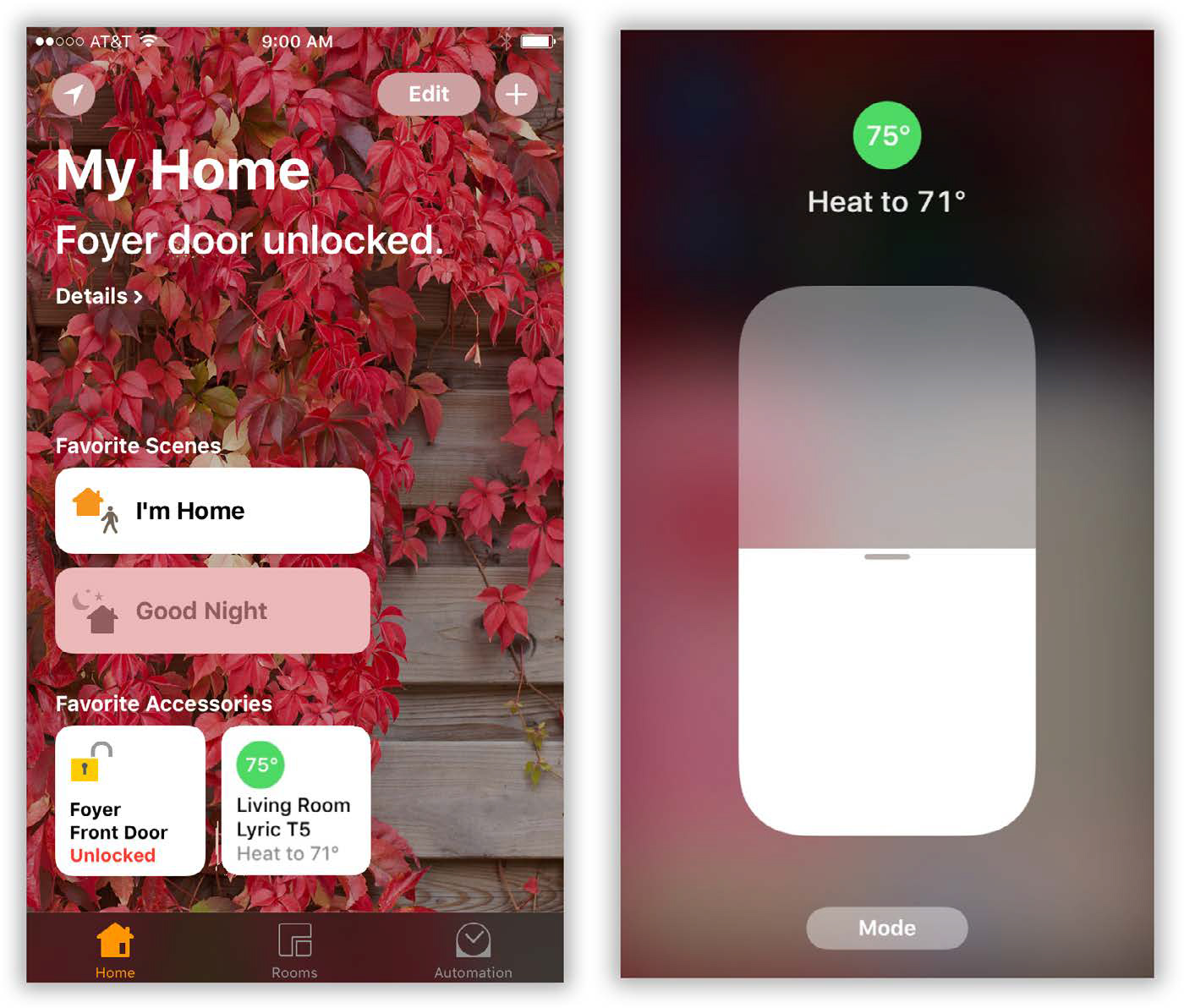
Introducing your new smart-home doodad to the app is simple. In the app, hit ![]() and then Add Accessory. The top half of the screen becomes a camera; you’re supposed to aim it at the squarish bar code (or eight-digit number) on the product’s box or sticker.
and then Add Accessory. The top half of the screen becomes a camera; you’re supposed to aim it at the squarish bar code (or eight-digit number) on the product’s box or sticker.
TIP
If you’re really lucky, your smart-home gizmo bears a little Wi-Fi-looking icon. That means that, instead of scanning the bar code, you can just hold your phone near that label to introduce the app to the device.
Now you’re asked to enter the product’s name and location. If you also turn on Include in Favorites, you’ll be able to control this gadget from the Control Center (“Control Center”) or an Apple Watch, without even having to fire up the Home app. Tap Done.
Once you’ve installed the gadget, you can use this app to turn it on and off, monitor its readouts, or adjust its settings (a thermostat is shown on the facing page at right). You can do all that from the Home app, from the Control Center, or by using Siri voice commands (“Lock the front door,” “Turn on the downstairs lights,” and so on).
This isn’t really a book about smart-home accessories, but here’s some of the fun you can have once you’ve bought a few (and then read the instructions at support.apple.com/en-us/HT204893):
Set up rooms. If you’ve got a lot of HomeKit accessories—you lucky duck—you may find it easier to keep track of them all by putting their icons on different screens, named for different rooms of your house. You’ll also be able to tell Siri, “Turn off the lights in the living room.”
TIP
You can take this concept one step further by putting your rooms into zones, which are usually “upstairs” or “downstairs.” To get started: On the Rooms tab, tap
 and then Room Settings. Now tap a room’s name and then Zone. And voilà: You can say, “Turn off the lights upstairs”!
and then Room Settings. Now tap a room’s name and then Zone. And voilà: You can say, “Turn off the lights upstairs”!Automate your gadgets. You can automate many actions based on the time or your location, or hand off control of certain devices to other people’s iPhones.
Create a scene. A “scene” is a bunch of accessories you switch on and off simultaneously. You might have one called “Goodnight” that turns off all the lights and locks the doors with a single Siri command.
Set up notifications. The Home app can alert you when a door was opened or closed, or when a light was left on. Those doggone kids!
Control your home by remote control. It’s possible to set things up so you can operate your gadgets from across the internet when you’re not even there. This does, however, require that you also own an Apple home hub, which can take the form of a recent Apple TV, a HomePod speaker, or an iPad.
Automate the whole works. If you do, in fact, have a home hub, then you can really smartify your home. You can set things up so that all the lights turn off when you leave the house, or that a certain scene happens at a certain time, or that the temperature goes up when your teenager gets home.
It can get really complicated. But imagine the magic once you get it all figured out!
Maps
The first version of Maps, Apple’s competitor to the navigation app Google Maps, was a disaster. Its databases had serious errors, often guiding drivers to nonexistent roads or over what appeared to be melting bridges. Apple promised to keep working on Maps, but in the meantime, in a remarkable apology letter, CEO Tim Cook advised his customers to use one of Maps’ rivals—like Google Maps.
It’s taken many years, but Apple’s Maps is closing the gap. Instead of cobbling together data from a bunch of different mapping companies, Apple undertook a massive, multiyear project: driving millions of miles of roads in camera vans, building its own database—and images—of the world’s roads.
The result: By the end of 2019, the entire U.S. will appear in Maps with much more detailed ground maps (like foliage, pedestrian routes, individual buildings, and so on).
Because Apple now maintains its own database, you’ll get quicker updates to reflect construction and new roads, much better traffic information, and real-time road conditions. (Apple intends to roll out the new maps in other countries in 2020.)
Meet Maps
Maps lets you type in any address or point of interest and see it plotted on a map, with turn-by-turn driving directions. It also gives you a live national Yellow Pages business directory and real-time traffic-jam alerts. You can get bus and train schedules for some U.S. cities. You have a choice of a street-map diagram or actual aerial photos, taken by satellite.
Maps Basics
In iOS 13, Maps generally displays two halves: The map itself at top and an info panel at the bottom (below, left). Tap or drag that info panel to see more of it; tap again to collapse it.
A blue dot on the map always represents your current location. Tap ![]() to center the map on your current spot. To zoom in, double-tap, “pinch out” with two fingers, or double-tap/drag with a single finger. (That is, double-tap and, with your finger still down, drag up or down.) Eventually, you zoom in enough to see actual city blocks.
to center the map on your current spot. To zoom in, double-tap, “pinch out” with two fingers, or double-tap/drag with a single finger. (That is, double-tap and, with your finger still down, drag up or down.) Eventually, you zoom in enough to see actual city blocks.
To zoom out again, you can use the rare two-finger double-tap.
To scroll around the map, drag or flick; twist two fingers to rotate it. (A compass icon at top right helps you keep your bearings; you can tap it to restore the map’s usual north-is-up orientation.) And if you drag two fingers up the screen, you tilt the map into 3D view, which makes it look like you’re surveying the map at an angle instead of straight down.
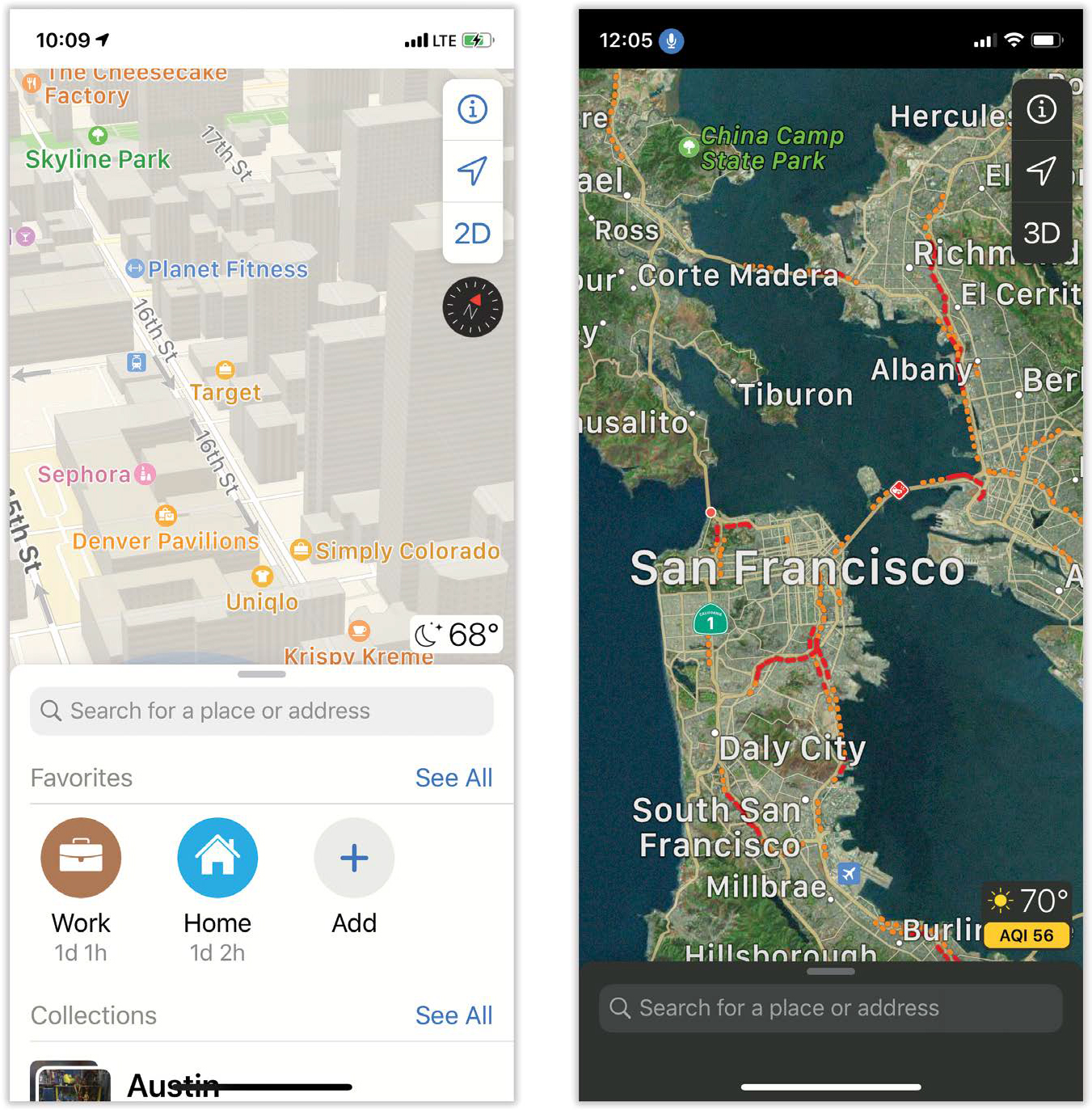
At any time, you can tap ![]() to open a secret panel. Here’s how you switch among Maps’ three views of the world: Map, Transit, or Satellite (which is shown on the previous page at right).
to open a secret panel. Here’s how you switch among Maps’ three views of the world: Map, Transit, or Satellite (which is shown on the previous page at right).
You can set up some preferences here, too. Tap Map to decide if you want to see color-coded roads that show the current traffic situation. Tap Satellite to tell Maps whether you want street names and/or traffic colors superimposed on the aerial views.
Each of these tabs offers buttons that let you Mark My Location (drop a pin in your current spot, add it to your Favorites, add it to your Contacts, and so on), Add a Place (record the address and other details of a business, thereby adding it to Apple’s database), and Report an Issue (tell Apple about a bug).
Finding Yourself
If any phone can tell you where you are, it’s the iPhone. It has not one, not two, but three ways to determine your location:
GPS. First, the iPhone contains a traditional GPS chip, of the sort that was found in windshield navigation units of old.
Wi-Fi Positioning System. Metropolitan areas today are blanketed by Wi-Fi signals. At a typical Manhattan intersection, you might be in range of 30 base stations. Each one broadcasts its own name and unique network address (its MAC address—nothing to do with Mac computers) once every second. A laptop or phone can detect this beacon signal from up to 1,500 feet away.
Imagine if you could correlate all those beacon signals with their physical locations. Why, you’d be able to simulate GPS!
For years, millions of iPhones have been quietly logging all those Wi-Fi signals, noting their network addresses and locations. (The phones never connect to these base stations—they just read the one-way beacon signals.) At this point, Apple’s database knows about millions of hotspots—and the precise longitude and latitude of each.
So, if the iPhone can’t get a fix on GPS, it sniffs for Wi-Fi base stations. If it finds any, it looks up those network addresses and learns the coordinates. This system fails once you’re out of populated areas. On the other hand, it works indoors, which GPS definitely doesn’t.
The cellular triangulation system. As a last resort, the iPhone can check its proximity to the cellphone towers around you. The software works a lot like the Wi-Fi location system, but it relies upon its knowledge of cellular towers’ locations rather than Wi-Fi base stations.
The first Maps trick is to show you where you are: Tap the ![]() at the top of the Maps screen. The button turns solid blue, indicating that the iPhone is consulting its various references to figure out where you are. You show up as a blue dot that moves with you. It keeps tracking you until you tap the
at the top of the Maps screen. The button turns solid blue, indicating that the iPhone is consulting its various references to figure out where you are. You show up as a blue dot that moves with you. It keeps tracking you until you tap the ![]() enough times to turn it off.
enough times to turn it off.
Orienting Maps
It’s great to see a blue pin on the map and all—but how do you know which way you’re facing? Just tap the ![]() until it points straight up. The map spins so that the direction you’re facing is upward, and a “flashlight beam” emanates from your blue dot; its width indicates the iPhone’s degree of confidence. (The narrower the beam, the surer it is.)
until it points straight up. The map spins so that the direction you’re facing is upward, and a “flashlight beam” emanates from your blue dot; its width indicates the iPhone’s degree of confidence. (The narrower the beam, the surer it is.)
Searching Maps
The following paragraphs guide you through using the search box in Maps. But it’s much quicker to use Siri.
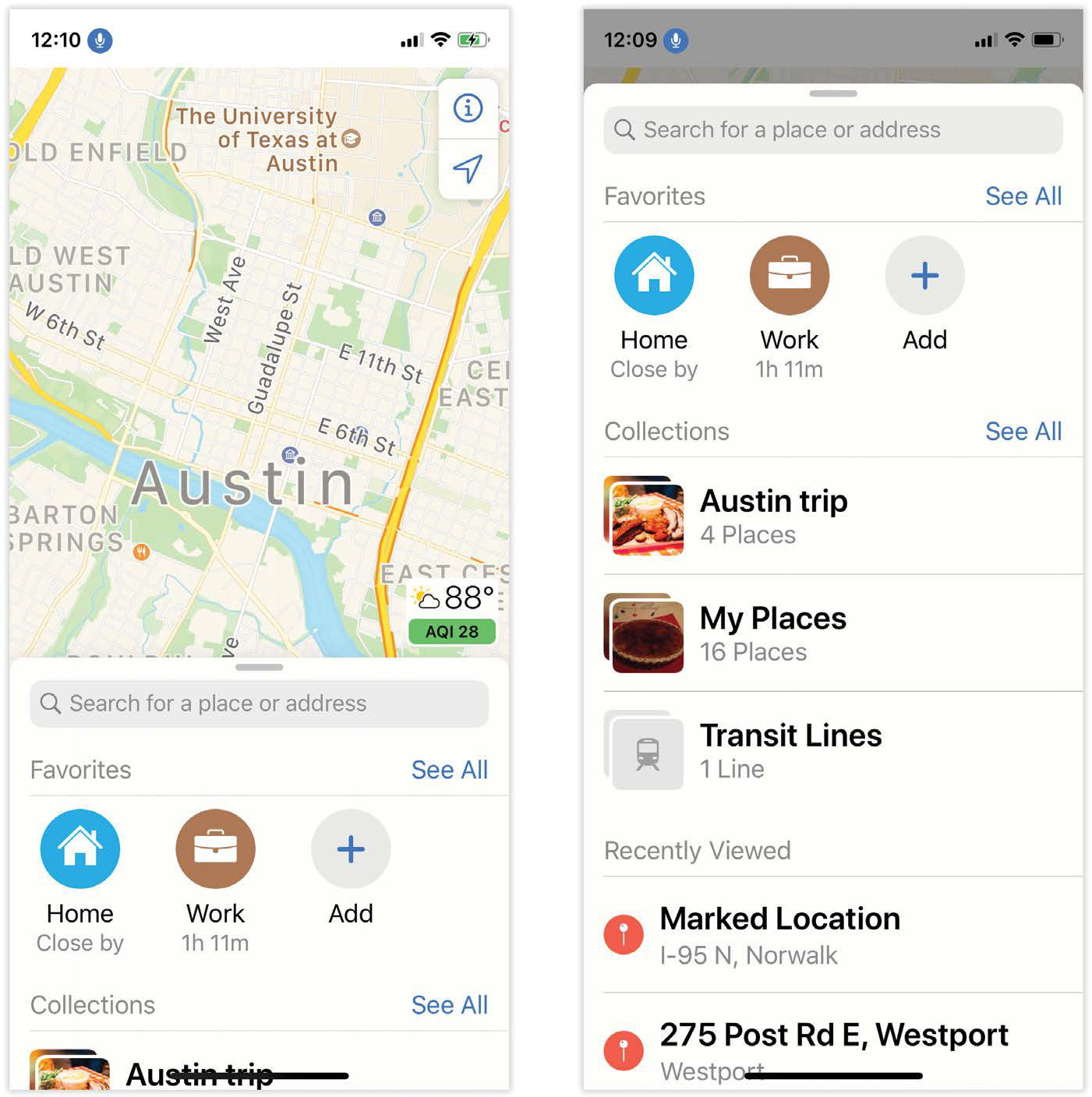
You can say, for example, “Show me the map of Detroit” or “Show me the closest Starbucks” or “Directions to 200 West 79th Street in New York.” Siri shows you that spot on a map; tap to jump into the Maps app.
If you must use the search box, here’s how it works. It shouldn’t be hard to find, since it opens when you open Maps (previous page, left).
Siri Suggestions. One nice thing about Maps is the way it tries to eliminate typing at every step. This first row, new in iOS 13, is a great example. It appears when Siri finds something on your calendar that involves travel. It might be details for a flight, for example, or the name of a restaurant where you’re supposed to arrive soon. Places you’ve recently looked up appear here, too.
Tap to open a details screen, whose prominent feature is a Go button, to start your navigation there.
Favorites are addresses, like Home and Work, that you use often. Tap Add to enter a new one, or tap Add to Favorites on a place’s Location card (“Directions”). (If you’re not seeing Favorites, tap the lower info panel to expand it, as shown on the previous page at right.)
Tap one to jump to its spot on the map, or tap Show All and then swipe to the left to reveal Share and Remove buttons. (This screen’s Edit button lets you reorder the Favorites, too.)
Each Favorite shows, at this moment, how long it will take you to get there. To get going, tap the Favorite’s icon and then tap Go. Two taps!
Business Categories. When you tap into an empty search box, you get icons for Restaurants, Gas Stations, Groceries, and so on. Each expands into a list of nearby options.
TIP
Don’t miss the scrollable list of subcategories or establishments at the very bottom of some of these screens. When you tap Bars, for example, this ticker may list Sports Bars, Cocktail Bars, Pubs, and so on. Oh—and see the little temperature indicator on the map? If you long-press, it sprouts an hourly weather forecast; tap to open the Weather app for that place.
Collections, new in iOS 13, are lists of places you intend to use on a trip, for example. A collection might include your hotel, the conference venue, the restaurants you’ve booked, and the local airport.
To create one, tap New Collection (or See All and then
 ). Name the new collection (“Austin,” for example), hit Create, tap the newly created Collection’s name, hit Add a Place, and go to town, searching and tapping addresses to add. Hit Done.
). Name the new collection (“Austin,” for example), hit Create, tap the newly created Collection’s name, hit Add a Place, and go to town, searching and tapping addresses to add. Hit Done.Recently Viewed. Next on this scrolling screen: a list of searches you’ve recently conducted. You’d be surprised at how often you want to call up the same spot again later.
TIP
If you swipe a listing to the left, you reveal two buttons: Share (send the location info to someone) and Remove (if you intend to elope and don’t want your parents to find out).
All that appears before you tap into the search box itself. Often, though, you’ll wind up typing what you want to find. You can type all kinds of things into the search box:
An address. You can skip the periods (and usually the commas, too). And you can use abbreviations. Typing 710 w end ave ny ny will find 710 West End Avenue, New York, New York. (In this and any of the other examples, you can type a zip code instead of a city and state.)
An intersection. Type 57th and lexington, ny ny. Maps finds the spot where East 57th Street crosses Lexington Avenue in New York City.
A city. Type chicago il to see that city. You can zoom in from there.
A zip code or a neighborhood. Type 10014 or greenwich village.
Latitude and longitude coordinates. Type 40.7484° N, 73.9857° W.
A point of interest. Type washington monument or niagara falls.
A business type. Type drugstores in albany ny or hospitals in roanoke va.
A contact’s name. Maps is tied into Contacts, your master address book (“Contacts”). Start typing a person’s name to see the matches.
A business category. Maps is a glorified national Yellow Pages. If you type, for example, pharmacy 60609, then red bubbles show you all the drugstores in that Chicago zip code. It’s a great way to find a gas station, a cash machine, or a hospital in a pinch. Tap a pushpin to see the name of the corresponding business.
The resulting map shows little pushpins, as well as a scrolling list of search results. Tap either one to open a details screen (the Location card, described in “Directions”).
TIP
You can also create a pin by holding your finger down on the spot.
The Location Card
Whenever you’ve tapped a pin, or the name of some place in a Maps list (like a store, restaurant, or point of interest), the bottom part of the screen lists its information screen—its location “card.” Tap it or swipe up to expand it to full screen.
The location card shows the all-important Directions button. If this is the location for a restaurant or a business, you may get several screens full of useful information, courtesy of Yelp: hours of operation, one-tap links for placing a phone call to the place or visiting its website, customer reviews, photos, delivery and reservation information, and so on.
Links here let you add the place to Favorites, add it to Contacts, share it with other people (via AirDrop, email, text message, Facebook, or Twitter), or Report an Issue (tell Apple about a problem with Maps’ information).

The location card for a restaurant may even offer a Reservations button, so that you can book a table on the spot—if, that is, that eatery participates in OpenTable’s online booking system.
TIP
As you burrow deeper into the screens of the information panel (bottom part of the Maps screen), eventually, you’ll want to get back to the opening Search page. To do that, tap the ![]() over and over until you’re there.
over and over until you’re there.
Directions
Suppose you’ve just searched for a place. Its location card is open. At this point, you can tap Directions for instant directions, using four modes of transportation (below, left):
Drive. You’ll get the traditional turn-by-turn driving directions.
Walk. The app will guide you to this place by foot. You get an estimate of the time it’ll take, too.
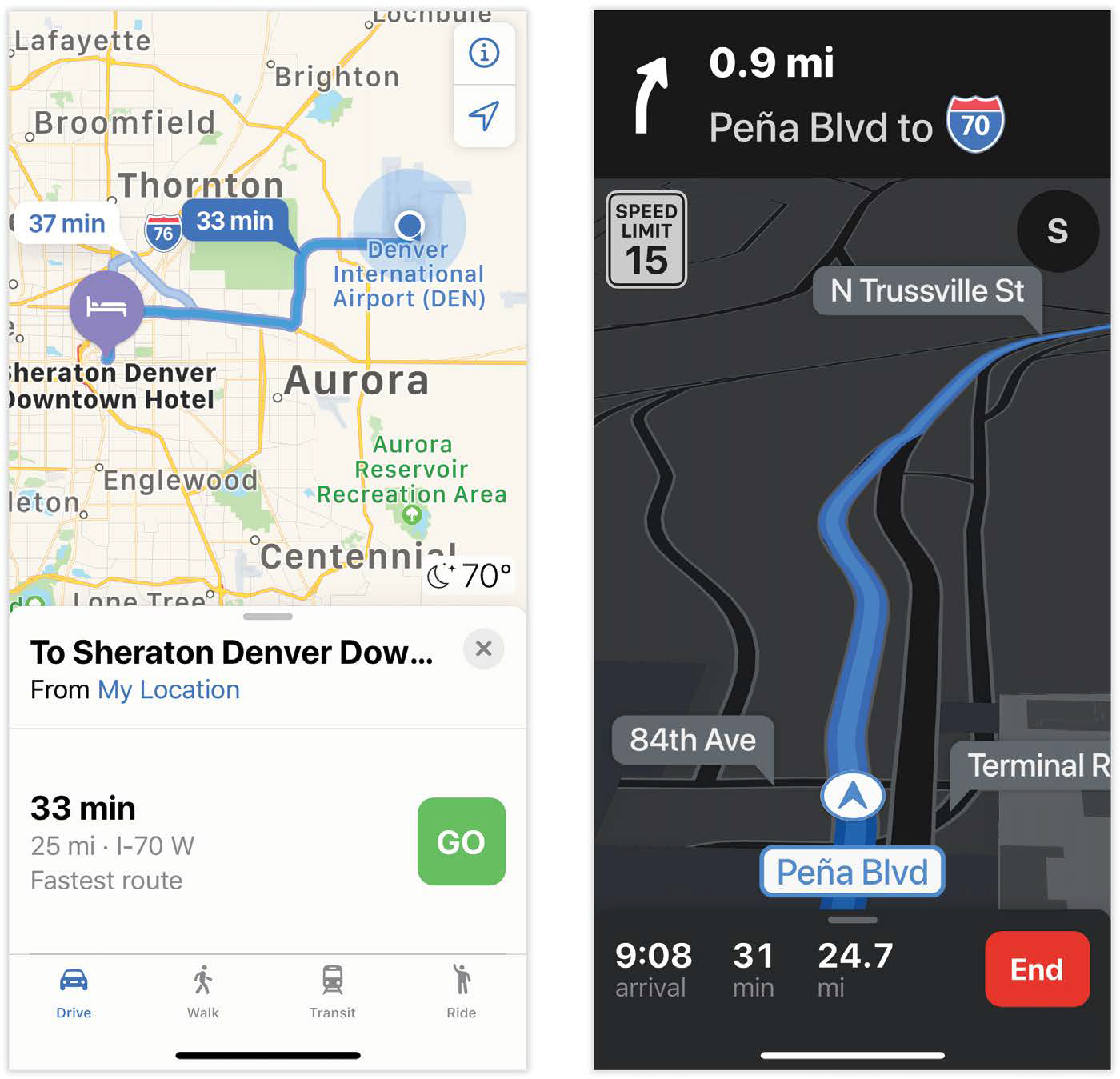
Transit. This button applies if you’re in one of the 60-plus cities, states, and countries for which Apple has public-transportation schedules: buses, subways, and trains. More cities are coming, Apple says.
If you’re lucky enough to be in one of those places, you’ll discover the public-transport directions are surprisingly clear and detailed. You even see the color, letter, and number schemes of that city’s bus or rail system right there in the app. In iOS 13, you get arrival times, station stops, and connections, as well as news about outages, delays, and cancellations.
And if you’re not in one of those cities, Maps helpfully offers a list of other apps in the App Store that do have your transit information. Click View Routing Apps.
Ride means calling an Uber or Lyft driver. (This feature requires that you have the Uber or Lyft app installed and set up.) One tap on Ride shows you the time and price estimates—and offers you a Request button.
In each case, Maps displays an overview of the route you’re about to drive. In fact, it may propose several different routes, each labeled by journey time: 3 hrs 37 min, 4 hrs 11 min, and 4 hrs 33 min, for example.
If you tap one of these tags, the app lets you know the distance and estimated time for that option and identifies the main roads you’ll be on (previous page, left).
In each case, tap Go to see the first instruction. The map zooms in, and Navigation mode begins.
Directions Between Two Other Points
The design of Maps seems to suggest that you’ll always want to navigate somewhere from your current location. But sometimes, you might want directions between two points—when you’re not currently at either one.
First, select your starting point. For example, add a pushpin (“Finding Yourself”), or tap a point-of-interest icon. Tap Directions, and then My Location.
Now you can change the From box (where it currently says My Location), using the same address-searching tactics described in “Orienting Maps”. (At this point, you can also swap your start and end points by tapping the ![]() double arrow.) Finally, tap Route to see the fastest route.
double arrow.) Finally, tap Route to see the fastest route.
Night Mode
If the phone’s light sensor notices that it’s dark in your car, it switches to a dimmer, grayer version of the map. It wouldn’t want to distract you, after all. When there’s enough light, it brightens back up again.
Where You Parked
Maps automatically remembers where you parked, and can guide you back to your car.
How does the phone know when you’ve parked? Because it connects wirelessly to your car over Bluetooth or CarPlay. (So if your car doesn’t have Bluetooth or CarPlay, you don’t get this feature.)
When you turn off the car, the phone assumes you’ve parked it, checks its GPS location, and shows a notification to let you know it’s memorized the spot. (If, that is, this feature is turned on in Settings → Maps → Show Parked Location.)
TIP
If you tap the notification, you get a chance to take a photo of the parking spot or to record notes about it. You also see how long you’ve been parked—handy if you have to feed a meter.
When the time comes to return to your car, the phone makes life as easy as possible. Wake the phone and swipe to the right to view the Maps widget or the Maps Destinations widget. Once you know where you parked, a swipe gets you started finding your way back. (See “Making DNDWD Mandatory” for more on widgets.)
TIP
You can also ask Siri, “Where’s my parked car?” or even, “Dude, where’s my car?”
The car’s location also appears in the Maps app itself, right there in the list of recent locations, and as a reminder in the Today tab of the Notification Center. Tap to begin your journey home.
Traffic
How’s this for a cool feature? Free, real-time traffic reporting. Just tap the ![]() (visible in map or satellite view whenever you’re not in Navigation mode), and then turn on Traffic. Now traffic jams appear as red lines on the relevant roads, for your stressing pleasure; less-severe slowdowns show up in orange.
(visible in map or satellite view whenever you’re not in Navigation mode), and then turn on Traffic. Now traffic jams appear as red lines on the relevant roads, for your stressing pleasure; less-severe slowdowns show up in orange.
Better yet, tiny icons appear, representing accidents, closures, and construction. Tap to see a description bar at the bottom of the screen (like “Accident, Park Ave at State St”); tap that bar to read the details.
If you don’t see any colored lines, it’s either because traffic is moving fine or because Apple doesn’t have any information for those roads. Usually, you get traffic info only for highways, and only in metropolitan areas.
3D Mode
Apple spent two years filming cities in helicopters to create 3D models of major cities and landmarks: San Francisco, New York, Tokyo, London, Paris, Rome, Madrid, Vancouver, San Jose, Cape Town, and Stockholm, for example. Or places like Yosemite National Park, Sydney Opera House, Stonehenge, St. Peter’s Basilica, or the Brooklyn Bridge. These city models are responsible for three cool Maps features: 3D view, Flyover, and Flyover Tours.
When you’ve called up one of these chosen places (and zoomed in enough to see buildings), a 3D button appears. Tap it to tilt into a more 3D view. Now you can conduct your own virtual chopper tour of the city. You can look over and around buildings to see what’s behind them, using the usual techniques:
Drag with one finger to move around the map.
Pinch or spread two fingers to zoom out or in.
Drag two fingers up or down to change your camera angle relative to the ground.
Twist two fingers to turn the world before you.
When you’ve had enough, tap the 2D button in the upper-right corner.
Flyover (iPhone 8 and later)
Flyover is a 3D, augmented-reality, aerial view of the cities and places Apple has scanned as described already. You can use your phone like a viewer, turning your body and moving the phone around in space to change your view.
To begin, tap Flyover (a button that appears on the location card of major cities). Wait for a moment as the phone downloads the photographic models. It’s immersing, completely amazing, and very unlikely to make you airsick.
At this point, you get a Start City Tour button. It starts a crazy treat: a fully automated video tour of that city or place. The San Francisco tour shows you the baseball park, the famous Transamerica Pyramid, the Alcatraz prison island, and so on. It’s slow, soothing, cool, and definitely something paper maps never did. Tap the screen to open the Pause Tour button; tap the ![]() to end the tour.
to end the tour.

Look Around
Google Maps may have Street View, which lets you view a 360-degree photographic representation of any address. But in iOS 13, Apple has its own rival feature, called Look Around. It’s much better than Google’s thing—faster, smoother, higher resolution, almost video-like as you move from one spot to another—but at the outset it works in very few places. (Google’s Street View covers almost every place on earth, including underwater, on mountains, on hiking trails, in the interiors of museums and other important buildings, and even on the International Space Station.)
To try it out, call up a major U.S. city (Honolulu, Las Vegas, San Francisco, and San Jose all have Look Around). Tap Look Around on the location card, or tap the ![]() button at top right (once you’ve zoomed in enough to see street names).
button at top right (once you’ve zoomed in enough to see street names).
And behold: You’re practically in that city, standing in the middle of the street. Drag to “look around.” Pinch or spread two fingers to zoom out or in. Tap any spot to fly there; in this way, you can tour an entire neighborhood without ever leaving the comfort of your couch. It’s a fantastic way to get a feeling for a place before you actually go there, meet someone there, or buy a house there.
You can tap ![]() to fill the screen with the image (next page, bottom). In this view, you can tap labels (street names, place names) to jump there or open the corresponding location cards. (Too cluttery? When you’re not reading about a place of interest, you can tap the place label to view the Hide Labels button.)
to fill the screen with the image (next page, bottom). In this view, you can tap labels (street names, place names) to jump there or open the corresponding location cards. (Too cluttery? When you’re not reading about a place of interest, you can tap the place label to view the Hide Labels button.)
Alternatively, you can tap ![]() to view the image as an inset on the map (below, top). In this latter view, you can tap or drag the map to jump around the city. (Any street shaded in blue has Look Around.)
to view the image as an inset on the map (below, top). In this latter view, you can tap or drag the map to jump around the city. (Any street shaded in blue has Look Around.)
When you’ve completed your tour, tap Done. And hope that Apple hurries up with the next-largest 4,000 U.S. cities.
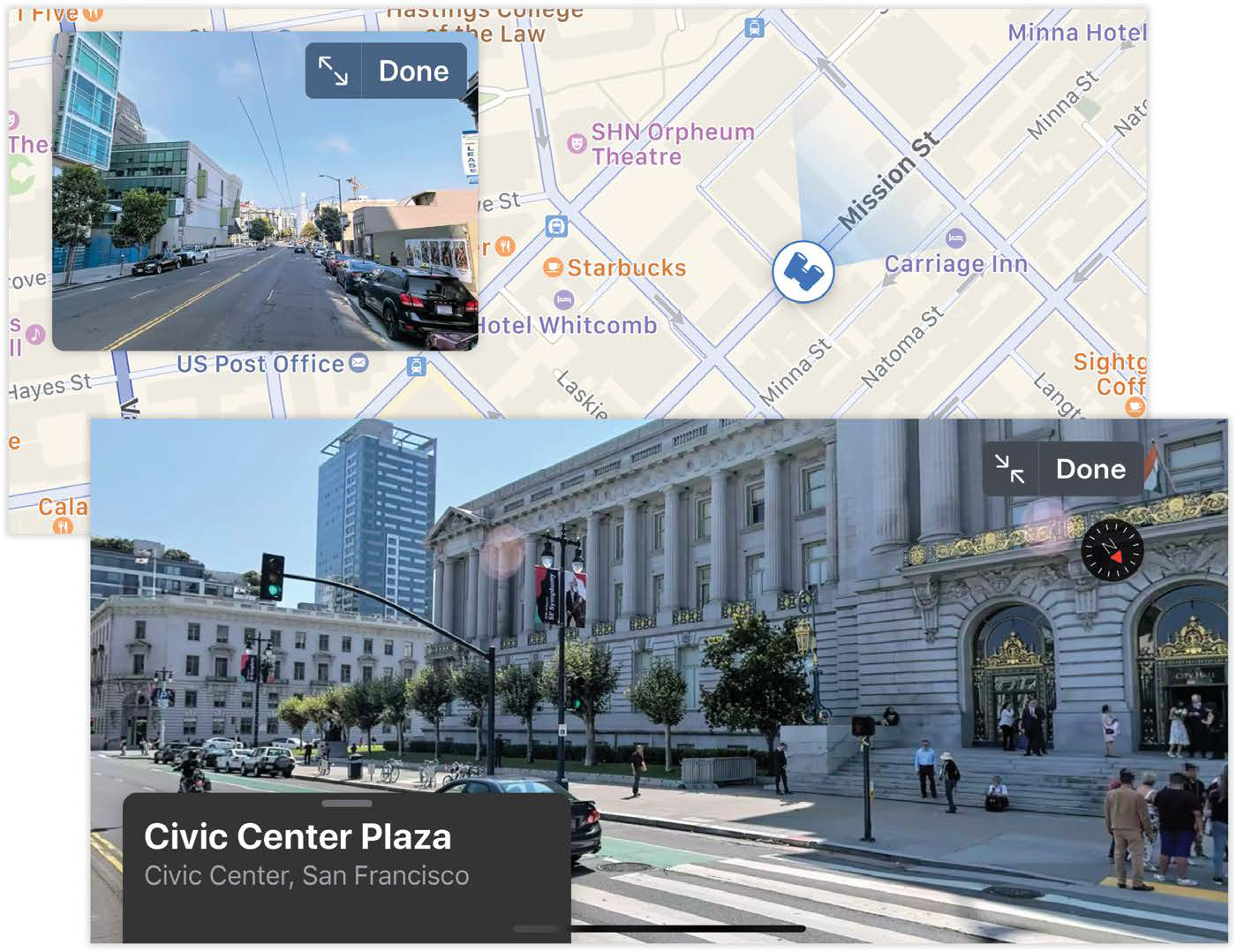
Extensions
There’s one more goody in Maps: Extensions. These are add-on features made by other companies—auto-installed into Maps by their full-blown apps—like Uber, Lyft, Yelp, and OpenTable. The point, of course, is to let you order cars, read restaurant reviews, reserve tables, or buy tickets right from within Maps.
Extensions, for example, are responsible for adding the Ride button described in “Navigation Mode”.
You’ll probably find them quite handy, but maybe not all of them. Fortunately, you can turn off individual extensions in Settings → Maps → Extensions.
Measure
Apple has been putting a lot of engineering (and marketing) effort into making the iPhone a great machine for augmented reality apps (“Augmented Reality (AR) Apps”).
You can find thousands of AR apps on the App Store. But to jump-start things, Apple offers Measure: a virtual tape measure, handy for measuring real-world objects (posters, windows, doors, furniture, staplers), using only the camera on the back.
When you first open Measure, a message says, “Move iPhone to start.” It wants you to move your phone through the air in a squarish pattern. You’re helping it gain its bearings, to calibrate.
Now you’re ready to measure stuff!
If there’s a very obvious square or rectangular object in view, like a mirror/poster/window, the app auto-recognizes it and highlights it in yellow (below, top). Tap that rectangle (or the
 button) to say “Yes, that’s what I want to measure—give me the dimensions!”
button) to say “Yes, that’s what I want to measure—give me the dimensions!”If it’s not completely obvious what you want to measure, aim the tiny white dot so that it’s near the starting point—the spot where you’d hold the end of a traditional measuring tape. (The dot tries to detect potential corners and snap into position.) When it’s lined up, tap
 to “plant” the tape there. Now aim the tiny white dot at the far end of the object or space, and tap
to “plant” the tape there. Now aim the tiny white dot at the far end of the object or space, and tap  again. Voilà: There’s your measurement (previous page, bottom).
again. Voilà: There’s your measurement (previous page, bottom).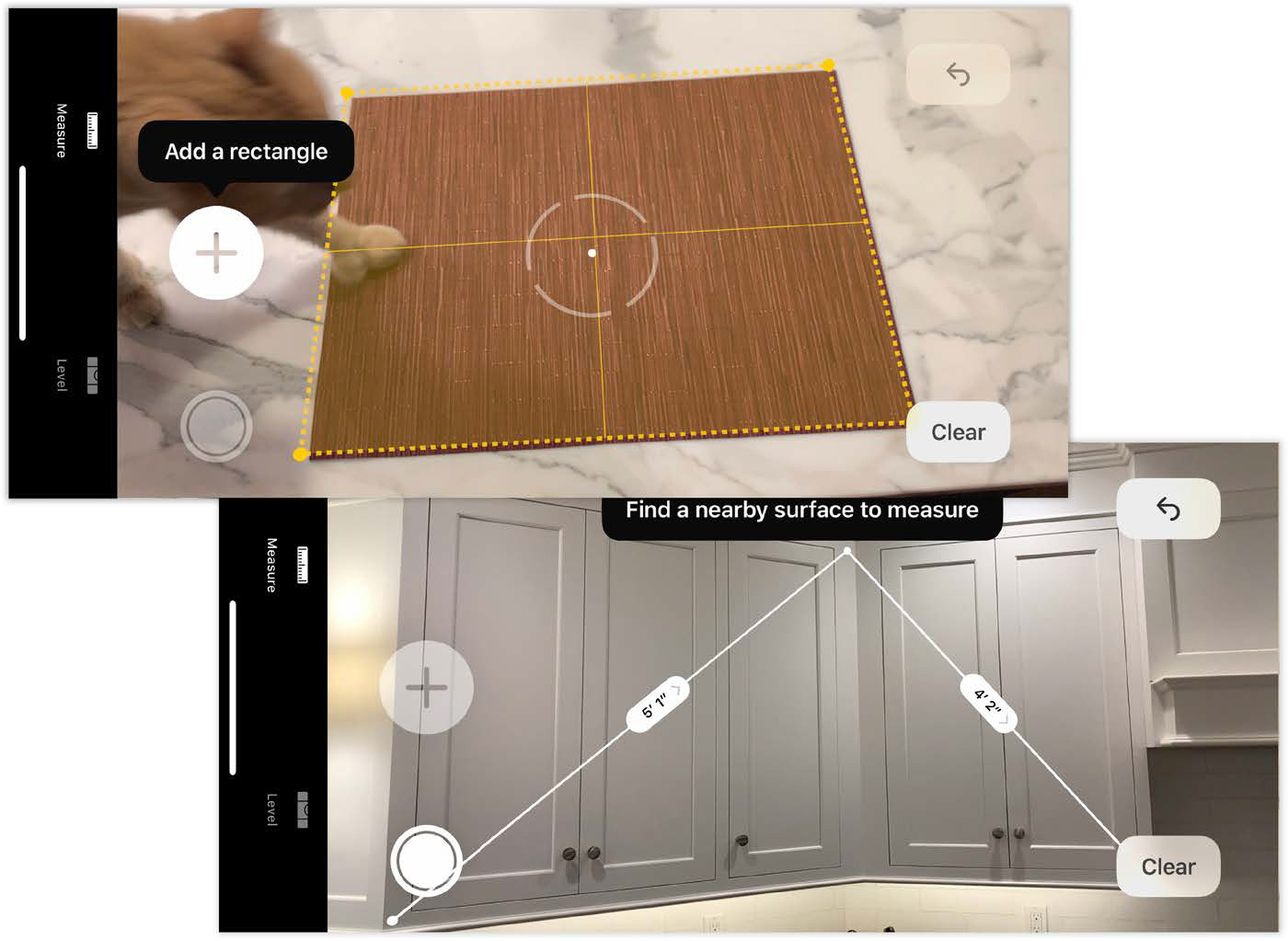
Feel free, at this point, to move the white dot to a third position to repeat the process. In other words, you can create as many additional measurements as you like on the same screen.
The measurement readout appears on a tiny tab in the middle of the straight measurement line. But if you tap that little tab, you open a pop-up bubble that offers not only a big-type version of the same measurement (below, left), but also the equivalent in metric units (or imperial units, if you were using metric). And if you’ve measured a rectangular shape, then this bubble also gives you the area and the diagonal distance! You’ll never have to do math again.
At any point, you can tap ![]() to capture the screen image with the measurements in place. You can send the resulting photo to your builder, interior designer, or orthodontist.
to capture the screen image with the measurements in place. You can send the resulting photo to your builder, interior designer, or orthodontist.
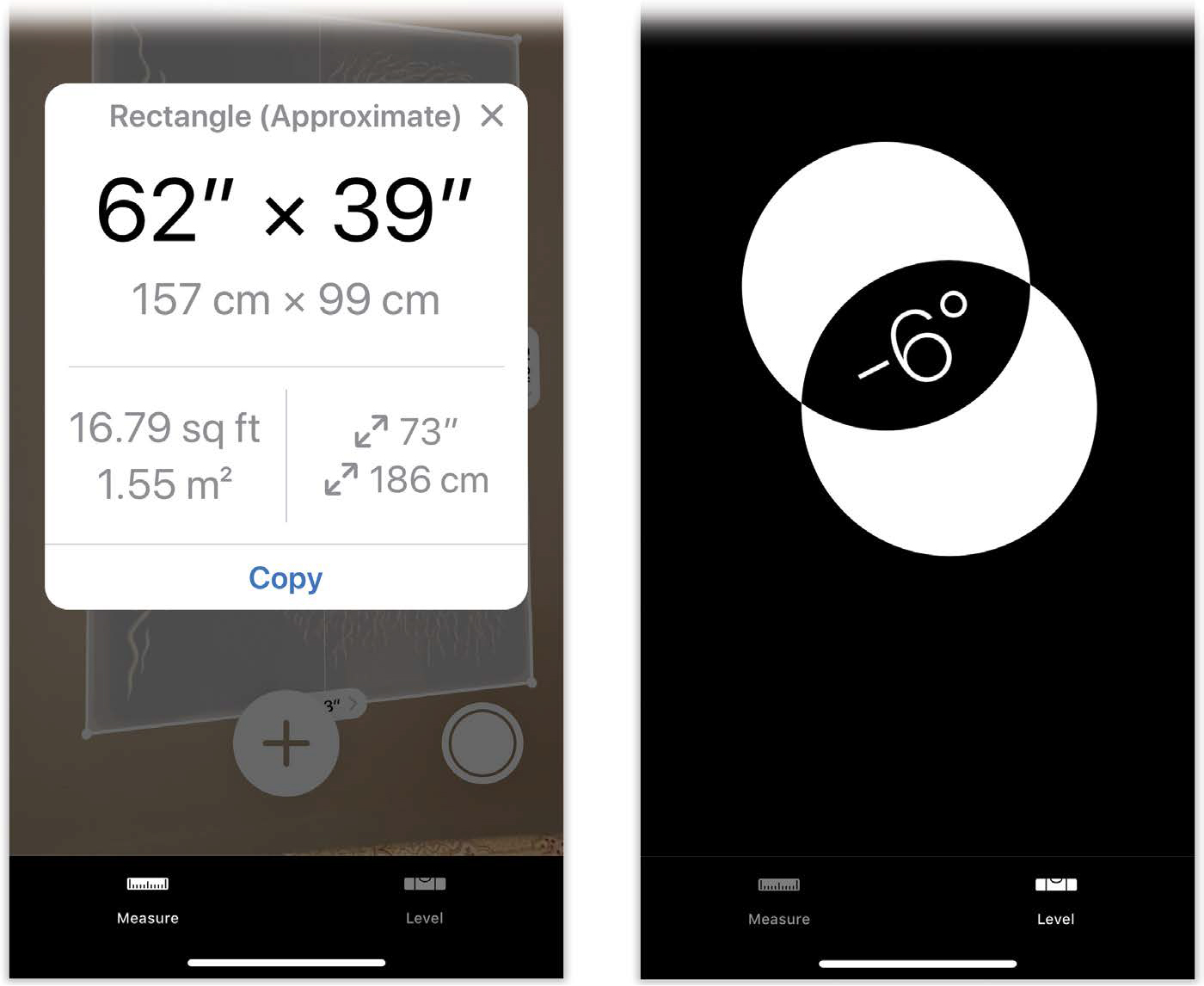
You’ll discover fairly quickly that Measure’s measurements aren’t always perfectly precise; you are, after all, just pointing your phone at things. It’s fantastic for measuring the space where you’re considering putting a bed or a chair, but don’t rely on it if you’re building a Mars lander.
The Level
Measure has another trick up its sleeve, too: It can also act as a carpenter’s level! The next time you need to hang a picture, prop up a wobbly table, or raise a barn, you’ll now know when you’ve got things perfectly horizontal or vertical.
This isn’t a new feature in iOS—it was part of the Compass app for years—but it is in a new place. In the Measure app, tap Level to get to it.
TIP
On the Home screen, you can also long-press the Measure app’s icon. The shortcut menu offers you direct access into the two modes: Measure and Level.
You can measure things’ levelness in two dimensions:
Right/left. Hold the iPhone upright (against a picture you’re hanging, say), and tilt it left and right. When it’s perfectly upright, the readout says 0 degrees and the bottom half of the screen turns green.
Forward/back. Hold the phone upright and tip it away from or toward you. Once again, “0 degrees” and green mean “level.”
Perfectly flat. Hold the phone on its back, screen facing the sky. When the two circles merge (facing page, right), you’ll know you’ve got it perfectly level. You could, for example, put the iPhone on a table you’re trying to adjust, using its gauge to know how close you’re getting as you wedge something under its short leg.
Level doesn’t have to be the zero point, either. You can tilt the phone to any angle and declare that to be the zero point—by tapping the screen.
News
The News app does just what Apple promises: It “collects all the stories you want to read, from top news sources, based on topics you’re most interested in.” Apple employs human editors—rather than software robots—to choose the stories in the Top Stories and Top Videos sections. Everybody sees the same stories here, no matter what their political leanings; in theory, this approach minimizes the triumph of fake news and clickbait.
If you see a bunch of news headlines right off the bat, well, sweet; you’re the beneficiary of iCloud syncing (“iCloud Sync”). News has inherited your taste in news from iOS 12 or some other Apple gadget.
If this is the very first time you’ve ever opened News, though, tap Continue on the welcome screen. You’re hit with today’s headlines, beautifully laid out. It’s like a specialized newspaper that’s been lovingly cobbled together from all sorts of websites, magazines, and real newspapers.
This is the Today tab (below, left). Scroll down far enough, and you’ll discover that your “front page” is broken up into sections like Top Stories (chosen by those human editors), Trending Stories (chosen by algorithm based on popularity), For You (stories that match your interests—described in a moment), Top Videos, and so on. Eventually, you scroll down into topic areas like Politics, Sports, and Movies, plus any super-specialized topics you choose yourself.

Once you’ve tapped to open a story (facing page, right), using News is simplicity itself. Swipe vertically to scroll through an article, or horizontally to pull the next article into view.
The middle tab, News+, is the home for Apple’s $10-a-month “Netflix for magazines” service. It gives you full access to current and past issues of 300 magazines and newspapers: The Atlantic, Better Homes & Gardens, Entertainment Weekly, Esquire, GQ, National Geographic, New York Magazine, The New Yorker, Parents, People, Runner’s World, Sports Illustrated, Vanity Fair, Vogue, Wired, The Wall Street Journal, and many others.
The Following tab (facing page, middle), though, is where you make News your own. Here’s where you specify which publications, websites, and topics (tech, business, politics, fashion, and so on) you want to follow in your News app. It boils down to these sections:
Saved Stories is where you find articles you’ve seen and bookmarked.
History lists every story you’ve seen recently.
Channels & Topics offers a very tall scrolling list of favorite online publications (The New York Times, Wired, The New Yorker, and hundreds more). Tap to dive into that publication’s latest stuff. You can search for topics, too.
Suggested by Siri offers a few starter categories, based on iOS’s observations about the kinds of news you like to read; tap
 to open that category, or
to open that category, or  to add this category to your For Your collections. Swipe left and tap Ignore if that topic doesn’t interest you.
to add this category to your For Your collections. Swipe left and tap Ignore if that topic doesn’t interest you.Notifications lets you set things up so that only certain kinds of news stories grab your attention with an iPhone notification (“Notifications”).
Discover Channels and Topics brings you to the setup screen: a massive, nearly endless list of magazine, newspaper, and website thumbnails. Tap to say “Yes, please include stories from these pubs in what you show me.”
News no longer offers a list of topics that may interest you—the Cleveland Cavaliers, say, or Tesla cars, or seafood recipes. But you can still let News know your preferences—in a couple of ways:
Use the search box. At the top of the Channels screen, a search box lets you search for topics, stories, or publications. In the search results, tap
 for each item you want News to find for you.
for each item you want News to find for you.Just use News. As you use the News app, it notices which kinds of headlines you tap, read, or “favorite” (by tapping
 → Suggest More Like This). It will, in other words, learn your interests—and tailor its reporting accordingly.
→ Suggest More Like This). It will, in other words, learn your interests—and tailor its reporting accordingly.
These operations make new story categories appear on the Today tab.
And that’s it: Suddenly, you have a beautiful, infinite, constantly updated, free magazine stand, teeming with stories that have been collated according to your tastes. It’s all free, although you’re not getting the listed publications in full—usually you’re offered just a few selected stories.
TIP
If you anticipate that you’ll be spending time in the living hell known as Offline mode (like on a subway, sailboat, or airplane), you can save some stories for reading later. To do that, tap ![]() and then Save Story. You’ll find your saved stories on the Following tab, under Saved Stories.
and then Save Story. You’ll find your saved stories on the Following tab, under Saved Stories.
Notes
The Notes app is great for jotting down (or dictating) lists, reminders, brainstorms, recipes, directions, serial numbers, and so on.
These days, a Notes page can include checklists of to-dos, photos, maps, web links, or sketches you draw with your finger. You can even share notes wirelessly with another iPhone fan, so you can collaborate.
The modern-day Notes app offers full font and paragraph formatting. You can create tables. You can scan documents and then annotate them, right from within a note. And, of course, the powerful Access Notes from Lock Screen option means your phone is now ready, at a finger-tap’s notice, to receive your jotted or scanned wisdom—without even having to unlock the phone first. See “Closing the Control Center”.
As always, any changes you make in Notes are automatically synchronized to all your other Apple gadgets.
To get started, tap ![]() to start a new blank note. The keyboard appears so you can begin typing.
to start a new blank note. The keyboard appears so you can begin typing.
TIP
You can also send text from other apps into Notes. For example, in Mail, select some text you’ve typed into an outgoing message; in the command bar, tap Share. Similarly, you can tap a Mail attachment’s icon; tap Add to Notes in the Share sheet. In each case, your selection magically appears on a new Notes page.
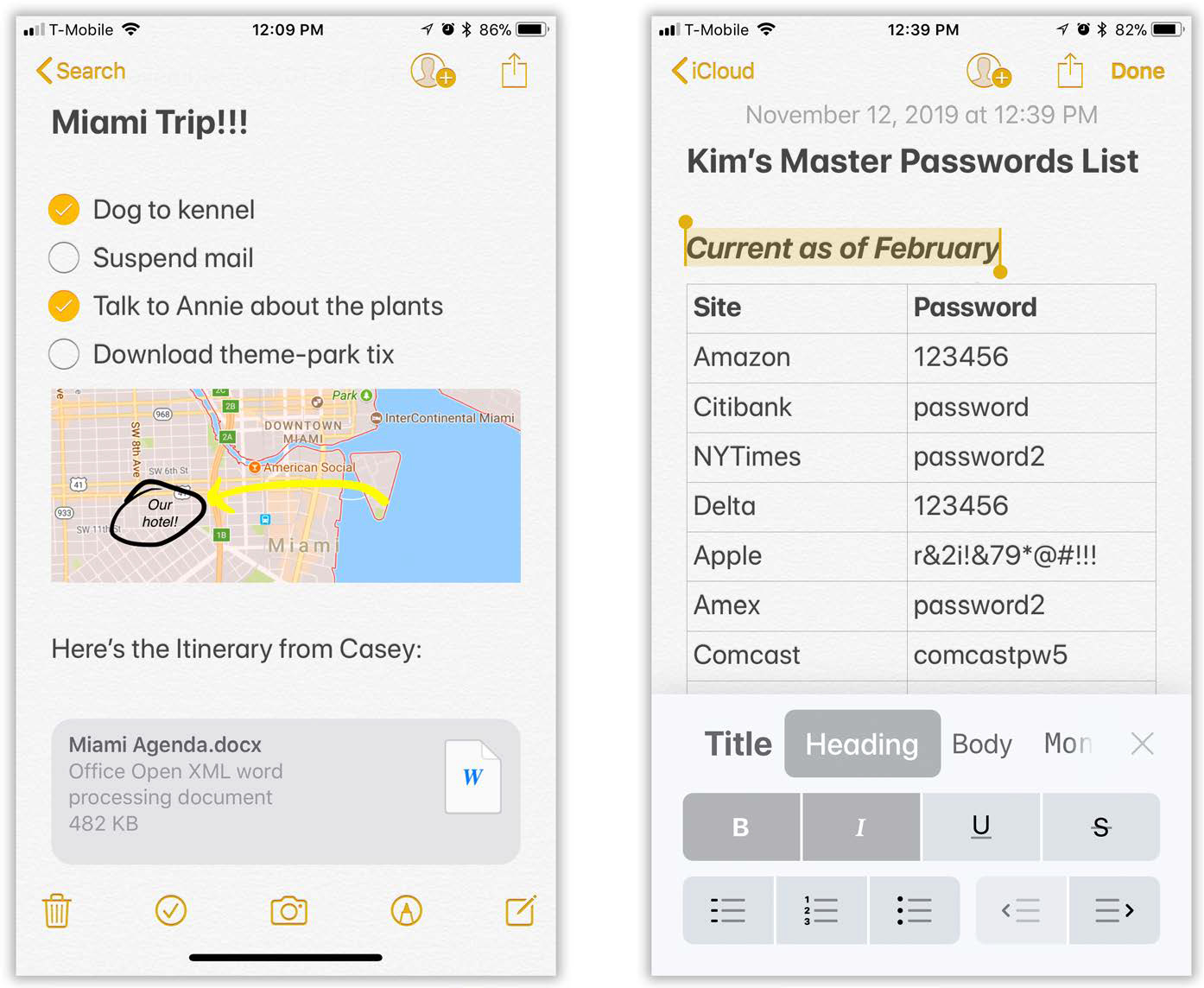
When you tap Done, the keyboard goes away, and a handy row of icons appears at the bottom of your Notes page. You can trash the note (![]() ); add a checklist to it (
); add a checklist to it (![]() ); add a graphic to it—photo, video, or scanned document (
); add a graphic to it—photo, video, or scanned document (![]() ); add a sketch (
); add a sketch (![]() ); or start a new note (
); or start a new note (![]() ).
).
The Share ![]() button is always available too, at the upper right. Tap it to print your note, copy it, or send it to someone by email, text message, AirDrop, and so on. For example, if you tap Mail, the iPhone creates a new outgoing message, pastes the first line of the note into the subject line, and pastes the note’s text into the body. Address the note, edit if necessary, and hit Send. The iPhone returns you to Notes. (See “The Share Sheet” for more on the sharing options.)
button is always available too, at the upper right. Tap it to print your note, copy it, or send it to someone by email, text message, AirDrop, and so on. For example, if you tap Mail, the iPhone creates a new outgoing message, pastes the first line of the note into the subject line, and pastes the note’s text into the body. Address the note, edit if necessary, and hit Send. The iPhone returns you to Notes. (See “The Share Sheet” for more on the sharing options.)
Herewith: A tour of the five buttons that appear above the keyboard. They’re your gateway to everything you can put on a note: tables, text and paragraph formatting, lists, photos, sketches, and scanned documents.
Tables
When you tap ![]() , you get a table with two columns and two rows. Tap in a cell and then start typing. To move to the next cell, tap Next on the keyboard (or tap with your finger).
, you get a table with two columns and two rows. Tap in a cell and then start typing. To move to the next cell, tap Next on the keyboard (or tap with your finger).
Poke around long enough, and you can find controls for just about every formatting tool you’d ever need in a table (except the ability to manually adjust column widths and the ability to format the cell borders).
The keys to most of it are the tiny handles (![]() and
and ![]() ) that appear when you tap inside a cell:
) that appear when you tap inside a cell:
Add or delete columns and rows. Tap inside a cell to make the
 and
and  buttons appear. Tap
buttons appear. Tap  to make the command bar appear, including Add Column and Delete Column; tap
to make the command bar appear, including Add Column and Delete Column; tap  to make the Add Row and Delete Row buttons appear. (If you’re typing in the lower-right cell, tapping Return also makes a new row.)
to make the Add Row and Delete Row buttons appear. (If you’re typing in the lower-right cell, tapping Return also makes a new row.)Move a row or column. Tap
 or
or  to highlight the corresponding row or column; now you can drag it to a new spot.
to highlight the corresponding row or column; now you can drag it to a new spot.Copy or paste cells. Double-tap (or hold your finger down on) a cell to make the Select button appear. Once you’ve tapped it, you can drag the selection handles to expand the highlighting. The Cut, Copy, and Paste buttons appear in the command bar, along with the
 (bold, italic, underline) controls, Look Up, Spell, and other controls.
(bold, italic, underline) controls, Look Up, Spell, and other controls.Convert text into a table. Select the text, and then tap the table (
 ) button. The selected text winds up in the first column—one cell per paragraph.
) button. The selected text winds up in the first column—one cell per paragraph.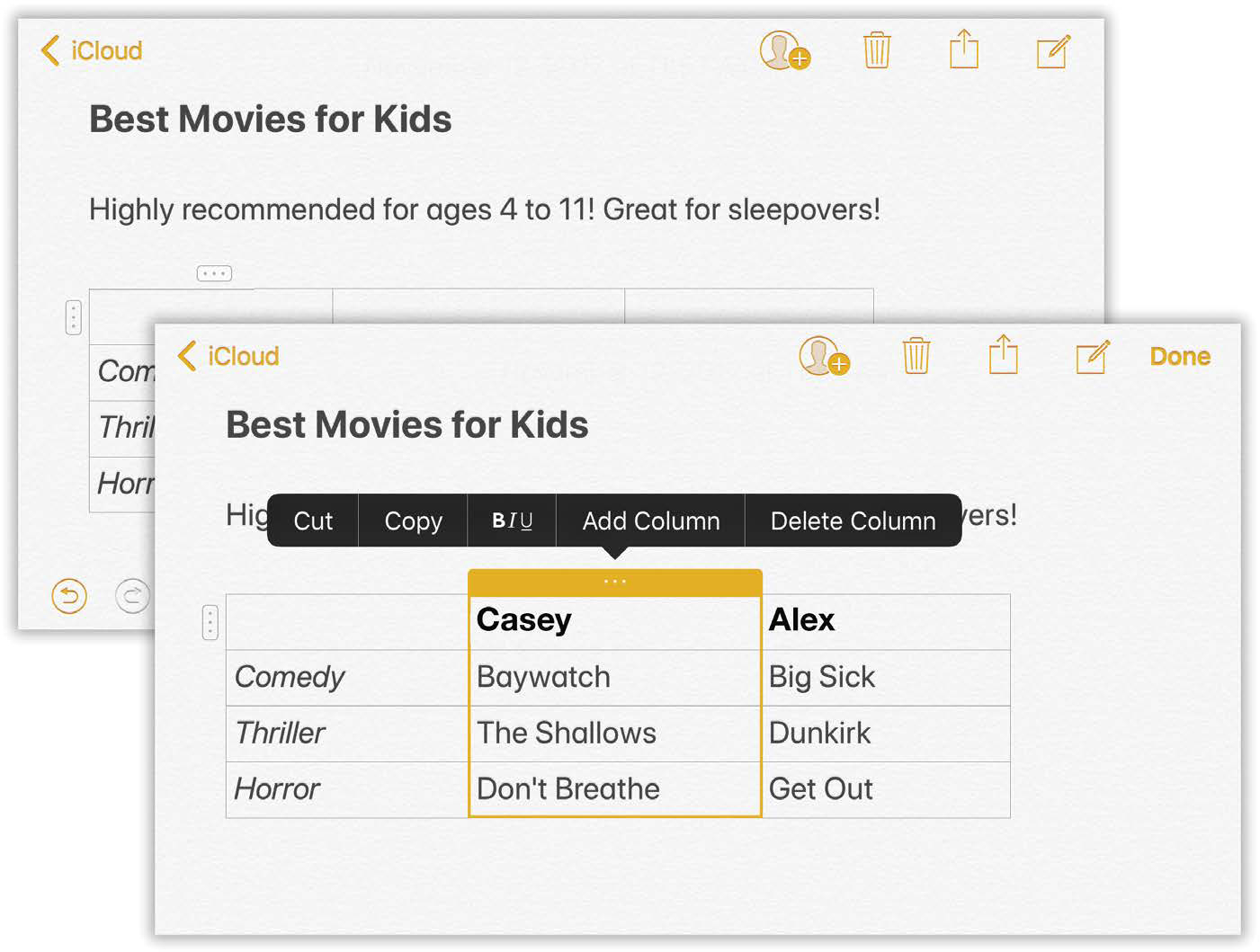
Convert table into text. Tap inside a cell, and then tap the
 button. Choose Convert to Text. (This menu also includes Copy Table, Delete Table, and Share Table.)
button. Choose Convert to Text. (This menu also includes Copy Table, Delete Table, and Share Table.)
Text and Paragraph Formatting
A wide array of text-formatting options await in the Notes app. Once you’ve tapped ![]() to open the formatting panel, you can try out any of these options:
to open the formatting panel, you can try out any of these options:
Paragraph styles. Hey, there are style sheets! You can create a Title (big and bold type), a Heading (bold), Body text (normal), and Monospaced (every character is the same width, even I and W—useful when you’re trying to line up characters on different rows).
Character formatting. The B, I, U, and S refer to bold, italic, underline, and strikethrough styles.
Lists. The first buttons on the bottom row create dashed lists, auto-numbered lists, and automatically bulleted lists.
Paragraph indentation. The final two buttons move the entire selected paragraph to the right or to the left, indenting or outdenting it.
Checklists
The ![]() button creates a checklist (“Tables”, left). Every paragraph sprouts a circle—which is actually a checkbox. Tap it to place a checkmark in there. (Should completed items sort to the bottom? See “Reminders”.)
button creates a checklist (“Tables”, left). Every paragraph sprouts a circle—which is actually a checkbox. Tap it to place a checkmark in there. (Should completed items sort to the bottom? See “Reminders”.)
This feature is fantastic for lists: to-do lists, packing lists, movies to see, gift tracking, party planning, job hunting, homework management, and so on.
Each time you press Return, you create a new checklist item. But you can also select existing paragraphs and then tap ![]() , turning them into a checklist after the fact. And in iOS 13, you can swipe right or left to indent or outdent a line, or drag one into a new list position using its circle as a handle.
, turning them into a checklist after the fact. And in iOS 13, you can swipe right or left to indent or outdent a line, or drag one into a new list position using its circle as a handle.
Scan a Document
Here’s where things get good. You can now use your iPhone as a high-resolution, supersmart document scanner. You can capture a letter, an article, a receipt. If you scan a contract, you can add your signature to it and send it back. The fun begins when, on any Notes page, you tap ![]() . Then:
. Then:
From the pop-up menu, tap Scan Documents.
The camera springs into action, with the instruction that you should “Position the document in view.”
Tap the
 , and choose the type of scan you want.
, and choose the type of scan you want.Your options are Color, Grayscale (shades of gray), Black & White (no shades of gray), and Photo (a regular snapshot, without any document features). For most printed documents, Grayscale is the cleanest, most space-efficient choice.
Hold the phone up high enough that you can see the entire page.
The document scanner can snap pages of any size, from little receipts to whole newspaper sheets that would be tough to feed into a scanner.

Using yellow highlighting (below, left), the iPhone tries to find the edges of the page. Take a moment to marvel as it automatically straightens the image and fixes any perspective errors. In other words, even if you’re shooting the page at an angle (to avoid shadows, for example), the app is smart enough to produce a perfectly crisp, rectangular page image.
When you’re holding the phone steady, the camera snaps automatically. (If you’re impatient, tap the
 button or press one of the volume keys. The app displays the cropping screen, so you can adjust the page boundaries yourself.)
button or press one of the volume keys. The app displays the cropping screen, so you can adjust the page boundaries yourself.)The captured image appears briefly and then shrinks down to the lower-left thumbnail corner—and you’re instantly ready to snap another page. Thanks to the automatic snapping, you can chug through a multipage document pretty quickly.
When you’ve scanned enough, tap Save. Your work here is done.
Or, if you’d like to fine-tune the results, read on:
Tap the thumbnail (lower-left corner of the screen).
The scanned image opens so you can make adjustments. For example, the
 button lets you change your mind about the decision you made in step 2 (facing page, center). If you tap
button lets you change your mind about the decision you made in step 2 (facing page, center). If you tap  , you can use the four round handles to adjust the page boundaries, cropping out more or less background (facing page, right). If you snapped the page at a slight angle, this is your chance to correct the perspective.
, you can use the four round handles to adjust the page boundaries, cropping out more or less background (facing page, right). If you snapped the page at a slight angle, this is your chance to correct the perspective.Here, too, you can tap
 to rotate the scan 90 degrees—or
to rotate the scan 90 degrees—or  to delete it. Or tap Retake to reshoot just this page.
to delete it. Or tap Retake to reshoot just this page.Tap Done and then Save. You return to the Note that now contains the scanned images.
If you tap a scanned page thumbnail to open it, you can have endless fun:
Use the
 ,
,  ,
,  , and
, and  icons to revisit the choices you made in step 4.
icons to revisit the choices you made in step 4.Tap
 to scan a new page to add to the existing ones.
to scan a new page to add to the existing ones.Tap
 and then Markup to annotate the scan (adding your signature or highlighting, for example), using the tools described in “Add a Sketch”.
and then Markup to annotate the scan (adding your signature or highlighting, for example), using the tools described in “Add a Sketch”.Tap
 and then Create PDF to convert the finished scan into a PDF page, ready to send (by tapping
and then Create PDF to convert the finished scan into a PDF page, ready to send (by tapping  again).
again).
Once you’ve given the Scan feature a try, you may well consider it one of iOS’s finest achievements.
Add a Photo to a Note
There are more goodies hiding behind the ![]() button on every Notes page, above the keyboard. The pop-up menu offers Take Photo or Video, which opens the Camera app, and Photo Library, which opens your Photos app. Either way, the resulting photo or video lands right there in the Notes page you’re working on. Incredibly handy. (Try inserting labeled face shots of people whose names you keep forgetting at work!)
button on every Notes page, above the keyboard. The pop-up menu offers Take Photo or Video, which opens the Camera app, and Photo Library, which opens your Photos app. Either way, the resulting photo or video lands right there in the Notes page you’re working on. Incredibly handy. (Try inserting labeled face shots of people whose names you keep forgetting at work!)
TIP
Should new photos and videos you take also wind up in your Photos app? That’s up to you, thanks to the Settings → Notes → Save to Photos option.
Add a Sketch
Sometimes, only a freehand drawing will do—and in Notes, you can draw with your finger! If you tap the ![]() icon, you summon the new, improved iOS 13 artist’s kit (below, left).
icon, you summon the new, improved iOS 13 artist’s kit (below, left).
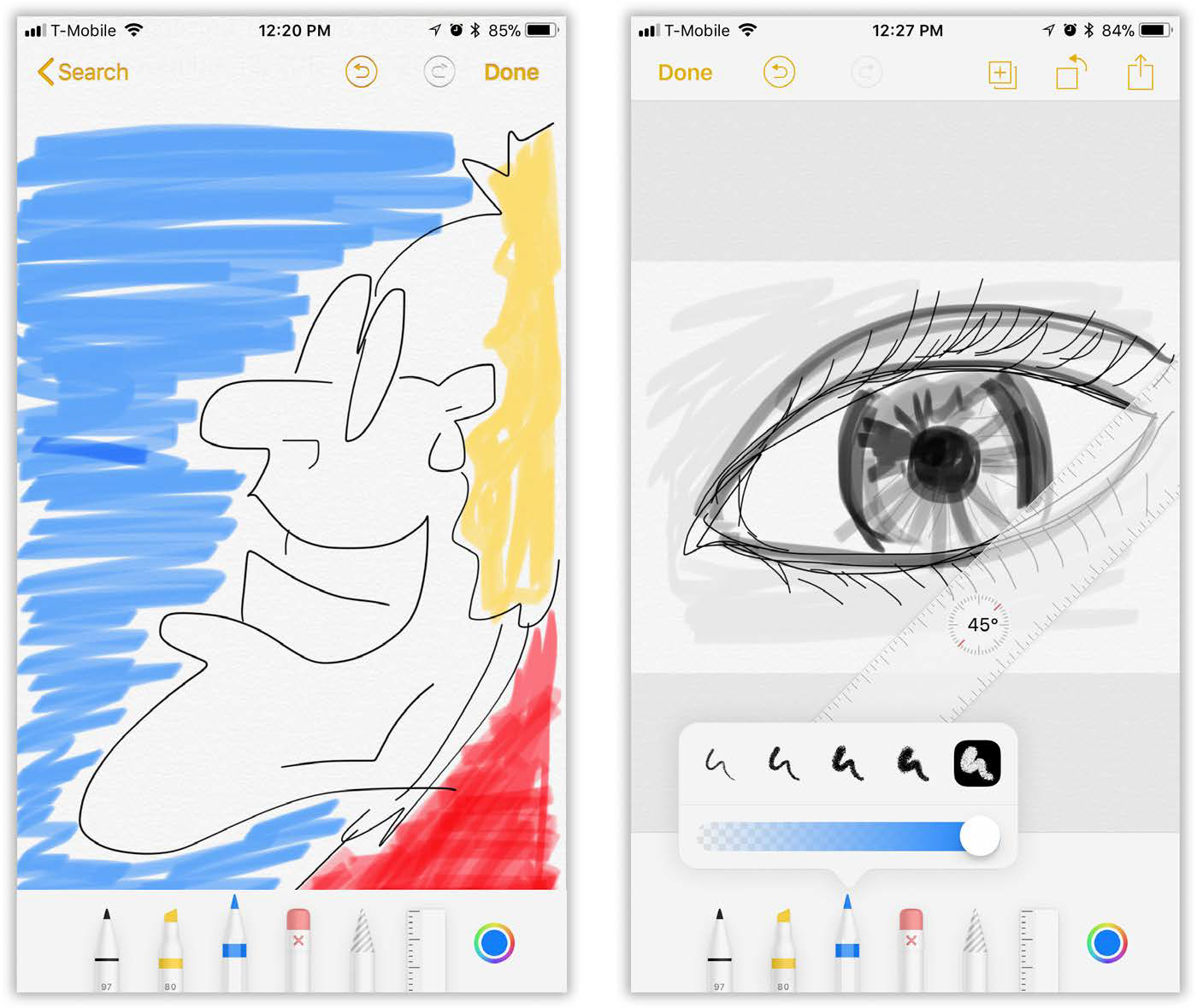
In the following tour, note that you can tap a tool to produce a pop-up palette of potentially pleasing possibilities. For the Pen, Highlighter, and Pencil, for example, the pop-up panel offers five line thicknesses, plus a slider that controls the opacity of the lines you draw (facing page, right).
You can use the Undo button (![]() ) as often as you mess up. It’s an infinite Undo; tap it enough times, and you go all the way back to the blank, untouched image.
) as often as you mess up. It’s an infinite Undo; tap it enough times, and you go all the way back to the blank, untouched image.
To choose a color for the next line you draw, tap ![]() . You get a palette of 144 shades. Each drawing tool remembers its color from note to note; that way, you’ll always have a yellow highlighter or a red pencil handy.
. You get a palette of 144 shades. Each drawing tool remembers its color from note to note; that way, you’ll always have a yellow highlighter or a red pencil handy.
TIP
If you have a 3D Touch iPhone (“Charging the iPhone”), the lines you draw get thicker as you press harder—just as with real pens, highlighters, and pencils!
Pen. Drag on the image to create lines in the color you’ve chosen from the
 panel.
panel.Highlighter creates translucent lines, just like a high-school highlighting marker.
Pencil. Just like the Pen, except that the edges of the lines have a rougher, more graphite-looking texture.
Eraser. The pop-up panel offers two choices: Pixel Eraser (drag with your finger to erase pieces of lines) or Object Eraser (tap to delete entire lines).
Selection Pen. Drag your finger around lines or shapes you’ve made to enclose them with animated dotted-line selection boundaries. At this point, you can drag the whole selected mass into a new position on the screen.
Ruler. This is a surprisingly sophisticated tool. To use it, put two fingers on the ruler itself on the screen, and twist them to the angle you want. (As you twist, the app shows you the current angle off the horizontal.) Then you can “draw against” it for perfect straight lines.
Text or objects. The
 is part of iOS 13’s standard drawing kit, but you don’t see it when you’re sketching; only when you’re annotating a photo or graphic (in Notes, Mail, Messages, and so on). It produces a choice of canned goodies you can add to the image:
is part of iOS 13’s standard drawing kit, but you don’t see it when you’re sketching; only when you’re annotating a photo or graphic (in Notes, Mail, Messages, and so on). It produces a choice of canned goodies you can add to the image:Text: A text box appears on the photo, saying “Text.” Drag the tiny blue handles to adjust the shape of the box; drag inside to move the box; or twist two fingers to rotate it. Double-tap it (or tap it and then tap Edit) to open the keyboard; type what you want it to say. Tap the photo to put away the keyboard. Tap the text box and then tap
 to choose font, size, and paragraph justification options.
to choose font, size, and paragraph justification options.Signature: Tap to insert a handwritten signature. (And where do these stored signatures come from? You’ve tapped Add or Remove Signature and then
 , and then used your finger to write your name.)
, and then used your finger to write your name.)Magnifier: Tap to slap a magnified circular area onto your photo—great for calling out a detail. Drag the blue handle to adjust the circle’s size; drag the green one to adjust the degree of magnification inside it. And drag inside the circle to move it.
NOTE
You’re not enlarging this for your own editing purposes; this magnified area will stay magnified when you send the photo. It’s for calling your correspondent’s attention to some detail.
Square, circle, speech bubble, arrow: Tap one to place it on your photo. Then tap
 to see some choices for line thickness and filled-in-ness. Drag blue dots to change size, or green ones to change shape—for example, the angle and direction of the speech balloon’s “where it’s coming from” angle, or the curvature of the arrow.
to see some choices for line thickness and filled-in-ness. Drag blue dots to change size, or green ones to change shape—for example, the angle and direction of the speech balloon’s “where it’s coming from” angle, or the curvature of the arrow.
TIP
In Notes, you can set up a lined background for new sketches. Choose ![]() , scroll up, and then Lines & Grids. You can have your notes start out with lines (three different spacings) or graph-paper grids (three grid sizes).
, scroll up, and then Lines & Grids. You can have your notes start out with lines (three different spacings) or graph-paper grids (three grid sizes).
If you want your selection to apply to every new note you create, make your decision in Settings → Notes → Lines & Grids.
Sharing Notes
You and a buddy (or several) can edit a page in Notes simultaneously, over the internet. It’s great when you and your friends are planning a party and brainstorming about guests and the menu, for example. Also great for adding items to the grocery or to-do list even after your spouse has left the house to get them taken care of.
In iOS 13, in fact, you can share an entire folder of notes—a handy way to get started with a project’s worth of info:
Share one open note. Tap
 at the top of the screen. On the Add People screen, specify how you want to send the invitation: by message, email, Facebook, Twitter, or whatever.
at the top of the screen. On the Add People screen, specify how you want to send the invitation: by message, email, Facebook, Twitter, or whatever.Share a folder full. On the folder list (“Notes Folders”), tap the folder name to open it. Tap
 at the top of the screen; then Add People.
at the top of the screen; then Add People.
In either case, the Add People screen appears. Tap Share Options to indicate whether the people you’re inviting are allowed to see these notes or see and edit them. Then specify how you want to send the invitation: by message, email, Facebook, Twitter, or whatever.
Once your collaborators receive and accept the invite, they can begin reading the note(s), or editing them (if you gave permission), right alongside their own notes in Notes.
The live editing isn’t as animated as it is in, for example, Google Docs—you don’t see letter-by-letter typing—but other people’s edits do appear briefly in yellow highlighting.
Once you’ve shared a note, the icon at the top changes to ![]() , and a matching icon appears next to the note’s name in the master list. At any time, you can stop sharing the note—or add more people to its collaboration—by tapping that
, and a matching icon appears next to the note’s name in the master list. At any time, you can stop sharing the note—or add more people to its collaboration—by tapping that ![]() icon again and editing the sharing panel that appears.
icon again and editing the sharing panel that appears.
Locking Notes
You can password-protect individual notes—a great feature, suitable for listing birthday presents you intend to get for your nosy kid, the formula for your top-secret invisibility potion, or your illicit lovers’ names.
Note that you generally hide and show all your locked notes with a single password. You don’t have to make up a different password for every note.
TIP
You can make up multiple passwords, though. Each time you want to start using a new password, open Settings → Notes → Password and tap Reset Password. After supplying your iCloud password, you’re offered the chance to make up a password for any new notes you lock. All existing locked notes are still protected by the previous password.
And if you’ve forgotten the password? Unless you’ve turned on Touch ID or Face ID (you’re asked the first time you try to open a locked note), all those old notes are locked forever. But you can still make up a new password to protect your latest secrets.
To lock a note, tap ![]() ; on the Share screen, scroll down and tap Lock Note. (Why is locking a note sharing it? Never mind.) Make up a password for locking/unlocking all your notes (or, if you’ve done this before, enter the password).
; on the Share screen, scroll down and tap Lock Note. (Why is locking a note sharing it? Never mind.) Make up a password for locking/unlocking all your notes (or, if you’ve done this before, enter the password).
Once your locked notes are all unlocked, you can still see and edit them. But when there’s any risk of somebody else coming along and seeing them (on your Mac, iPhone, iPad, or any other synced gadget), click the ![]() to lock all your notes. (They also all lock when the phone goes to sleep.)
to lock all your notes. (They also all lock when the phone goes to sleep.)
Now all you see of the locked notes are their titles. Everything on them is replaced by a “This note is locked” message. Tap View Note to unlock them with your fingerprint or password.
TIP
To remove the padlock from a note, tap ![]() and then tap Remove Lock.
and then tap Remove Lock.
Use your power wisely.
The Notes List
As you create more pages, the ![]() button (top left of the screen) becomes more useful. (It bears the name of whatever online account stores your notes: Gmail, Exchange, or whatever. Or, if your notes exist only on the phone, you see the name of the folder they’re in.)
button (top left of the screen) becomes more useful. (It bears the name of whatever online account stores your notes: Gmail, Exchange, or whatever. Or, if your notes exist only on the phone, you see the name of the folder they’re in.)
It opens your table of contents for the Notes app (facing page, left). It’s the only way to jump from one note to another.
TIP
You can swipe rightward to jump from an open note back to the list.
Here’s what’s on this screen:
 → View Attachments brings up a tidy display of every photo, sketch, website, audio recording, and document that’s ever been inserted into any of your notes. All in one place (facing page, right).
→ View Attachments brings up a tidy display of every photo, sketch, website, audio recording, and document that’s ever been inserted into any of your notes. All in one place (facing page, right).The beauty is that you don’t have to remember what you called a note; just tap one of these items to open it. (At that point, you can tap Show in Note to open the note that contains it.)
NOTE
Attachments in locked notes (whether or not they’re locked right now) don’t show up here.
 → Select Notes. When you enter Select mode, you can tap a bunch of notes and then Move To (a different folder) or Delete them. (Or don’t tap to select any, and use Move All or Delete All.
→ Select Notes. When you enter Select mode, you can tap a bunch of notes and then Move To (a different folder) or Delete them. (Or don’t tap to select any, and use Move All or Delete All.A search box. Tug down on the list to bring the search box into view. Tap it to open the keyboard. You can now search all your notes instantly—not just their titles, but also the text inside them.
NOTE
Don’t worry about your locked notes. iOS can search their titles, but never their contents—even if the notes are currently unlocked.
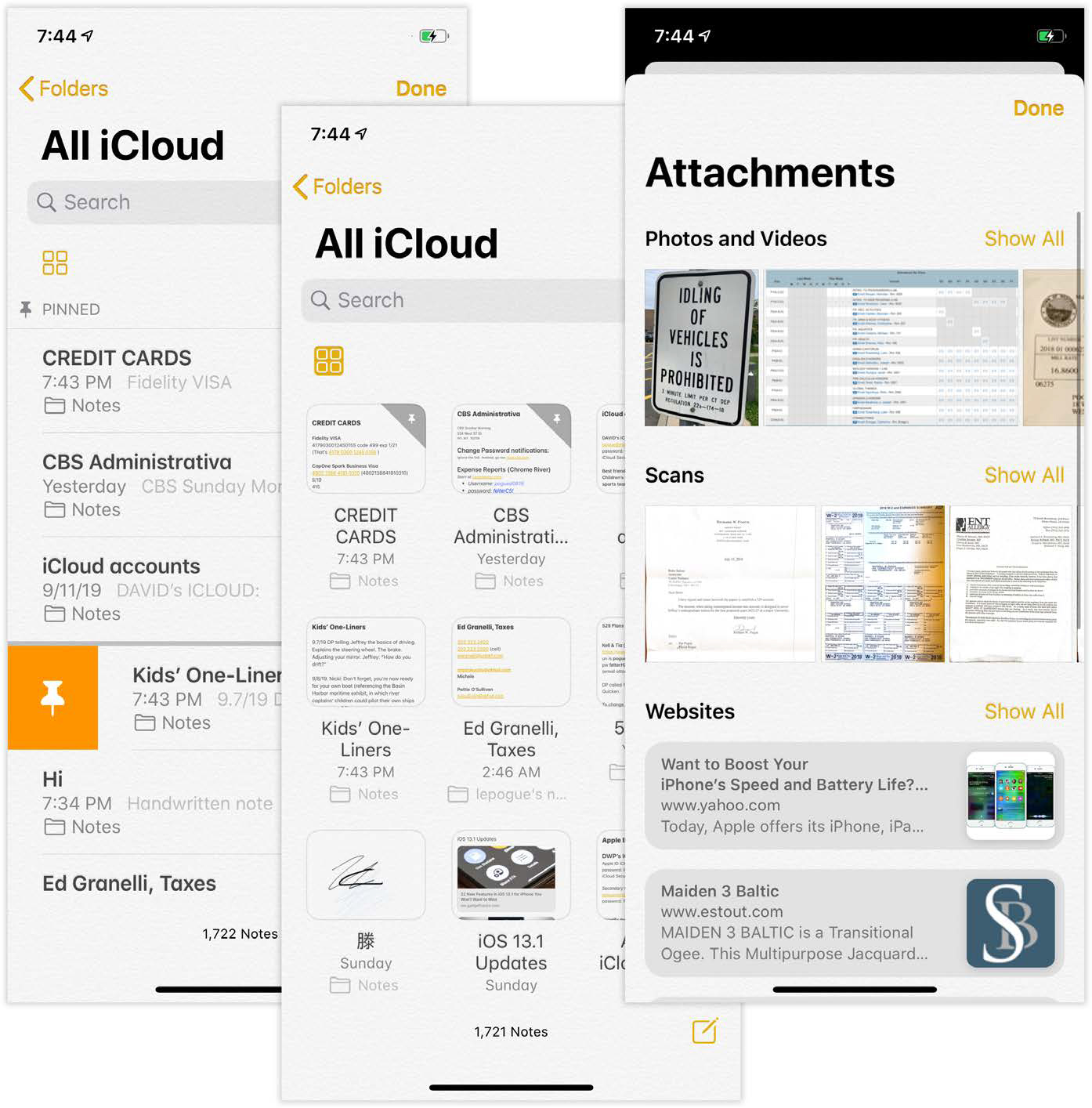
 . This button, too, is hidden until you tug down on the Notes list. Tap it to switch your entire notes collection from a list view to an icon view, revealing miniatures of every single note (above, middle).
. This button, too, is hidden until you tug down on the Notes list. Tap it to switch your entire notes collection from a list view to an icon view, revealing miniatures of every single note (above, middle).The first lines of your notes, along with the time or date you last edited them. If there’s a photo or sketch on a note—an unlocked one, anyway—you see its thumbnail, too. Tiny icons denote locked or shared notes.
To open a note, tap its name. To delete a note, swipe across its name in the list, right to left, and then confirm by tapping
 .
.NOTE
On iPhone Plus and Max models, rotating the phone produces a whole new two-column layout. The left column shows your table of contents (first line of every note); the right column shows the selected note itself.
Pinned notes. Ordinarily, your notes appear chronologically, most recent at the top. But in Settings → Notes, you can specify that they be sorted by Date Edited or Title instead.
But you may have a couple of notes—things you refer to a lot—that you want to appear at the top all the time. Passwords, credit card numbers, or frequent-flyer numbers, for example.
That’s why you can pin notes to the top of the list, where they won’t move. To pin one, swipe to the right (previous page, left); tap
 .
.
Notes Folders
For your organizational and sharing pleasure, Notes lets you create folders to contain batches of notes.
To set them up, tap the ![]() at top left until you arrive at the Folders screen, which displays both your list of accounts (read on) and any folders you’ve created.
at top left until you arrive at the Folders screen, which displays both your list of accounts (read on) and any folders you’ve created.
New Folder does just what you’d think; enter a name and then hit Save. The new folder appears in the list of accounts and other folders.
Whenever you want to move a note into a folder, you have these options:
From an open note, tap
 ; on the Share screen, scroll down and tap Move to Folder.
; on the Share screen, scroll down and tap Move to Folder.In the notes list, swipe left on a note; tap
 .
.To move a batch of notes at once, begin on the Notes list. Tap
 → Select Notes. Select the notes you want to move, and then hit Move All.
→ Select Notes. Select the notes you want to move, and then hit Move All.
In each case, Notes now shows you your list of folders; tap the one you want to be the new destination for your note or notes.
Notes Accounts
Your notes can sync wirelessly and automatically not only to your other Apple gadgets, but also with the Notes modules on Google, Yahoo, AOL, Exchange, or another IMAP email account. To set this up, open Settings → Passwords & Accounts. Tap the account you want (iCloud, Gmail, AOL, or whatever); turn the Notes switch On.
Now your notes are synced nearly instantly, wirelessly, both directions.
NOTE
One catch: Notes that you create at gmail.com, aol.com, or yahoo.com don’t wind up on the phone. Those accounts sync wirelessly in one direction only: from the iPhone to the website, where the notes arrive in a Notes folder. (There’s no problem, however, if you get your AOL or Gmail mail in an email program like Outlook, Entourage, or Apple Mail. Then it’s two-way syncing as usual.)
At this point, a ![]() bracket appears at the top-left corner of the table of contents screen. Tap it to see your note sets from various accounts.
bracket appears at the top-left corner of the table of contents screen. Tap it to see your note sets from various accounts.
If you’ve created Notes folders on your Mac (Mountain Lion or later), then you see those folders here, too.
TIP
In Settings → Notes, you can specify which Notes account you want to be the main, default one for new notes.
All of this makes life a little more complex, of course. For example, when you create a note, you have to worry about which account it’s about to go into. To do that, be sure to specify an account name (and a folder within it, if necessary) before you create the new note.
TIP
In Settings → Notes, you can turn on the “On My Phone” Account. Any notes you add to this “folder” are super-private. They don’t get synced or sent online, ever.
Podcasts
A podcast is a “radio” show that’s distributed online. Lots of podcasts begin life as actual radio and TV shows; most of NPR’s shows are available as podcasts, for example, so you can listen to them whenever and wherever you like.
But thousands more are recorded just for downloading. Some have millions of listeners and make huge money from ads; some have only a handful of fans. One thing’s for sure: There’s a podcast out there that precisely matches whatever weird, narrow interests you have.
The Podcasts app helps you find, subscribe to, organize, and listen to podcasts. It’s designed just like Apple’s online stores for apps, music, movies, and so on. Tap Browse to see recommended podcasts and Top Charts to see what the rest of the world is listening to these days (next page, right). Or use Search to look for something specific.
There are video podcasts, too, although they’re much less common. The most popular are clips from network or cable TV shows, but there are plenty of quirky, offbeat, funny video podcasts that will never be seen except on pocket screens.

In any case, once you’ve drilled down to a particular episode that seems worthy, you can listen to it in either of two ways:
Stream it. Tap
 to play it directly from the internet. It’s never stored on your iPhone and doesn’t take up any space, but it does require an internet connection. Generally not what you want for plane rides.
to play it directly from the internet. It’s never stored on your iPhone and doesn’t take up any space, but it does require an internet connection. Generally not what you want for plane rides.Download it. If you tap
 and then
and then  instead, you download the podcast to your phone. It takes up space there (and podcasts can be big)—but you can play it back anytime, anywhere. And, of course, you can delete it when you’re done.
instead, you download the podcast to your phone. It takes up space there (and podcasts can be big)—but you can play it back anytime, anywhere. And, of course, you can delete it when you’re done.
Subscribing
Most podcasts are series. Their creators crank them out every week or whatever. If you find one you love, subscribe to it so that your phone downloads each new episode automatically. Just tap Subscribe on its details page.
The episodes wind up on the Library screen (facing page, middle), under Shows. Tap a podcast’s icon to open the Episodes screen, where you can find listings for further episodes; controls for deleting an episode or adding it to the playback queue; and links to share this podcast by Messages, Mail, Twitter, Facebook, and so on.
Settings
There’s a lot to control when it comes to podcasts. Do you want new episodes downloaded automatically? Do you want them auto-deleted when you’re finished?
You make these choices in Settings → Podcasts. Those are the global settings for podcasts.
But you can also override them for individual shows. On any podcast’s details screen, tap ![]() and then Settings to see those options and many more. You can limit how many episodes of this show are stored on your phone, specify the playback order—oldest first or newest first, and much more.
and then Settings to see those options and many more. You can limit how many episodes of this show are stored on your phone, specify the playback order—oldest first or newest first, and much more.
Listening
The Podcasts app offers two ways to dive in. The Listen Now tab shows you the next episode of each podcast series—the one you’re up to. The Library tab offers icons for each podcast, so that you can drill down to a particular episode. Tap the playback strip at the bottom to reveal all the usual audio-playback controls (“Playback Controls”)—with the handy addition of a button to toggle the talking speed (½x, 1x, 1½x, or 2x regular speed).
TIP
There are skip-forward and skip-backward buttons here, too. Handy for jumping through ads! The factory setting is 15-second skips per button press, but you can change the interval in Settings → Podcasts → Skip Buttons.
If you press the side button to turn off the screen, the podcast continues playing. And even if the phone is locked, you can open the Control Center (“Control Center”) to access the playback controls.
TIP
Don’t forget to use Siri! You can say things like “Play ‘Fresh Air’ podcast,” “Play my latest podcasts,” “Play my podcast” (to resume your last podcast), “Play the latest TED podcast,” and so on.
Reminders
Reminders not only records your life’s little tasks, but it also reminds you about them at the right time or right place. For example, it can remind you to water the plants as soon as you get home.
Thanks to iCloud, your reminders sync across all your gadgets. Create or check off a task on your iPhone, and you’ll also find it created or checked off on your iPad, iPod Touch, Mac, PC, and so on.
TIP
Reminders sync wirelessly with anything your iCloud account knows about: Calendar or BusyCal on your Mac, Outlook on the PC, and so on.
Siri and Reminders are a match made in heaven. “Remind me to file the Jenkins report when I get to work.” “Remind me to set the TiVo for tonight at 8.” “Remind me about Timmy’s soccer game a week from Saturday.” “When I get home, remind me to take a shower.”
Now, Reminders in iOS 13 does all of that and more—and better, because Apple rewrote the app from scratch, with juicy new features. Unfortunately, you can’t have the new features without upgrading your reminders to the new data format.
And once you convert to the new format, you won’t be able to open them on any other gadgets unless they, too, have iOS 13 (or, on the Mac, macOS Catalina). And you won’t be able to open them in Windows at all (except by logging in to icloud.com). The new Shared Lists feature, too, is available only to people who have likewise upgraded.
When you first open Reminders in iOS 13, you can tap Upgrade Now or Upgrade Later. In the latter case, you can still use Reminders, but without all the cool new features. (You can always upgrade by tapping the big UPGRADE button next to My Lists.)
The Four Smart Lists
The new Reminders app offers four “smart lists” at the top (facing page): one-tap bubbles that show you all the reminders due Today, all the ones you’ve Scheduled for later, all the ones you’ve Flagged as significant, and All. Tap one to open the corresponding list.
My Lists
Below the smart list buttons, it should be clear that you can create more than one to-do list, each with its own name: a groceries list, kids’ chores, a running tally of expenses, and so on. It’s a great way to log what you eat, or to keep a list of movies that people recommend.
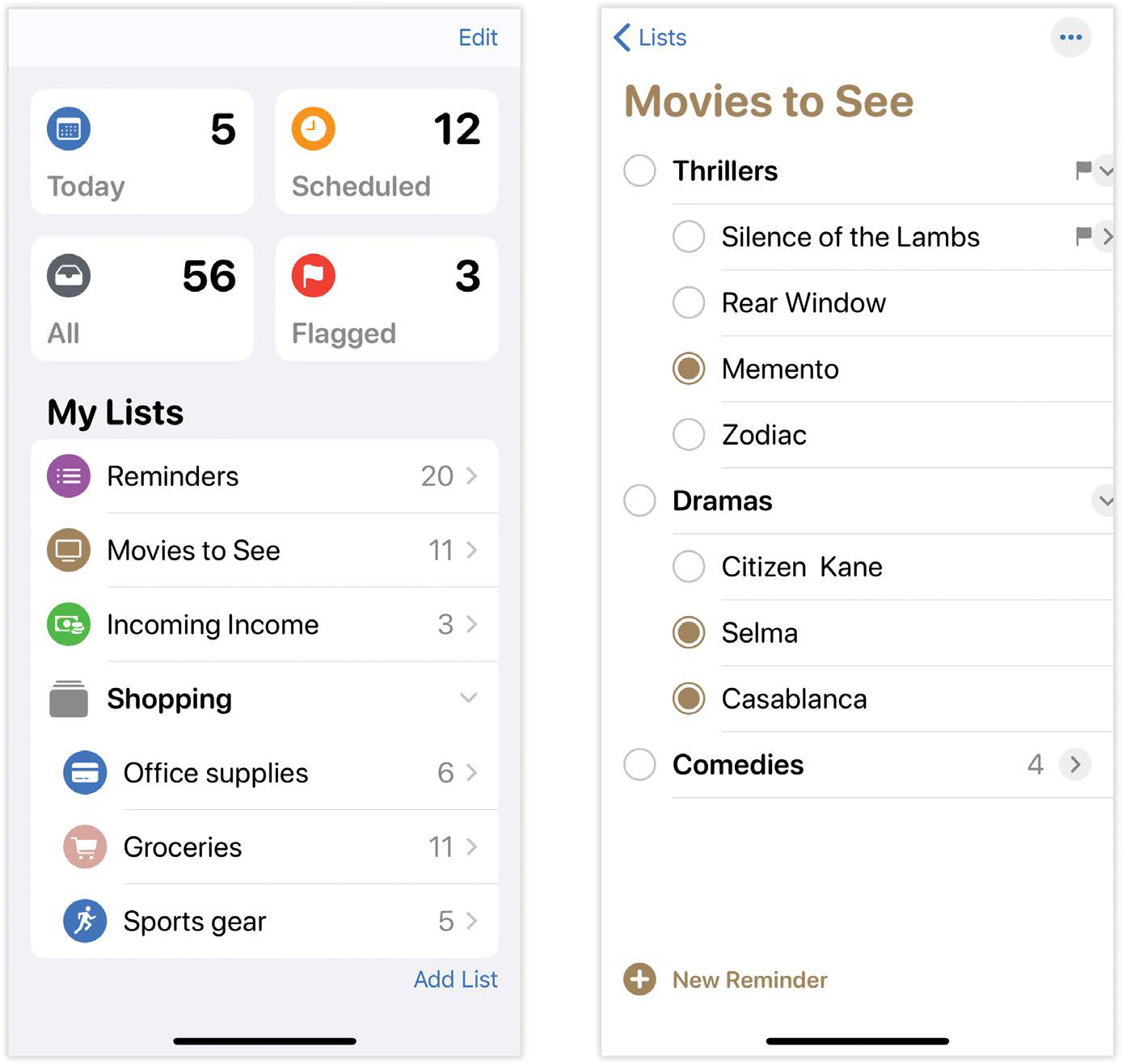
Tap a list’s name to open the to-do list within. Tap ” Lists (or swipe right) to return to the master page.
To create a new list, begin at the list of lists (above, left). Tap Add List. You’re asked to enter a name, choose a color (for the list’s title font and also of the “checked-off” circles once the list is underway), and pick a graphic icon symbol for your new list; then hit Done.
(To delete a list, swipe left across it and then tap ![]() .)
.)
When you’re viewing the list of lists, you can rearrange them by dragging their title bars up or down.
You can also, in iOS 13, group them by dragging one list’s name on top of another; iOS asks you to name the new group. You might, for example, create a group called Shopping (above, left), which contains lists for Groceries, Sports Gear, and Office Supplies. You can expand or collapse the sublist by tapping the little ![]() next to the group’s name.
next to the group’s name.
Creating a Reminder
Once you’ve tapped to open a list, you create a new reminder in any of these ways:
Tap New Reminder. Type your reminder (or dictate it). Feel free to specify dates, times, locations, and repeat schedules: “Remind me to feed the cats every day at 8:30 a.m.” “Print the Wiggins report when I get to work.” “Work out Tuesday and Thursday.” As you can see by the colored text, Reminders correctly recognizes and interprets those where/when phrases.
Tap Done (or tap Return to add another item to the same list).
Use Siri’s “Add” command. You can say, “Add avocados to my Groceries list.” “Add Titanic 2 to my Movies list.” This trick is awesome, because it works no matter what app you’re using on the phone.
TIP
Siri can also find these reminders, saving you a lot of navigation. You can say, “Find my reminder about dosage instructions,” for example.
Use “Remind me about this.” When you’re looking at something in one of Apple’s apps, you can tell Siri, “Remind me about this later.” That might be a text message in Messages, a web page in Safari, an email in Mail, a document in Pages, or whatever. (This command works in Calendar, Clock, Contacts, Books, Health, Mail, Maps, Messages, Notes, Numbers, Pages, Phone, Podcasts, Reminders, and Safari. Software companies can upgrade their apps to work with “Remind me about this,” too.)
Instantly, Siri creates a new item on your main Reminders list—named for the precise message, location, web page, document, or thing you were looking at—complete with the icon of the app you were using.
Later, you can tap that icon to open the original app—to the exact spot you were when you issued the command.
You can also say things like, “Remind me about this tomorrow night at seven” or, “Remind me about this when I get home.”
Put it all together, and you’ve got an effective system for bookmarking your life. Maybe this feature will, once and for all, end the practice of people emailing stuff to themselves just so they’ll remember it.
Create a reminder from another app. You can create a new Reminder from within Messages, Mail, Photos, Maps, and other apps. Once you’ve selected some text (or a photo, or a location, or whatever), hit
 and then tap Reminders. You’re invited to name this new reminder, tap Details to specify a list for it (and assign times, places, priority, and other niceties), and then hit Done. Behind the scenes, you’ve just added that material to a new Reminder.
and then tap Reminders. You’re invited to name this new reminder, tap Details to specify a list for it (and assign times, places, priority, and other niceties), and then hit Done. Behind the scenes, you’ve just added that material to a new Reminder.
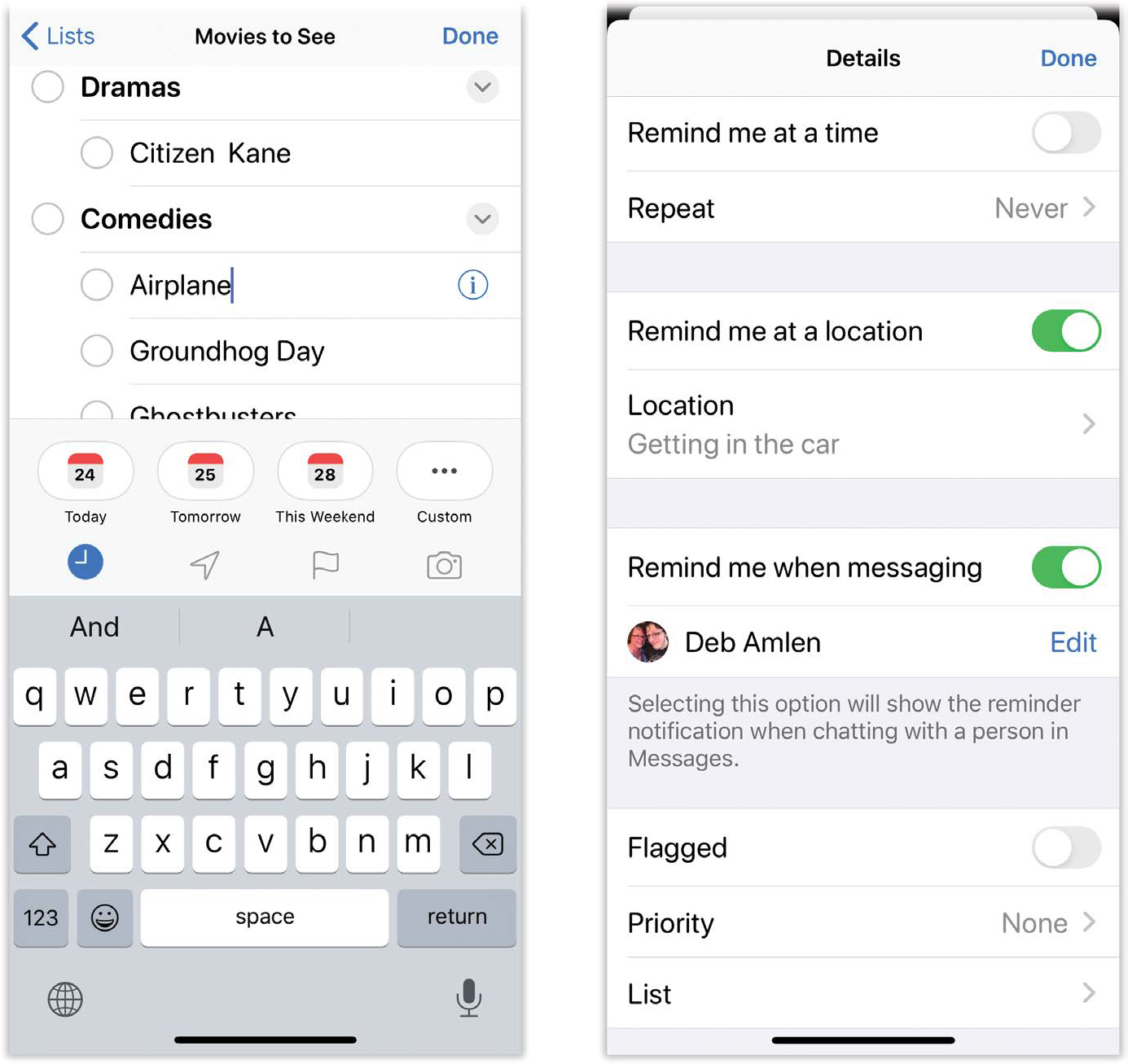
Typing into the Reminders app itself, though, gives a reminder far more power, thanks to the four shortcuts above the keyboard:
 summons buttons (Today, Tomorrow, This Weekend) that schedule this reminder to pop up on a certain date (above, left).
summons buttons (Today, Tomorrow, This Weekend) that schedule this reminder to pop up on a certain date (above, left).If you tap Custom, you open the Details screen, where you can dial up far more precise date-and-time options. Because Remind me on a day is turned on, you can now specify a date when you’ll be reminded; Remind me at a time adds a time-of-day control. Tap Repeat if you want this reminder to appear every day, week, two weeks, month, or year—great for reminding you about things that recur, like quarterly tax payments, haircuts, and anniversaries.
Tap Done when it’s all set up.
 lets you schedule this item to nag you when your phone’s GPS detects that you have reached (or departed from) a certain place, which is a rather amazing feature. You may be offered a button like Getting in Car, but the real magic happens when you hit Custom.
lets you schedule this item to nag you when your phone’s GPS detects that you have reached (or departed from) a certain place, which is a rather amazing feature. You may be offered a button like Getting in Car, but the real magic happens when you hit Custom.The Location page opens, where you can tap Current Location—wherever you are at the moment. That’s handy if, for example, you’re dropping off your dry cleaning and want to remember to pick it up the next time you’re driving by. But you can also choose Home or Work (as you’ve set them up in Contacts). Or you can use the search box at the top, either to enter a street address, or to search your own Contacts list.
NOTE
If you use Bluetooth to pair your phone to your car, you have a couple of other helpful choices: Getting in the car (to get a reminder when the iPhone connects to your car) and Getting out of the car (to get one when it disconnects).
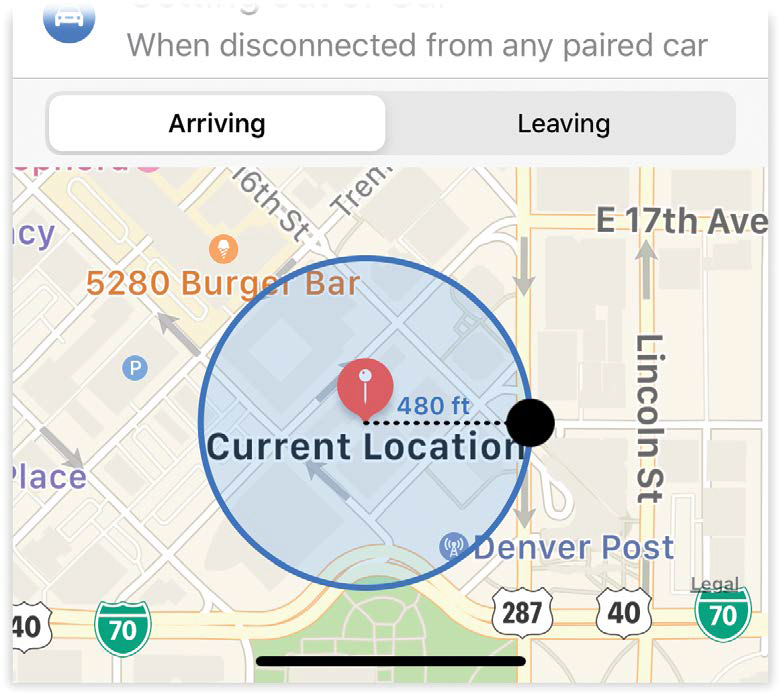
Once you’ve specified an address, the Location screen shows a map. The diameter of the circle shows the area where your presence will trigger the appearance of the reminder on your screen.
TIP
You can adjust the size of this “geofence” by dragging the black handle to adjust the circle. In effect, you’re telling the iPhone how close you have to be to the specified address for the reminder to pop up. You can adjust the circle’s radius anywhere from 328 feet (“Remind me when I’m in that store”) to 1,500 miles (“Remind me when I’m in that country”).
The final step here is to tap either Arriving or Leaving. Later, the phone will remind you as you approach (or leave) the address, which is fairly mind-blowing the first few times it happens.
 lets you flag this reminder. A flag can mean anything you want. It can mean “Front-burner item.” It can mean “I’ve procrastinated on these too long.” It can mean “Items I’m gathering up to put into a single new list for the McGillicuddy project.” All of the flagged Reminders appear, of course, in the Flagged smart list described already.
lets you flag this reminder. A flag can mean anything you want. It can mean “Front-burner item.” It can mean “I’ve procrastinated on these too long.” It can mean “Items I’m gathering up to put into a single new list for the McGillicuddy project.” All of the flagged Reminders appear, of course, in the Flagged smart list described already. offers three buttons, each of which creates an attachment to this reminder: Take Photo, Photo Library, or Scan Document. Chapter 9 offers details about navigating your photo library; “Text and Paragraph Formatting” describes the scanning operation. What’s cool is that a thumbnail image of whatever photo or document you’ve attached appears right in the Reminders list for quick reference—and you can tap to open it full-size.
offers three buttons, each of which creates an attachment to this reminder: Take Photo, Photo Library, or Scan Document. Chapter 9 offers details about navigating your photo library; “Text and Paragraph Formatting” describes the scanning operation. What’s cool is that a thumbnail image of whatever photo or document you’ve attached appears right in the Reminders list for quick reference—and you can tap to open it full-size.
The Details Screen
The four icons above the keyboard are only shortcuts to the more complete Details screen, which appears when you tap ![]() next to an item’s name (“The Details Screen”, left). These offer the same options as those four icons, but with more detailed details. For example:
next to an item’s name (“The Details Screen”, left). These offer the same options as those four icons, but with more detailed details. For example:
Notes. Here’s a handy box where you can record freehand notes about this item: an address, a phone number, details of any kind.
URL stores any web address you want to associate with this item.
Remind me on a day. You already know how this works—but on the Details screen, you can also choose an Alarm sound for this reminder’s appearance.
Remind me at a location. You’ve read about this one, too; tap Location to specify where you want to be reminded.
Remind me when messaging is new in iOS 13, and super-useful. Turn it on, hit Choose Person, and select somebody’s name from Contacts. The idea is that when you next begin chatting with this person in Messages, a reminder will pop up right there.
Think of this option every time you’re turning out the light and say to yourself something like, “Dang, I forgot to remind Casey to pay me back that $75.”
Flagged. As described already.
Priority. Tap to specify whether this item has low, medium, or high priority—or None. In some of the calendar programs that sync with Reminders, you can sort your task list by priority.
List. Tap to assign this to-do to a different reminder list, if necessary.
Subtasks, new in iOS 13, are to-do items within a to-do item. The main Reminder might be “Prep for the in-laws’ visit,” and the indented subtasks might be “Mow lawn,” “Paint house,” and “Retile roof.”
One way to create a subtask is to tap Subtask, tap Add Reminder, and then enter the new to-do item. When you return to the list, you’ll see that the main reminder (“Prep for in-laws’ visit”) bears a little collapse-o-button (
 ) that hides or shows the subtasks.
) that hides or shows the subtasks.When you’re looking at a list of reminders, though, there’s a much faster way to nest items: Hold your finger down on item B for half a second, and then drag it down under item A’s name. It indents itself nicely.
TIP
You can also drag a list item to the right and then tap Indent.
To exit the Details screen, tap Done.
Checking Off Reminders
As you go through life being productive, you’re supposed to tap the little circle next to each item in Reminders that you’ve completed. A checked-off to-do remains in place until the next time you visit its list. At that point, it disappears to a separate list called Completed.
If you ever want to take pride in how much you’ve accomplished, tap ![]() → Show Completed to bring your checked-off tasks back into view. (The same menu then offers a Hide Completed command.)
→ Show Completed to bring your checked-off tasks back into view. (The same menu then offers a Hide Completed command.)
Other stuff you can do:
Delete a to-do item altogether, as though it never existed. Swipe leftward across its name; tap Delete to confirm.
Delete a bunch of items in a row. Tap
 → Select Reminders. Tap each little circle, and then tap Delete to eliminate them all at once.
→ Select Reminders. Tap each little circle, and then tap Delete to eliminate them all at once.Rearrange the list items. Hold down your finger on an item briefly, and then drag it up or down the list.
Sharing Lists
You can share your to-do lists with other people electronically, just as you can with notes—a great way for you to share a list of chores with your kids, a wedding-gift registry with your guests, a shopping list with your partner, and so on.
Tap ![]() → Add People. On the Add People screen, specify how you want to share the list (by Messages, Mail, or whatever). Address the invitation, and off you go.
→ Add People. On the Add People screen, specify how you want to share the list (by Messages, Mail, or whatever). Address the invitation, and off you go.
Once the recipient receives your invitation, you’ll both see the progress as you edit and check off To Do items on the shared list.
Stocks
This one’s for you, big-time day trader. The Stocks app tracks the rise and fall of your portfolio by downloading the very latest stock prices.
(All right, maybe not the very latest. The price data may be delayed as much as 20 minutes, which is typical of free stock-info services.)
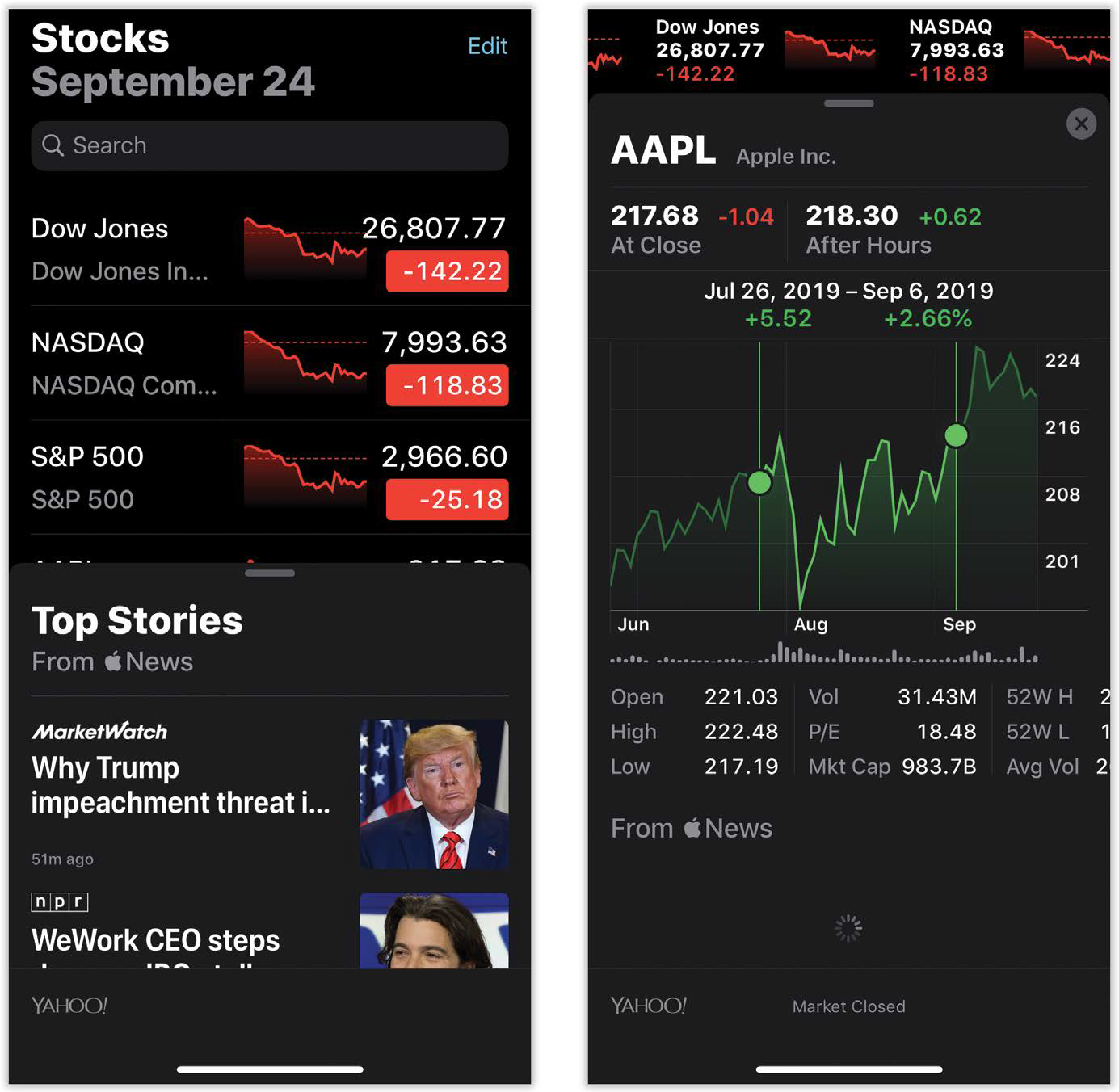
When you first fire it up (and hit Continue to pass the welcome screen), Stocks shows you a handful of sample securities and indexes—the Dow Jones Industrial Average, the NASDAQ Composite Index, the S&P 500 Index, Apple, Google, and Facebook, for example (previous page, left).
Next to each, you see a tiny spark graph (a miniature of today’s price fluctuations), its current share price, and beneath that, how much that price has gone up or down today. As a handy visual gauge to how elated or depressed you should be, this final number appears on a green background if it’s gone up or a red one if it’s gone down. Tap this number to cycle the display from a percentage to a dollar amount to current market capitalization (“120.3B,” meaning $120.3 billion in total corporate value).
When you tap a stock, the bottom part of the screen zooms in for the details on that company (previous page, right). Drag up or down to make this details pane bigger, smaller, or scrolled. Here’s what it contains:
A table of statistics. A capsule summary of today’s price and volume statistics for this stock.
A graph of the stock’s price. It starts out showing you the graph of today’s fluctuations. But by tapping the scrolling list of headings above the chart, you can zoom in or out, from one day (1D) to ten years (10Y) or even ALL the years in its existence, with many other increments in between.
TIP
Drag a finger across the graph to see the readout for a certain day. Or pinch with two fingers (or two thumbs) to isolate a certain time period; a pop-up label shows you how much of a bath you took (or how much of a windfall you received) during the interval you highlighted (previous page, right). Cool!
An assortment of relevant headlines, brought to you by the News app (“The Level”) and, if you subscribe, the News+ service (“Notes”). Tap a headline to read the article. (If you have a 3D Touch phone [“Charging the iPhone”], you can peek at the underlying story without leaving the main screen by long-pressing the headline.)
Tap the ![]() at the top right of the details panel to close it.
at the top right of the details panel to close it.
NOTE
The Stocks app no longer displays a different view when you rotate the phone 90 degrees. It’s all upright, all the time.
Customizing Your Portfolio
It’s fairly unlikely that your stock portfolio contains just Apple, Google, and Facebook. Fortunately, you can customize the list of stocks to reflect the companies you do own (or want to track).
To edit the list, tap Edit. You arrive at the editing screen, where these choices await:
Delete a stock by tapping
 and then Remove.
and then Remove.Rearrange the list by dragging the grip strips (
 ) on the right side.
) on the right side.Add a stock by tapping
 ; the Add Stock screen and the keyboard appear.
; the Add Stock screen and the keyboard appear.You’re not expected to know every stock-symbol abbreviation. Type the company’s name into the search bar at top. The iPhone shows a list of company-name matches. Tap one you want to track and then its Add button. Tap
 to return to the stocks-list editing screen.
to return to the stocks-list editing screen.
When you’re finished setting up your stock list, tap Done.
Tips
This app (in your Extras folder) is designed to show you tips and tricks for getting the most from your iPhone. Each Collection (What’s New, Genius Picks, and so on) screen offers a set of tips—a paragraph of text apiece—explaining one of iOS’s marvels. Swipe leftward to see the next tip, and the next, and the next.
It’s not exactly, you know, a handsome, printed book. But it’s something.
Voice Memos
This audio app (probably in your Extras folder) is ideal for recording lectures, musical performances, notes to self, and cute child utterances (next page, left). The microphone is incredibly good, even from a distance. You can edit the recordings, and even sync them to your Mac.
NOTE
If your Mac doesn’t have macOS Mojave or later, then it doesn’t have the Mac version of Voice Memos. In that case, you’ll have to sync your recordings to the Mac as described in “All About Syncing”. You’ll find them in the iTunes folder called Voice Memos.
Making the Recording
Tap ![]() (or click your earbud clicker) to start recording. A little ding signals the start (and stop) of the session—unless you’ve flipped the phone’s silencer switch (you sneak!).
(or click your earbud clicker) to start recording. A little ding signals the start (and stop) of the session—unless you’ve flipped the phone’s silencer switch (you sneak!).
You get to watch the actual sound waves as the recording proceeds.
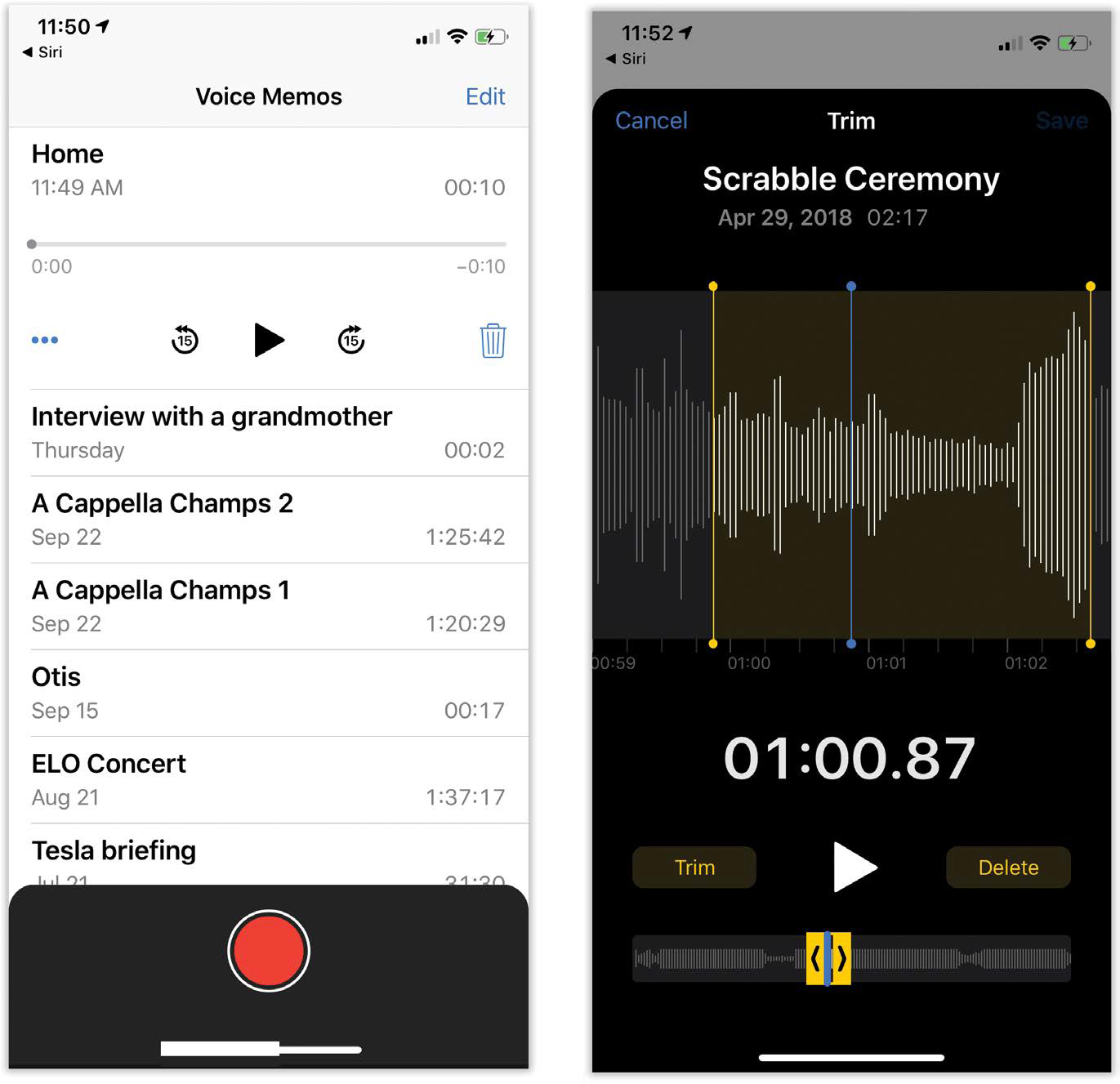
You can switch out of the app to do other work, if you like; a red banner across the top of the screen (or, on the Face ID phones, the left ear) reminds you that you’re still recording. You can even switch the screen off; the recording goes on!
You can make very long recordings with this thing. Let it run all day, if you like. Even your most long-winded friends can be immortalized.
To pause the recording, swipe up on the recording panel; tap ![]() .
.
At this point, Voice Memos offers you the ability to listen to what you’ve got so far, and even record over sections of it! In essence, you’ve just entered Edit mode. It’s described in “Editing Your Recording”.
TIP
The built-in mike records in mono. But you can record in stereo if you connect a stereo mike (to the headphone jack or charging jack).
Press Stop (![]() ) when the recording session is over. The phone names your recording after your location (if Location Services is turned on for Voice Memos in Settings → Privacy), but you can rename it easily enough: Double-tap the temporary name and then type something better: “Baby’s First Words,” “Orch Concert,” whatever. Tap return on the keyboard or anywhere on the screen to finish.
) when the recording session is over. The phone names your recording after your location (if Location Services is turned on for Voice Memos in Settings → Privacy), but you can rename it easily enough: Double-tap the temporary name and then type something better: “Baby’s First Words,” “Orch Concert,” whatever. Tap return on the keyboard or anywhere on the screen to finish.
Playback
When you tap a recording in the list, a convenient set of controls appears. (They look a lot like the ones that appear when you tap a voicemail message in the Phone app.)
TIP
If you have a large enough iPhone model, you can turn the screen 90 degrees—and see both the list of recordings and the editing screen, in two columns.
Here’s what you can do here:
[Recording name]. Double-tap the name to edit or rename it.
 . Tap to play the recording. You can pause with the
. Tap to play the recording. You can pause with the  button.
button.Rewind, Fast Forward. Drag the little dot in the scrubber bar to skip backward or forward in the recording. It’s a great way to skip over the boring pleasantries. Or tap the
 or
or  buttons to jump back or forward by 15 seconds.
buttons to jump back or forward by 15 seconds. . The three dots here open a pop-up menu containing some useful commands. They include Edit Recording (described in the next section), Duplicate (makes a copy), Share (opens the standard Share sheet, for sending this recording to someone else), and Save to Dropbox and Save to Files (for transferring the full-quality recording into an internet transfer bucket that you can later access on your computer).
. The three dots here open a pop-up menu containing some useful commands. They include Edit Recording (described in the next section), Duplicate (makes a copy), Share (opens the standard Share sheet, for sending this recording to someone else), and Save to Dropbox and Save to Files (for transferring the full-quality recording into an internet transfer bucket that you can later access on your computer). . Tap to get rid of a recording. You’re not asked for confirmation, but a message appears, letting you know that the deleted recording will sit in the Recently Deleted folder for 30 days.
. Tap to get rid of a recording. You’re not asked for confirmation, but a message appears, letting you know that the deleted recording will sit in the Recently Deleted folder for 30 days.To see these recordings-on-death-row, tap Recently Deleted. When you tap a recording in that list, you can choose to Recover it or Erase it before the 30 days is up.
TIP
In Settings → Voice Memos → Clear Deleted, you can specify how quickly these deleted recordings disappear. Your choices are Immediately, After 1 Day, After 7 Days, After 30 Days, or Never.
 . Tap to open the standard Share sheet. It gives you the chance to send your recording to someone else by AirDrop, email, or MMS.
. Tap to open the standard Share sheet. It gives you the chance to send your recording to someone else by AirDrop, email, or MMS.
Editing Your Recording
You might not guess that such a tiny, self-effacing app actually offers some basic editing functions, but it does. Tap a recording, then the ![]() button, and then tap Edit Recording.
button, and then tap Edit Recording.
Here you have these options:
Navigate by dragging the sound-wave map horizontally, or tap the
 or
or  buttons to jump in 15-second increments.
buttons to jump in 15-second increments.Record over it. When the blue playhead line is parked at the beginning or middle of the audio, the big red button says Replace. Tap it to record over part (or all) of your original recording. If you recorded a brilliant speech, but stumbled on the opening line (or any line, actually), you can replace it without having to redo the whole thing. Be nimble with the Replace and
 buttons; you can “punch in,” replacing certain parts of the recording without disturbing the rest.
buttons; you can “punch in,” replacing certain parts of the recording without disturbing the rest.Add onto it. You can also add on more audio to your existing recording. Just park the blue playhead line at the end of the current sound waves, and then hit Resume. Hit
 to stop.
to stop.Trim it. You can trim off the beginning or end of your audio clip—which is great, since that’s where you’ll usually find “dead air” or microphone fumbling before the good stuff starts playing.
To do that, tap the Crop button (
 ). At this point, the “map” of the entire sound recording (at the bottom of the screen) sprouts yellow crop handles. Drag them inward to isolate the part you want to keep. When you’re close, use the magnified area at top to fine-tune the trip points, using the vertical yellow lines. Play the sound as necessary to guide you (
). At this point, the “map” of the entire sound recording (at the bottom of the screen) sprouts yellow crop handles. Drag them inward to isolate the part you want to keep. When you’re close, use the magnified area at top to fine-tune the trip points, using the vertical yellow lines. Play the sound as necessary to guide you ( ).
).Tap Trim to shave away everything outside your selected area. If you like the results, tap Save. If you’d rather try again, shake the phone; in the Undo Trim box, tap Undo. Or hit Cancel to forget the whole thing.
Cut out a chunk. To cut something out of the middle, isolate the undesired audio using the crop and trim handles as described already. This time, though, hit the Delete button. You’ve just chopped the selection out of the middle.
Here again, you can hit Save (to preserve the edit), shake the phone and hit Undo Delete (to try again), or Cancel to back out of the entire operation.
TIP
In iOS 13, you can spread or pinch two fingers to zoom in or out of your waveforms as you edit. Slick!
The beauty of all this, by the way, is that your audio recordings can now magically and wirelessly appear on all your other Apple machinery, just as though they were calendar appointments or Safari bookmarks. The on/off switch for this syncing is in Settings → [your name] → iCloud → Voice Memos.
Wallet
This app is designed to store, in one place, every form of ticket that uses a bar code. For most people, that means airline boarding passes, but Wallet also works with apps like Fandango (movie tickets), Starbucks, Walgreens, Ticketmaster, and Major League Baseball. Wallet holds down a second job, too: It’s the key to Apple Pay, described in “Apple Pay”.
TIP
You can rearrange the items in Wallet; just hold still briefly before you start moving your finger up or down. (That order syncs to your other iOS gadgets, for what it’s worth.)
What’s cool is that Wallet uses both its own clock and GPS to know when the time and place are right. For example, when you arrive at the airport, a notification appears on your Lock screen. Each time you have to show your boarding pass as you work through the stages of airport security, you can wake your phone and swipe across that notification; your boarding-pass bar code appears instantly. You’re spared having to unlock your phone (enter its password), hunt for the airline app, log in, and fiddle your way to the boarding pass.
TIP
At the very bottom of the Wallet screen, the Edit Passes button awaits. It gives you a list of tickets for quick deletion—a good way to purge boarding passes you’ve already used—as well as a Find Apps for Wallet button.
In some Wallet-compatible apps, you’re supposed to open the app to view the bar code first and put it into Wallet from there. For example, in most airline apps, you call up the boarding pass and then tap Add.
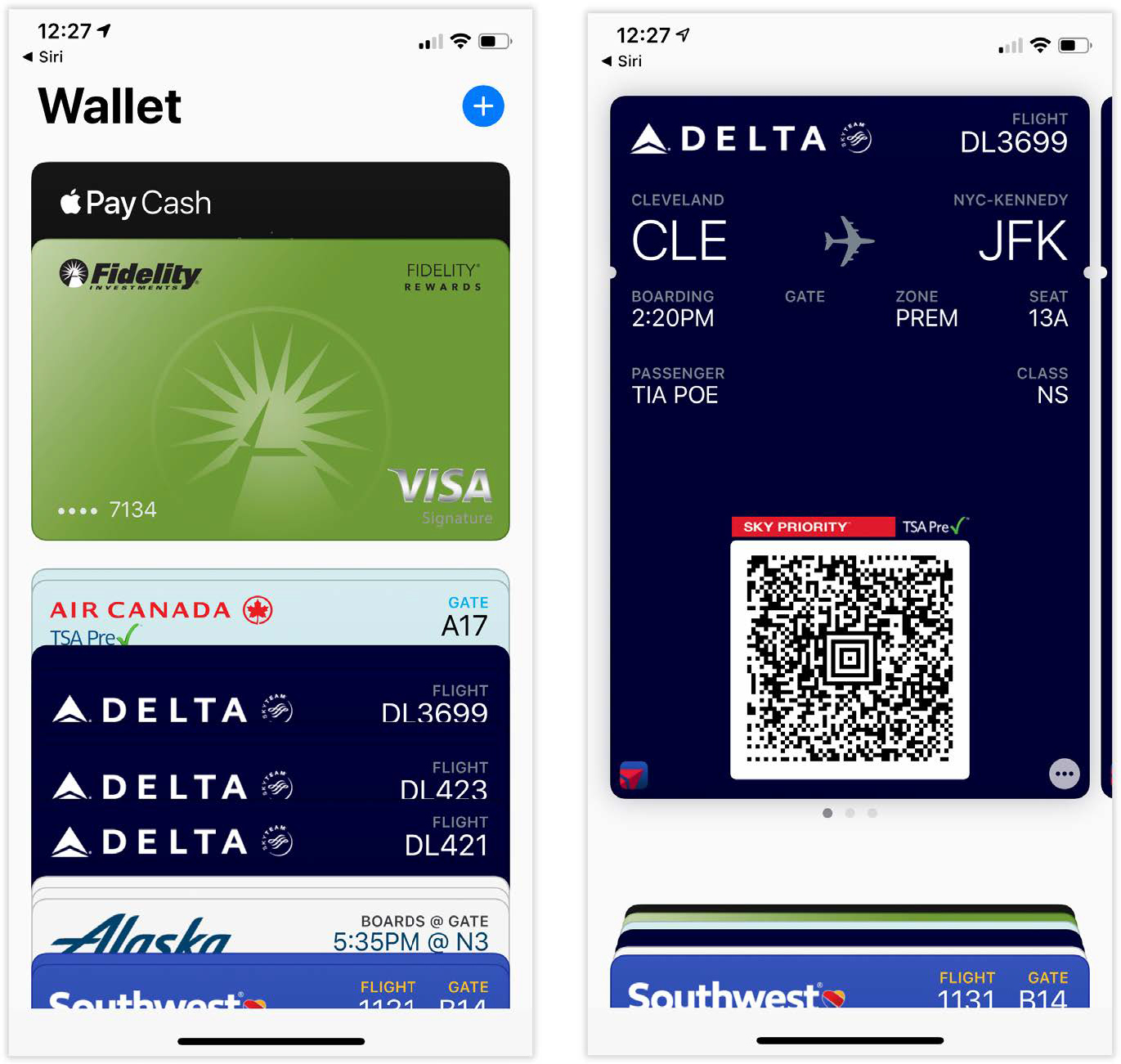
Wallet can also accommodate the student IDs from a few lucky colleges. The phone can provide access to the dorm, library, parties, and so on—or pay for laundry, snacks, and dinners.
Once your bar codes have successfully landed in Wallet, the rest is pure fun. When you arrive at the theater or stadium or airport, the Lock screen displays an alert. Swipe it to open the bar code in Wallet. You can put the entire phone under the ticket-taker’s scanner.
Tap ![]() in the corner to read the details—and to delete a ticket after you’ve used it (tap Remove Pass). That details screen also offers a Show On Lock Screen on/off switch, in case you don’t want Wallet to hand you your ticket as you arrive.
in the corner to read the details—and to delete a ticket after you’ve used it (tap Remove Pass). That details screen also offers a Show On Lock Screen on/off switch, in case you don’t want Wallet to hand you your ticket as you arrive.
Finally, Wallet is one of the two places you can enter your credit card information for Apple Pay on an iPhone 6 or later model, as described in “Apple Pay”. (Settings is the other.)
Watch
If you own an Apple Watch, you use this little app to set up its settings. (OK, big app—there are 90 screens of settings!) So why do you have the Watch app on your phone even if you don’t have an Apple Watch? You’ll have to ask someone in Marketing.
If it bugs you, you can get rid of it (“Deleting Apps”).
Weather
This app shows current conditions for your city (or any other city). The weather display is animated: Clouds drift by, rain falls gently. If it’s nighttime in the city you’re looking up, you might see a beautiful starscape.
The current temperature is shown nice and big; the table below it shows the cloud-versus-sun forecast, as well as the high and low temperatures. In major cities, you even see an alert about today’s air quality—handy if you have asthma or just aren’t a fan of pollution.
You don’t even have to tell the app what city you want; it uses your location and assumes you want the local weather forecast.
There are three places you can tap or swipe:
Swipe up to see a table of stats: humidity, chance of rain, sunrise time, wind speed, “feels like” (chill or heat index), and so on.
Swipe horizontally across the hourly forecast to scroll later in the day.
Swipe horizontally anywhere else to view the weather for other cities (if you’ve set them up). The tiny dots beneath the display correspond to the cities you’ve set up—and the white bold one indicates where you are in the sequence.
TIP
The dots are really tiny. Don’t try to aim for a specific one—it’s a lot easier to tap the row of dots on either the right or left side to move backward or forward among the cities.
The first city—the screen at far left—is always the city you’re in now.
The City List
It’s easy to get the weather for other cities—great if you’re going to be traveling, or if you’re wondering how life is for distant relations.
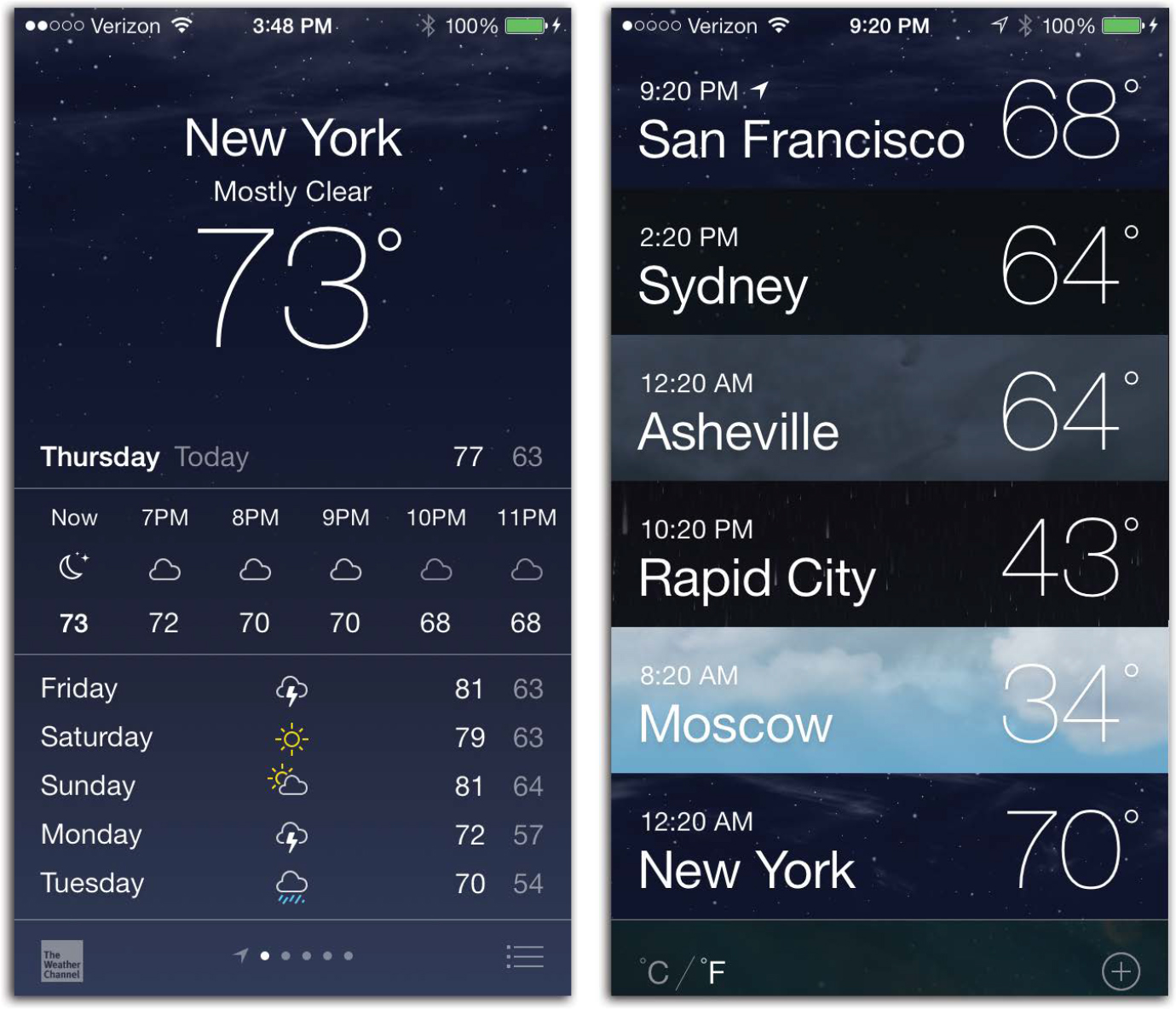
When you tap ![]() at lower right (or pinch with two fingers), the screen collapses into a list of your preprogrammed cities (above, right).
at lower right (or pinch with two fingers), the screen collapses into a list of your preprogrammed cities (above, right).
You can tap one to open its weather screen. You can delete one by swiping leftward across it (and then tapping Delete). You can drag them into a new order (long-press before dragging).
Or you can tap ![]() to enter a new city, using its name, zip code, or airport abbreviation (like JFK for John F. Kennedy airport). Tap Search, and then tap the city. When you return to the configuration screen, you can choose degrees Celsius or Fahrenheit.
to enter a new city, using its name, zip code, or airport abbreviation (like JFK for John F. Kennedy airport). Tap Search, and then tap the city. When you return to the configuration screen, you can choose degrees Celsius or Fahrenheit.
The Weather Channel icon at the bottom opens Safari browser, which loads itself with an information page about that city from weather.com.
If you’ve added more than one city to the list, by the way, just swipe to flip through the weather screens for the cities.
More Standard Apps
This book describes every app that comes on every iPhone. But Apple has another suite of useful programs for you. And they’re free.
NOTE
If you have an iPhone model with 64 or more gigabytes of storage, then most of these apps come already installed.
To find them, search the App Store app for these goodies:
Pages, Numbers, and Keynote are, believe it or not, phone-sized versions of Apple’s word-processing, spreadsheet, and slideshow apps.
iMovie for iPhone is, yes, a video-editing program on your phone, with all the basics: rearranging clips; adding music, crossfades, and credits.
Clips is an ingenious video-recording app. It records when you’re pressing the Record button, and stops when you’re not—so you can make videos composed of multiple shots. It can replace your background, green-screen style, in real time with (for example) an artsy linescape or the bridge of the Millennium Falcon, and so on.
GarageBand is a pocket music studio.
iTunes U is a catalog of 600,000 free courses by professors at colleges, museums, and libraries all over the world. The app lets you browse the catalog, and watch and read the course materials.
